Here is a link to my film: Miles of bonding
In conclusion I think that my film worked out well. It entails everything I wanted it too about the concept and ideas of a union. Linking to the works of Jim Goldberg by creating a short informal film.
Here is a link to my film: Miles of bonding
In conclusion I think that my film worked out well. It entails everything I wanted it too about the concept and ideas of a union. Linking to the works of Jim Goldberg by creating a short informal film.
Plan-
Step 1 :
I created Iphone Video Folder within my media drive, and within my photography folder, Within this folder I have the video’s I have filmed on the camera, the ones off my phone, the title and the actual saved project. Therefore I had to ensure that all my files were kept neatly otherwise I may loose track of things, and my premiere file may corrupt due to not being able to locate certain videos.


Step 2:
I then created the initial premiere pro file, so that I could start importing files and creating my short documentary. I made sure to save this initially so that there were no files problems.
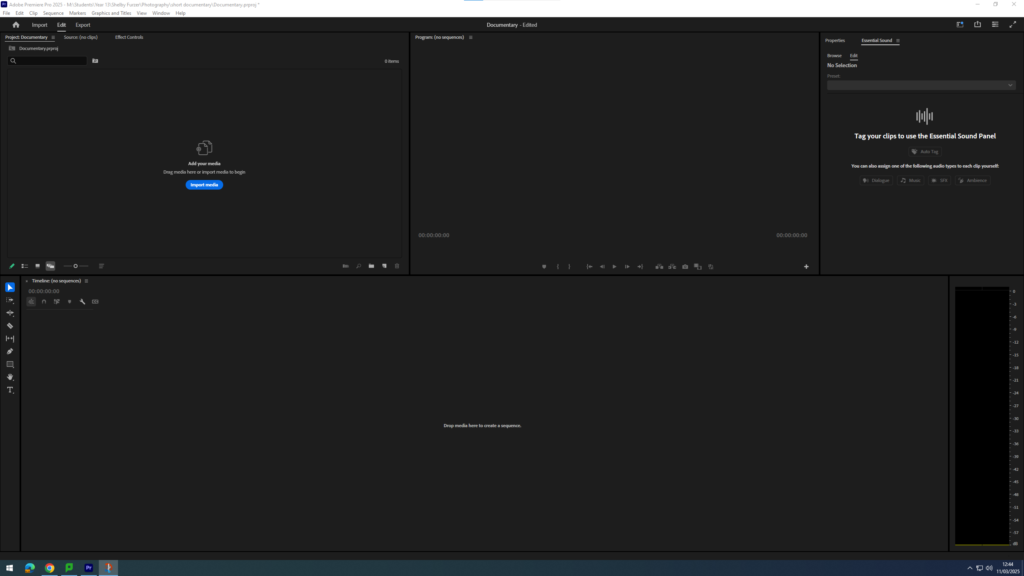
Step 3:
After creating the original premier project I was able to start importing my videos, at this point I only had videos I had filmed on my Iphone therefore the structure of the video itself seemed to be in a portrait position, but I knew that this would change to a wide screen landscape once I started adding video’s from the camera.
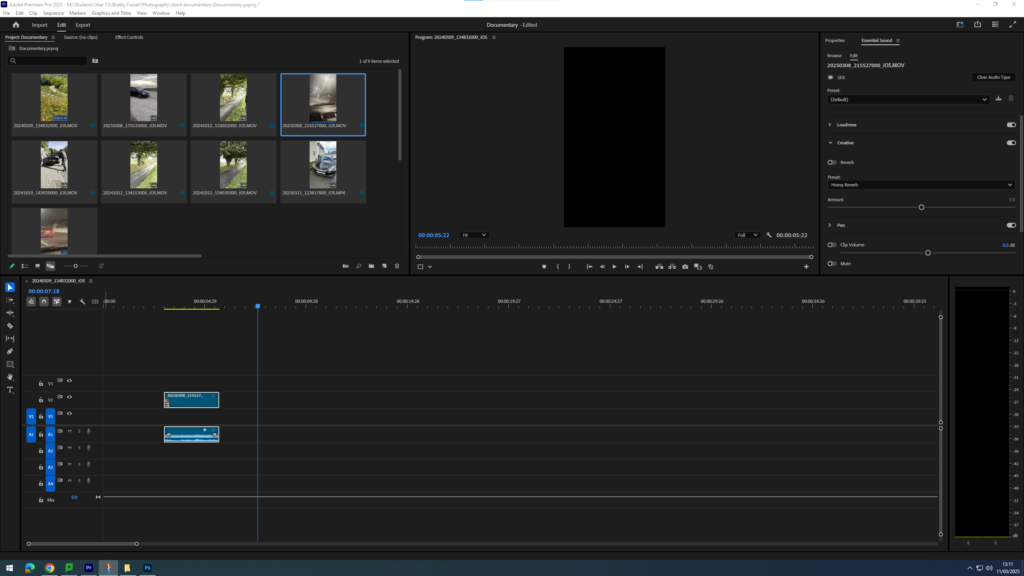
Step 4:
I then came up with some mockup titles, and finally decided on one.
‘Miles Of Bonding’
After deciding on this I had to go into photoshop and create this as a file, by adding my words into a text box on a blank screen, I then had to make sure the background was transparent, otherwise it wouldn’t have looked very good within my video. I also did some research on fonts and finally decided on ‘Magneto’ as I had seen this font used within some different race car magazines.


Step 5:
I then imported my title into my premier project, which then sorted out my video alignment to be landscape rather than portrait. I also added a fade into my title, so that after a few seconds it fade completely into black whilst my first clip fades from 0% opaqueness into 100%.
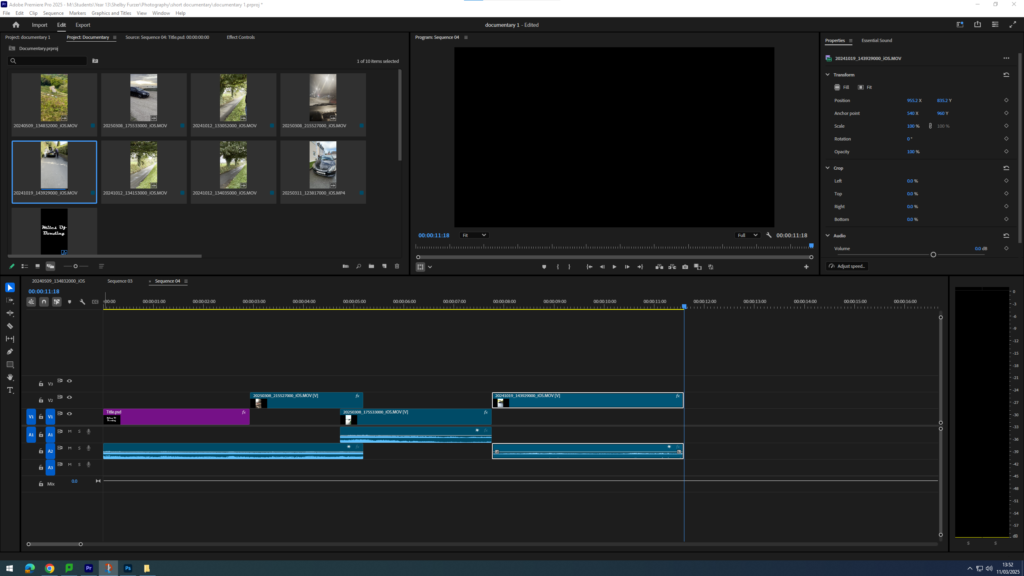
Step 6:
After reviewing my video I realised that due to my videos being filmed on my Iphone they were quite glitchy and slow, with low resolution and the audio not adding up to the videos. I did some research about how to fix this problem, and after watching some youtube videos I came to the conclusion that I would have to save each of my Iphone videos as their own premiere pro project, and then re import them.
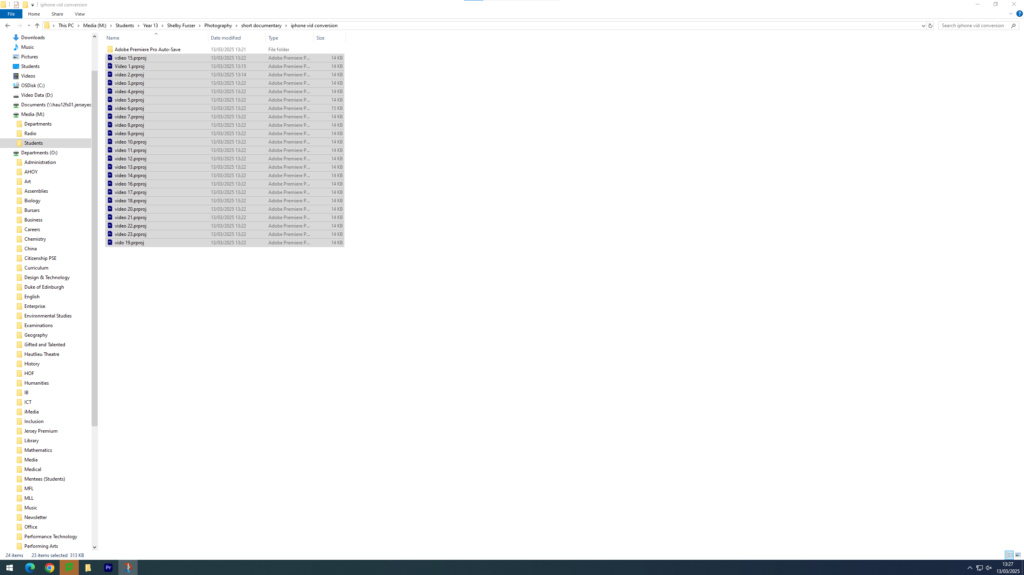
Step 7:
After fixing that small issue I could start on the base of my video. By adding my initial clips to the title, I wanted my video to start off dark to match the aesthetic of my behind the scenes book which also starts off dark.
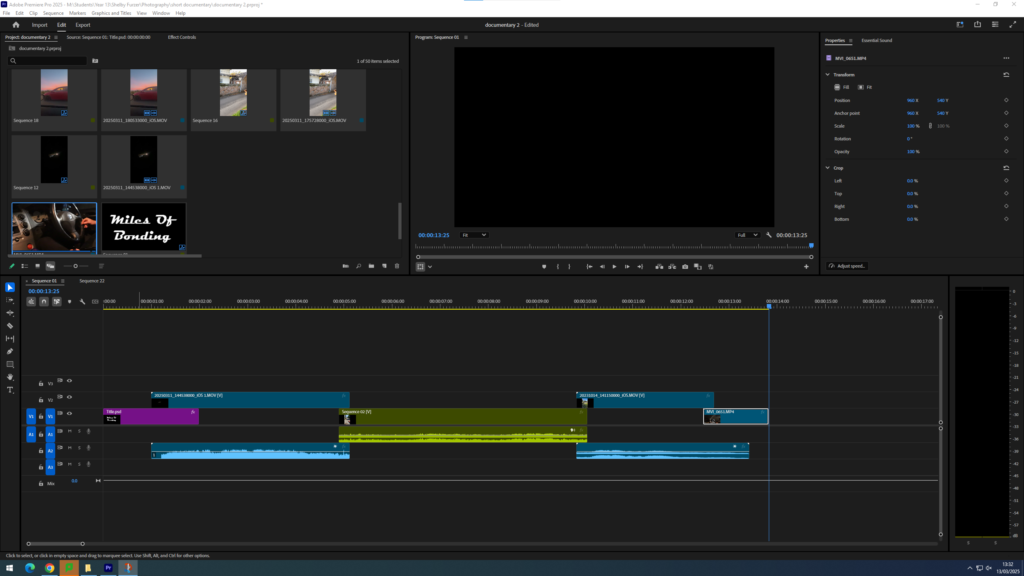
Step 8:
I then finished adding my initial clips that I wanted to be in the video before my first part of my first interview.
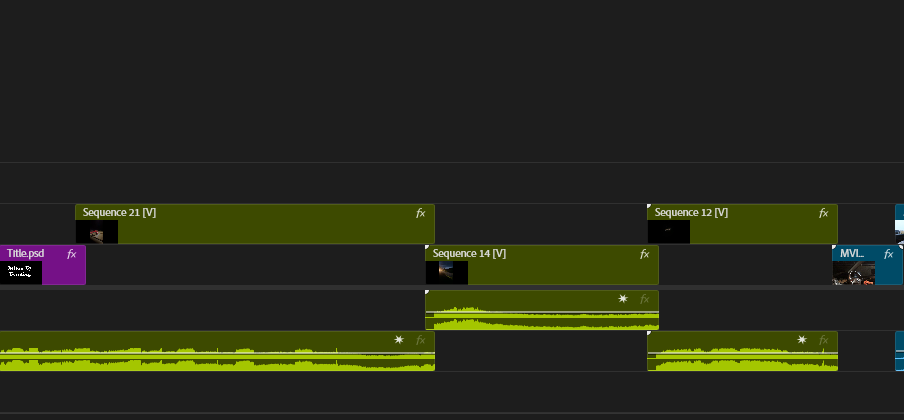
Step 9:
After adding them all in, I started experimenting and playing around with them to see which ones would fit best, I knew that I wanted a big entrance therefore used the clip with the flame as my first clip.
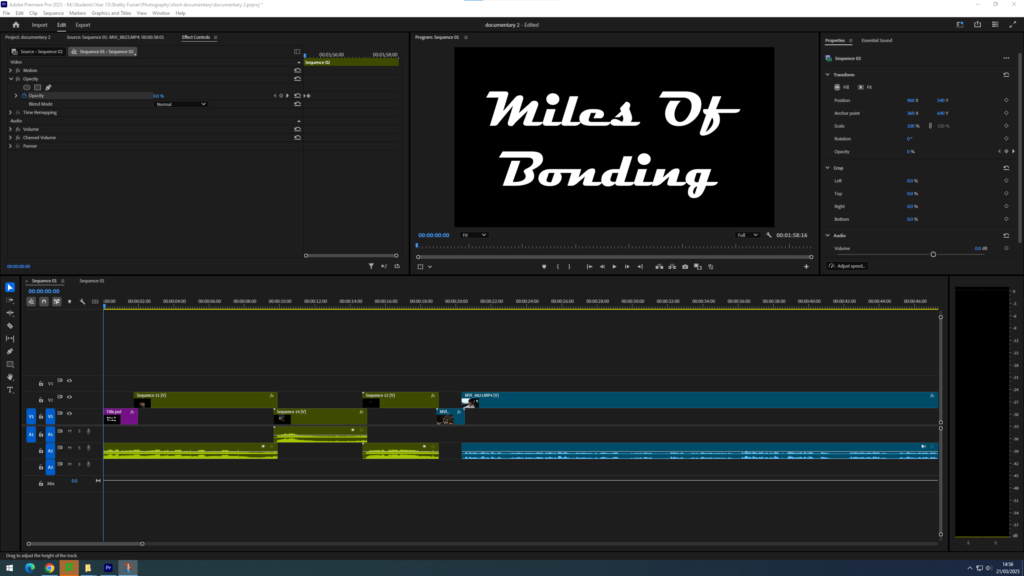
Step 10:
After reviewing my iphone clips I came to the realisation that my video was starting off way too dark so I tried to incorporate some lighter footage at the start which I think really helped to build my intro. I did this through experimentation with trying different clips.
Clips –
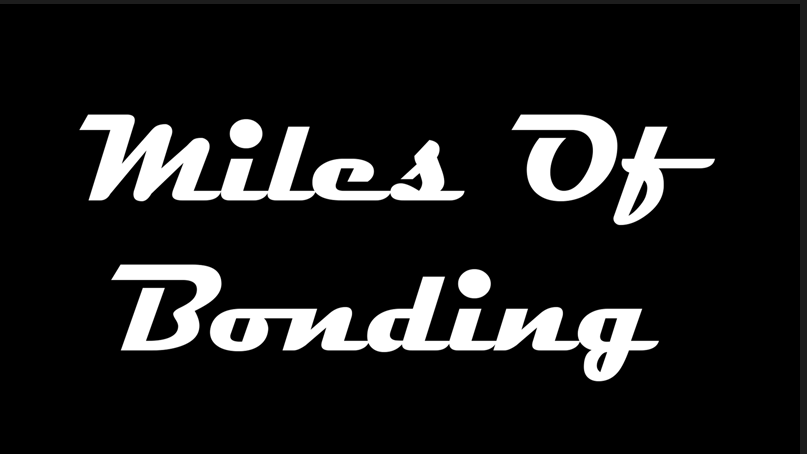

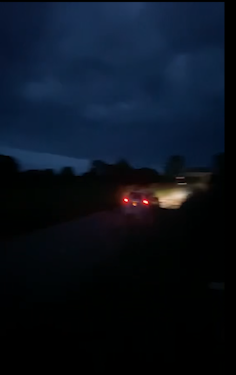

Step 11:
I knew that I needed a sort of fade into video before my interview so I added a short clip with no sound and not a lot of movement to create this blending effect.

Step 12:
I then added the first half of my interview one, due to having a lot of footage in the same place of pure dialogue I have split them up with scenes of the interviewee in his car and other clips of cars. The main reason why I did this is because I didn’t want to have very long clips of pure dialogue as I feel people would get bored of this, and I wanted to keep attention.

Step 13:
I then added in the clips that I wanted between part one of my first interview and part two of my second interview. I made sure to keep these clips short and snappy as I wanted to gain the viewer’s attention back after that long interview clip.

Clips –
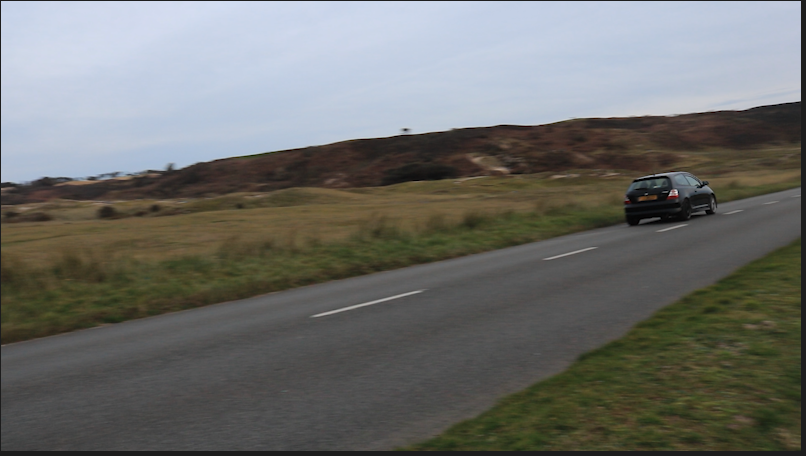
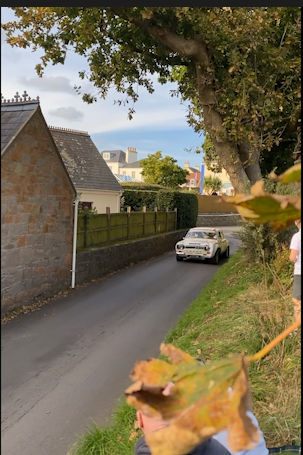
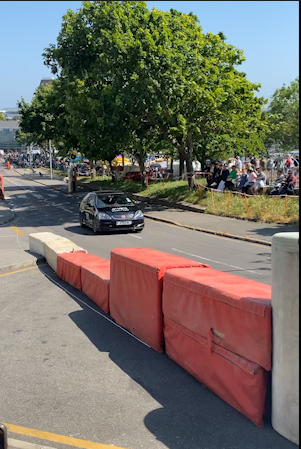
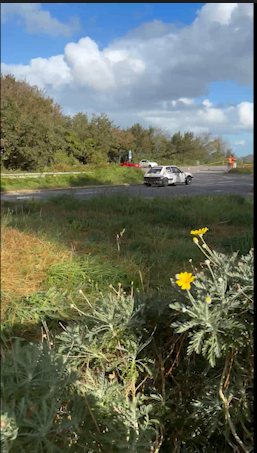

Step 14:
After filming my interview in full and my fly bys I then went through the footage to edit the clips and to cut out any unnecessary video.
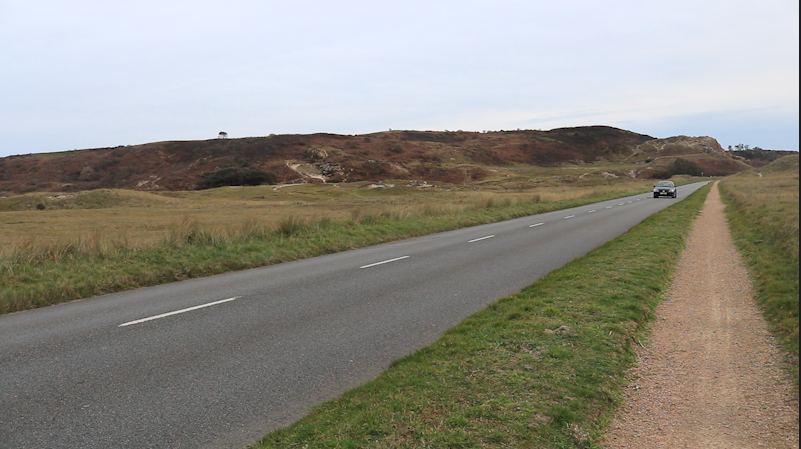
I then used another shot of a fly by to circle back into the next part of an interview.
Step 15:
I played around with the sound effects of each video to create as clear a sound as I can, editing the videos of the ‘fly-bys’ to be seen as close up and the audio of the dialogue to make it as clear cut as possible.
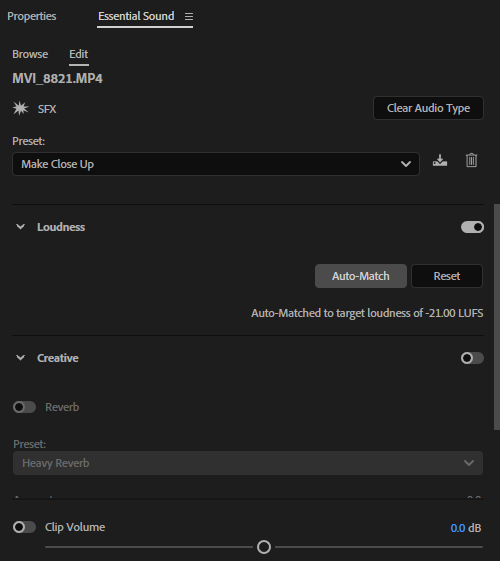
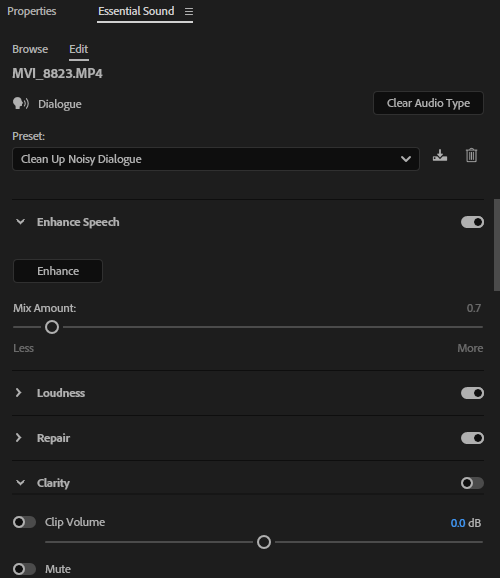
Step 16:
As I kept filming new clips I made sure that I was adding them into the correct filming folder to then export them into my premiere pro project. This ensured that all my clips were the best quality that they could be and that there were no errors within the file.

Step 17:
I then added in part one of my second interview, with a smooth fade from the clips of the fly-by into dialogue.
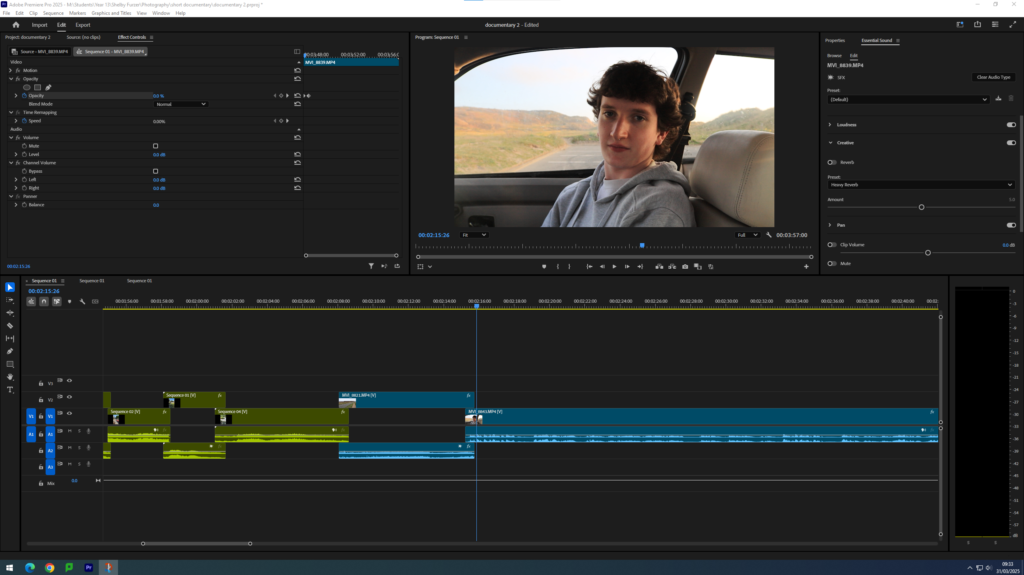
Step 18:
After adding in the first part of my second interview and making sure the sound setting were set to dialogue, I started adding more clips of cars to fade back into my original interview.
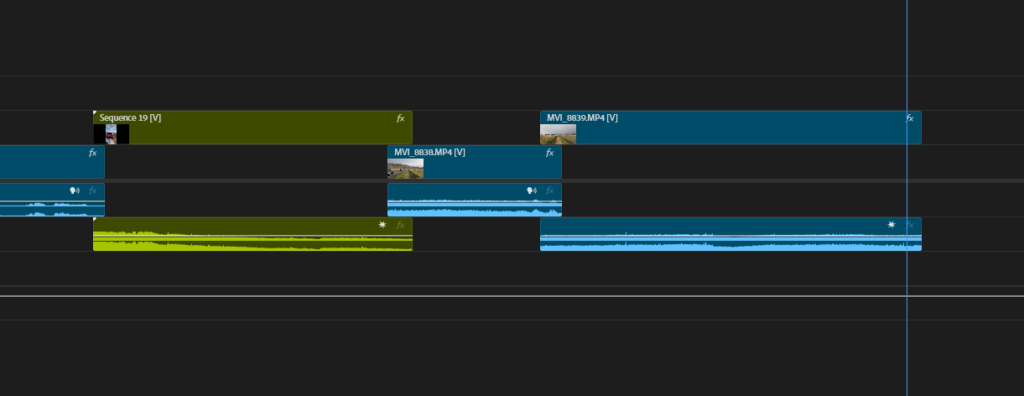
Step 19:
I then went through and edited the audio on each clip and made sure that they all faded into one another, so that I could prepare to add part two of my first interview.
Clips –

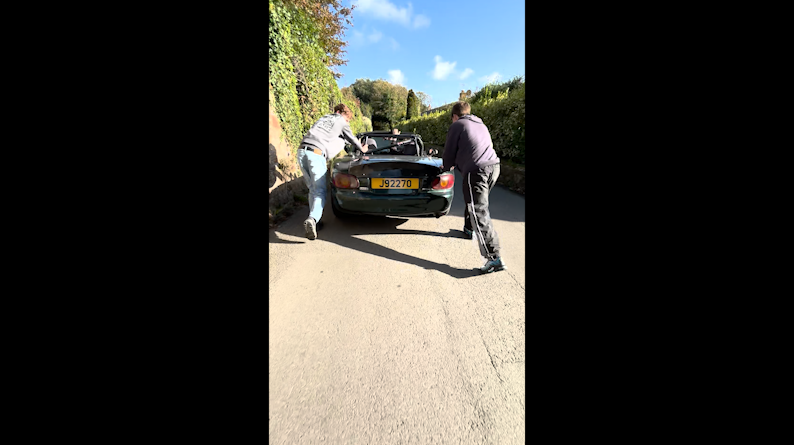
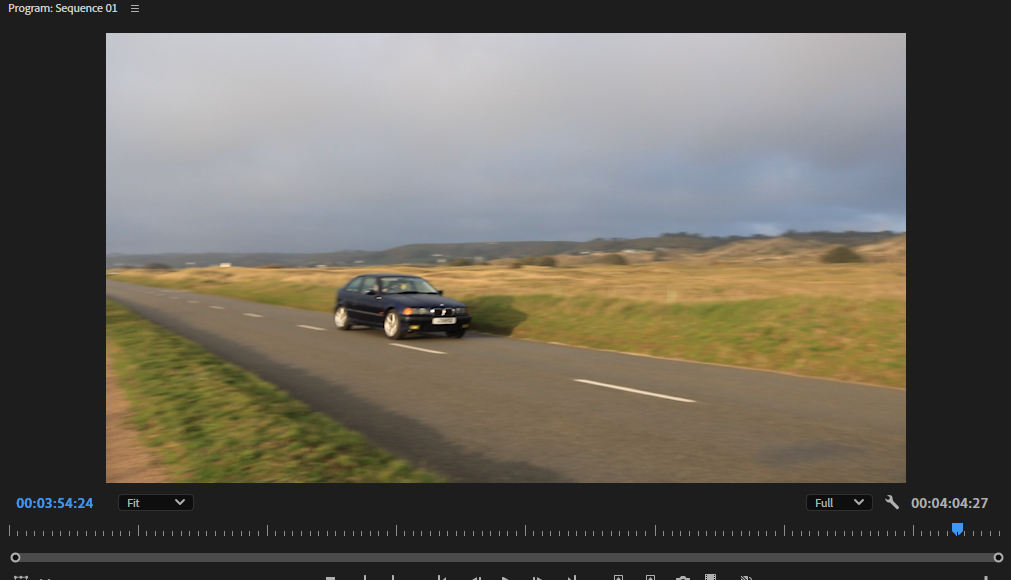
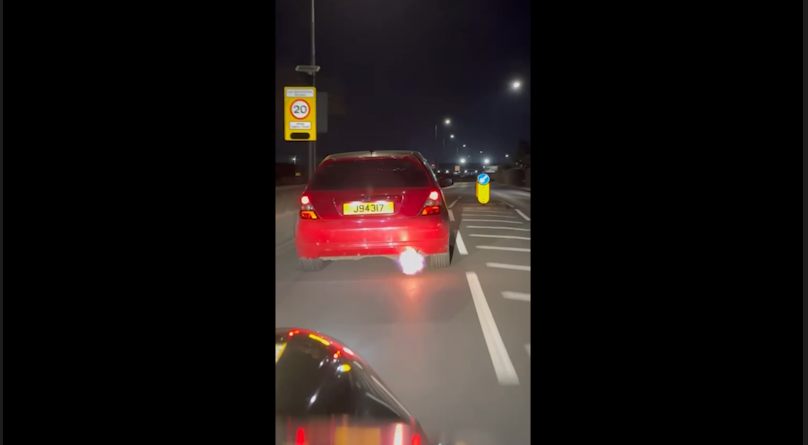
Step 20-
I then went on too add the second part of my first interview. Making sure to carefully blend it into my other clips and get the correct audio settings’.
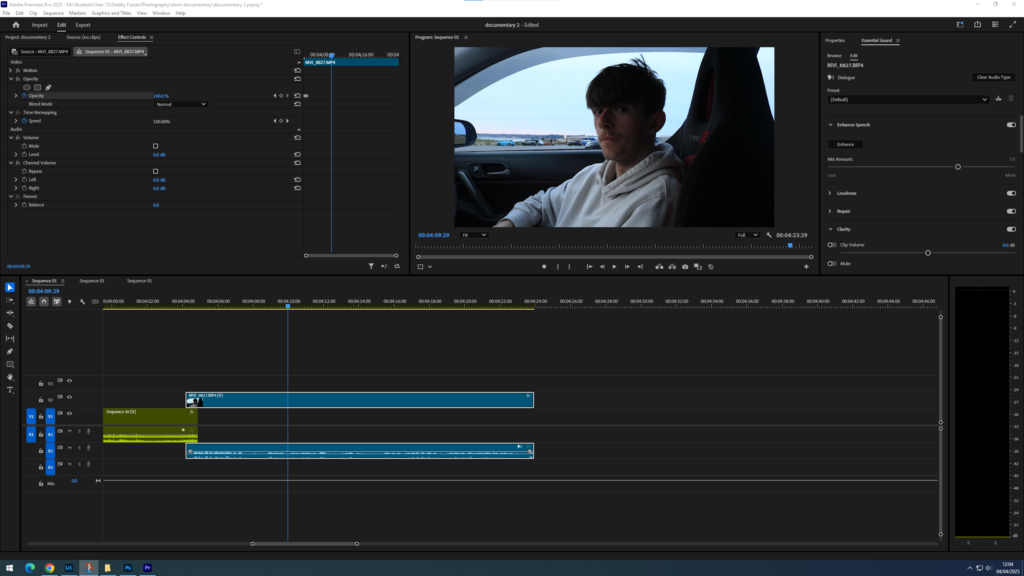
Step 21-
This second part was a lot shorter which meant that I knew that I could add some shorter clips before the next part of my second interview.
Clips –
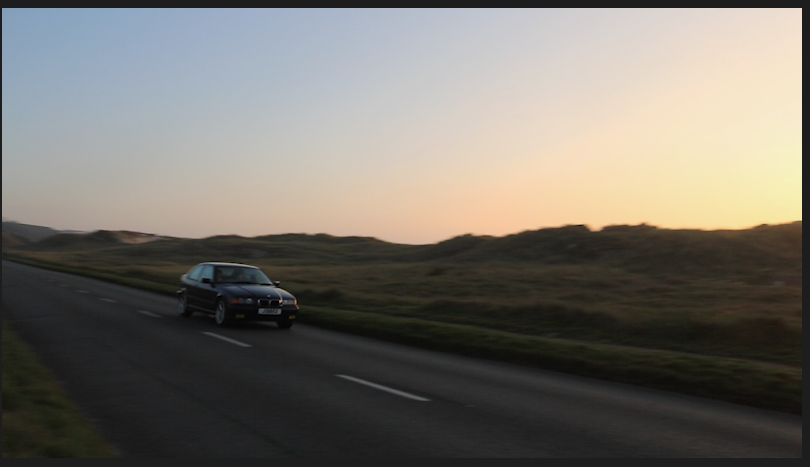
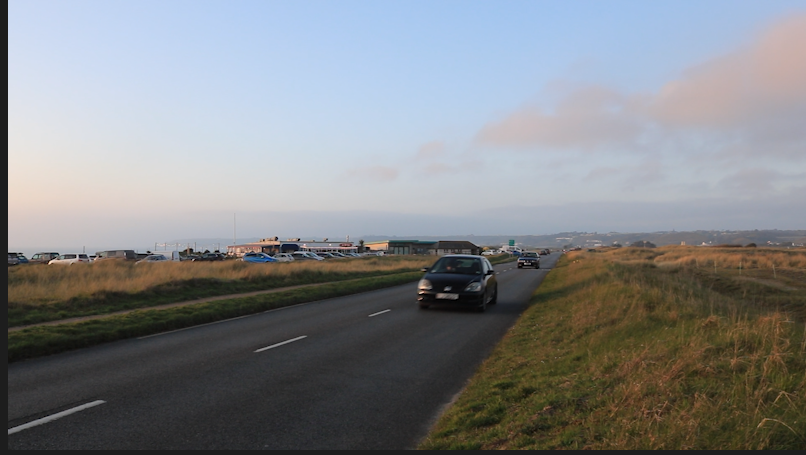
Step 22-
I then added in my second part of interview 2, which is a very long one so I will keep in mind that between this and the next interview clip I will need to add a lot more little cuts to keep people’s attention.

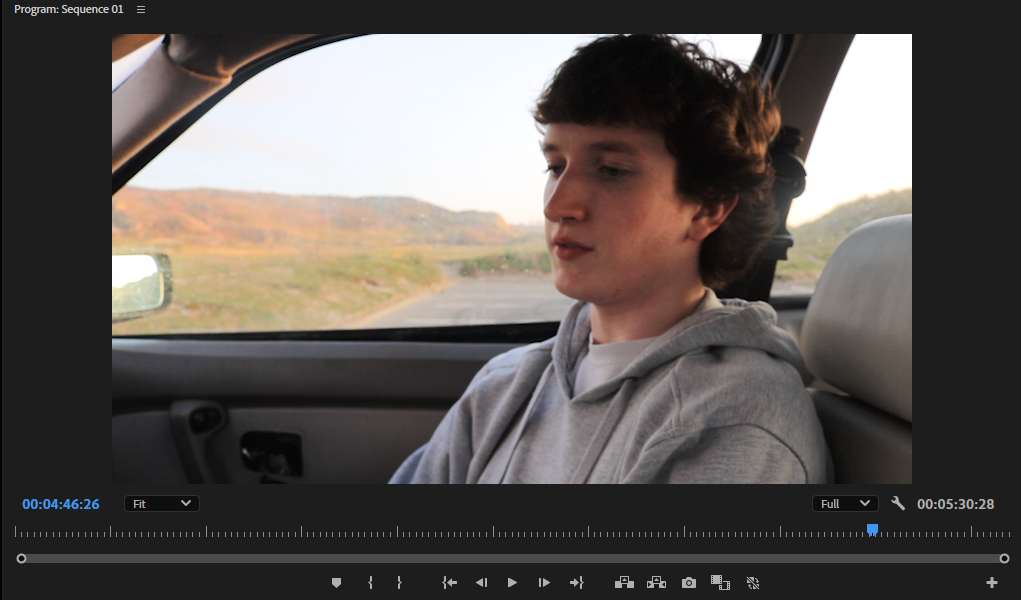
Step 23-
I then went in and added all of the short interesting clips I wanted to gain retention.
Clips-
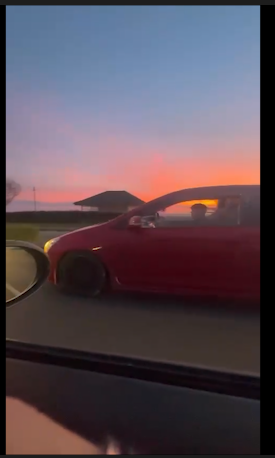
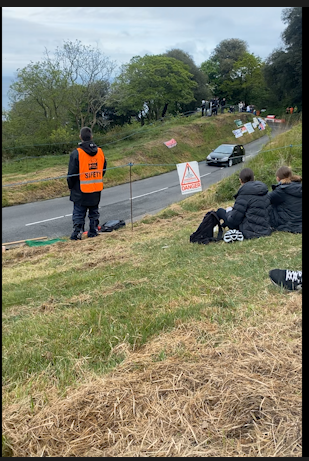
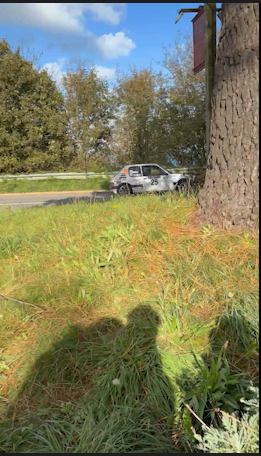
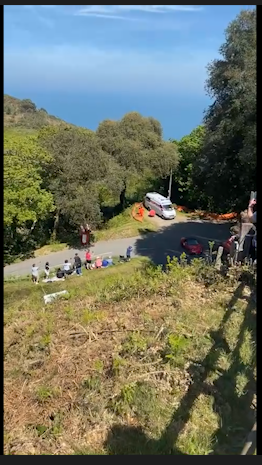
Step 24-
I then added in the final clip of my first interview, this clip is only a few seconds long so I know that I won’t need many clips after it for my interlude between here and the last part of my second interview.

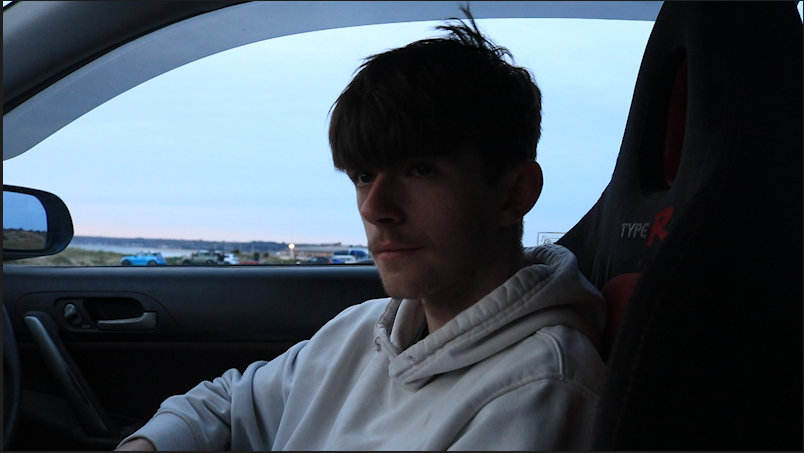
Step 25-
I then added a few clips between that final question and the final questions of my next interview.
Clips-
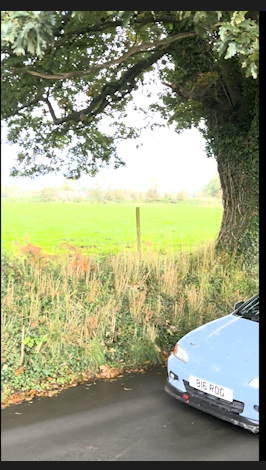
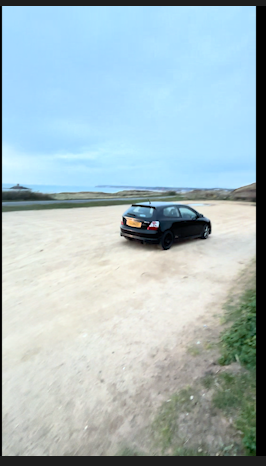
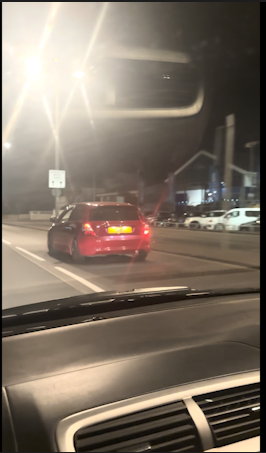
Step 25-
I then went in and added the final part of my second interview, this ment that all interview clips were now used up and all I needed to do was shoot some more small clips to tie it all to an end.


Step 26-
I watched the whole video through and through and went in and did some cropping, blending and audio editing to make sure that everything was flowing smoothly and in good shape.
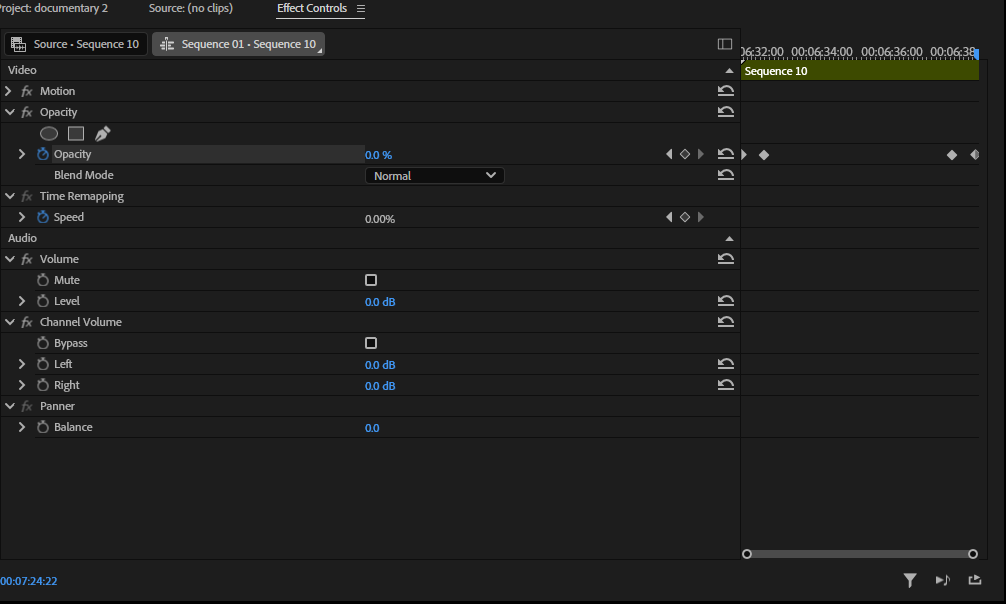
Step 27-
I then went in and added my final short clips to bring my video back together, tying up the final strings.
Clips-
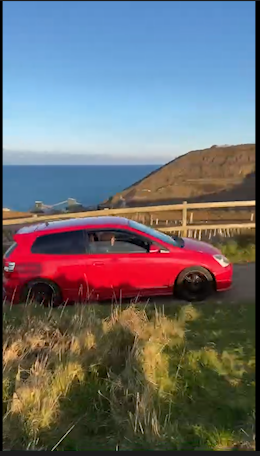
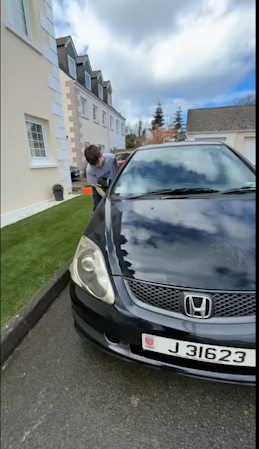
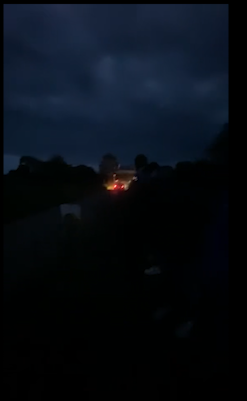

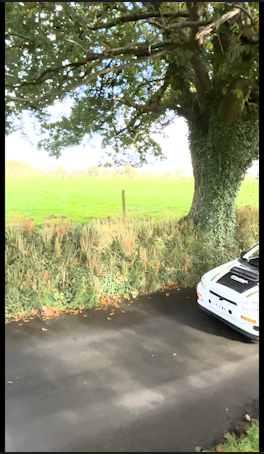
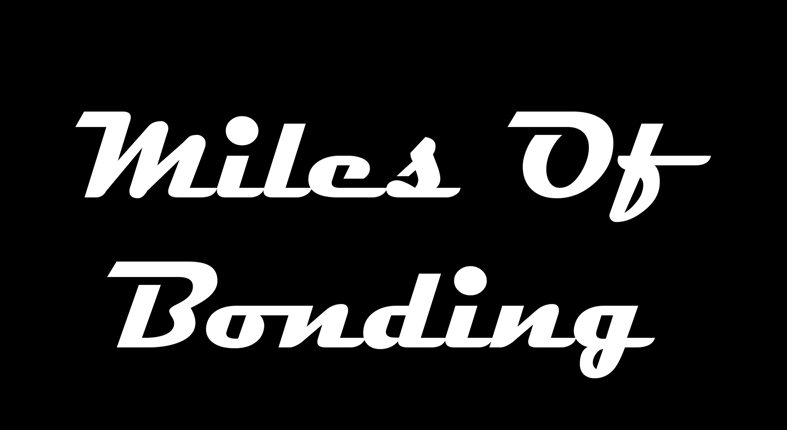
Step 28-
Once I had finished adding my final clips I then went in and had to resize them so that they fit all the same as the others.
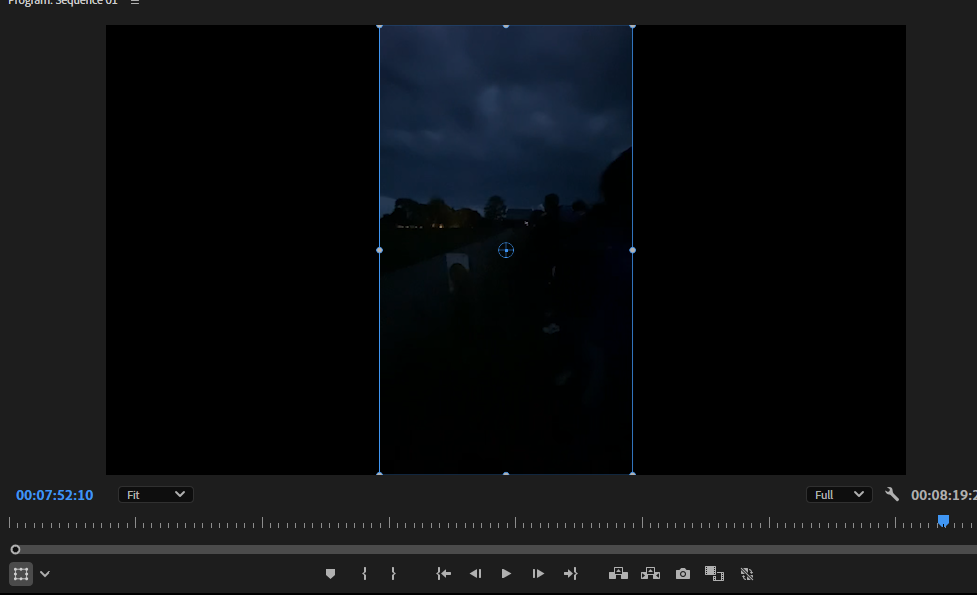
Step 29-
After doing that I then went into the sound properties of my video so that I could make sure that the sound of the final clips were all linked together and in the correct setting.
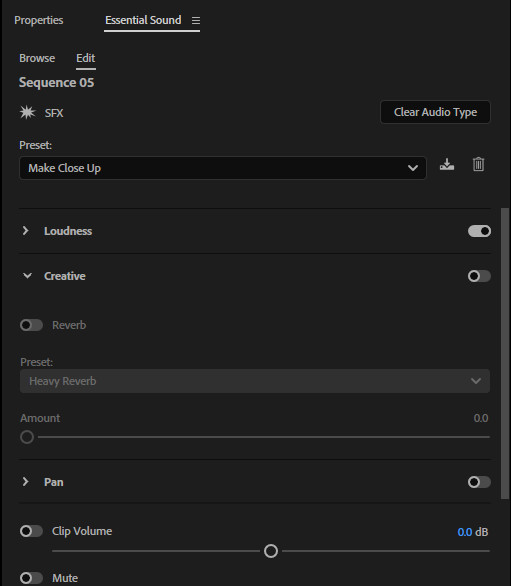
Step 30-
My final step was to just watch the whole video back and check in for any errors, listening in closely to hear how the audio sound, how the clips look, and if any of my settings needed to be changed.
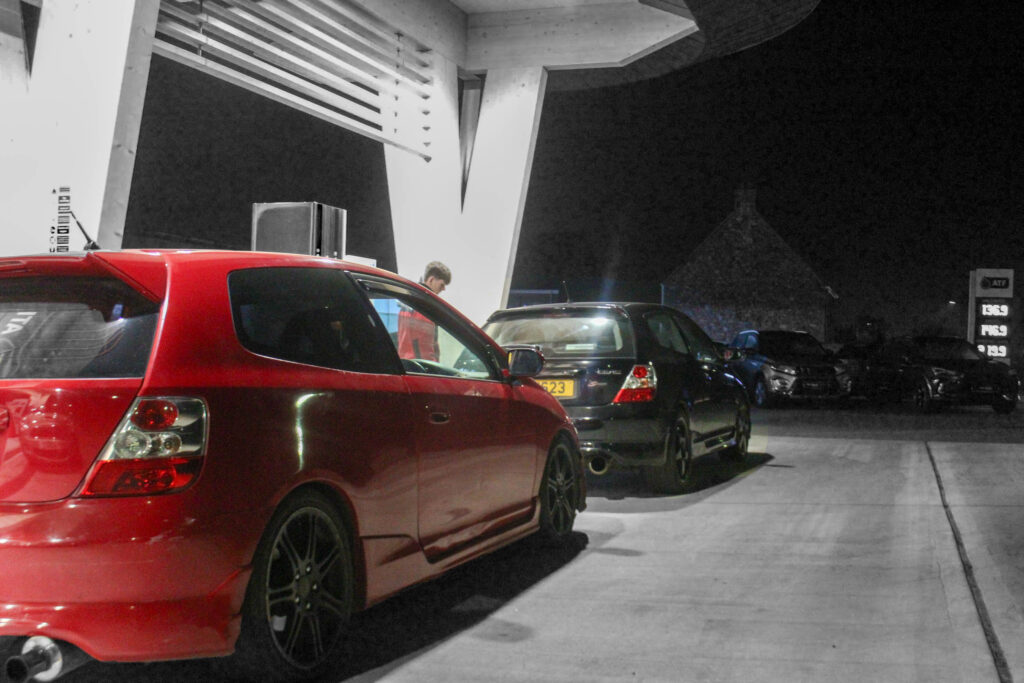
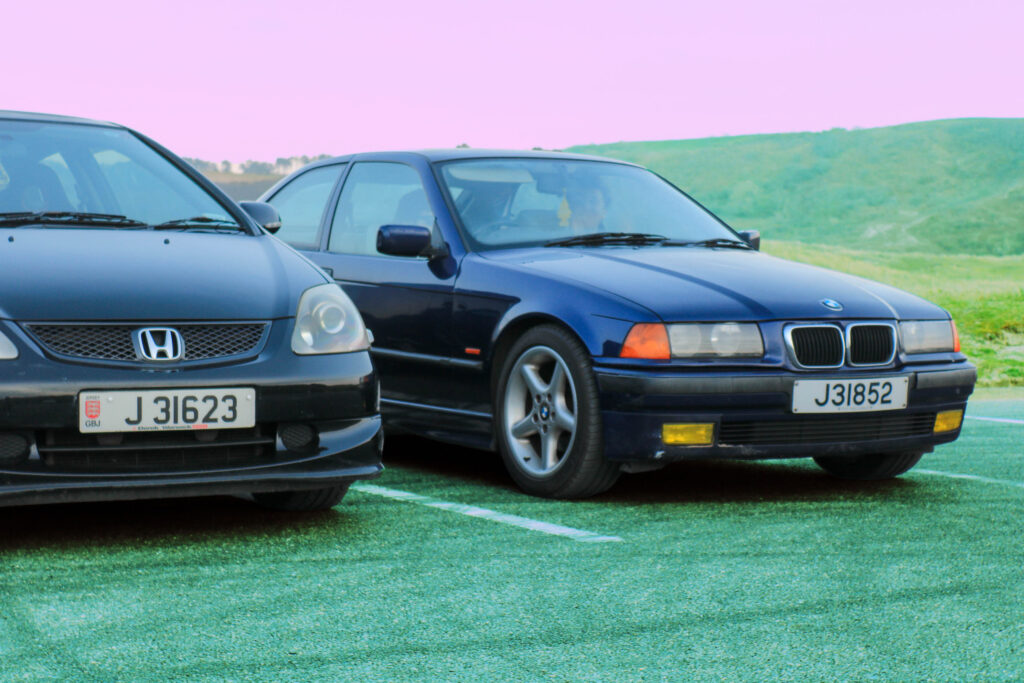
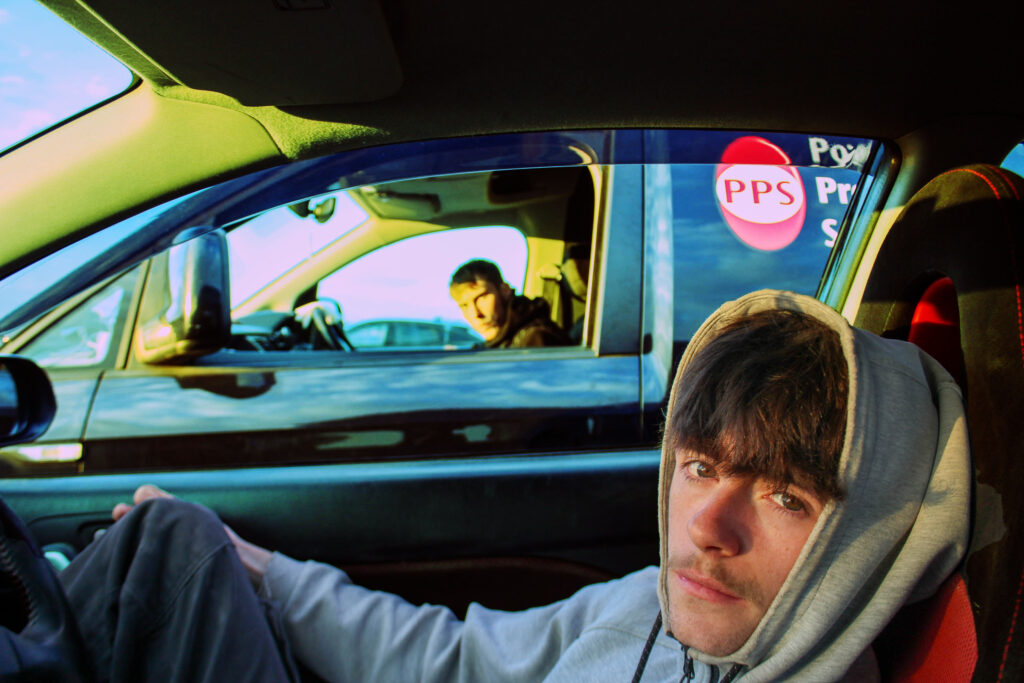
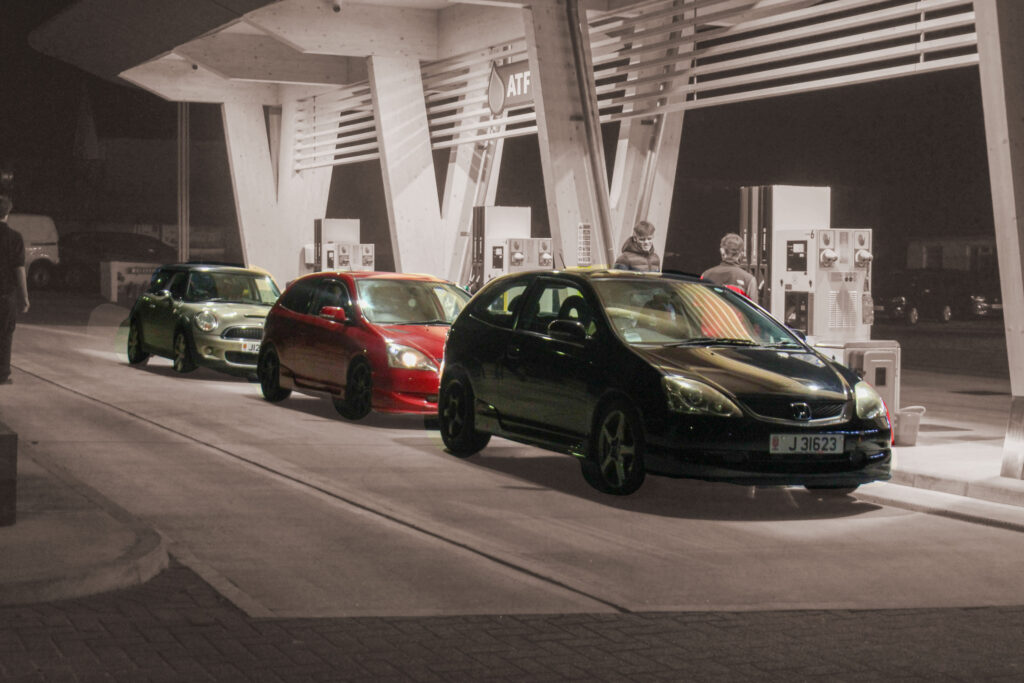
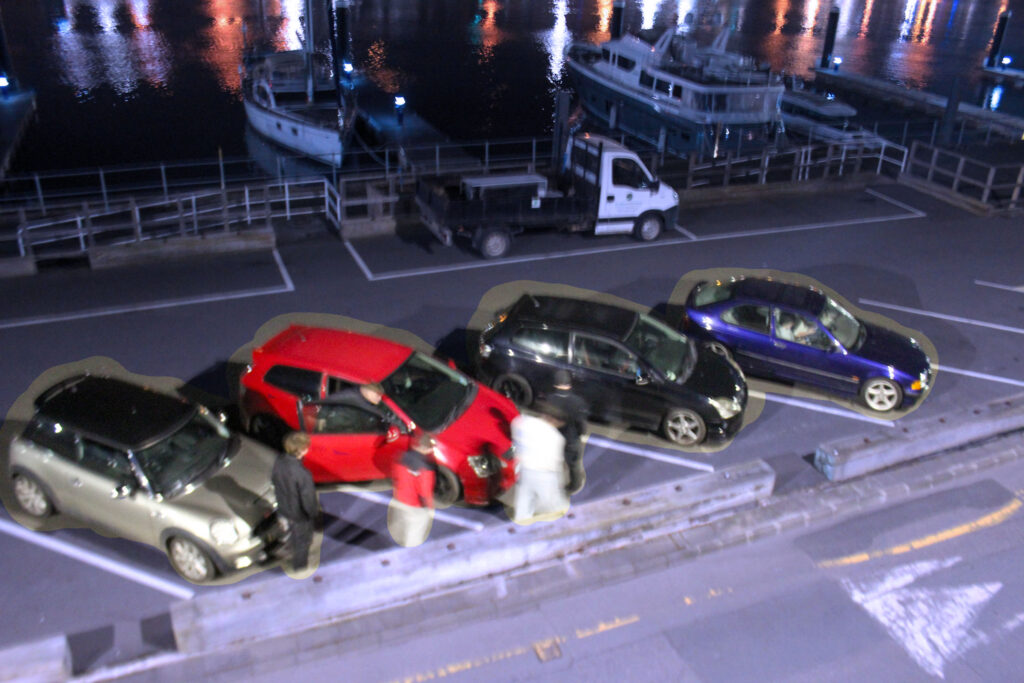
I then decided I also wanted to make a board of some colour popping experimentation for this project, so I ended up adding some more images to the print folder and therefore experimenting making some more boards and virtual gallery’s. I only wanted to print these in A5 thought as I didnt want them to be very big.
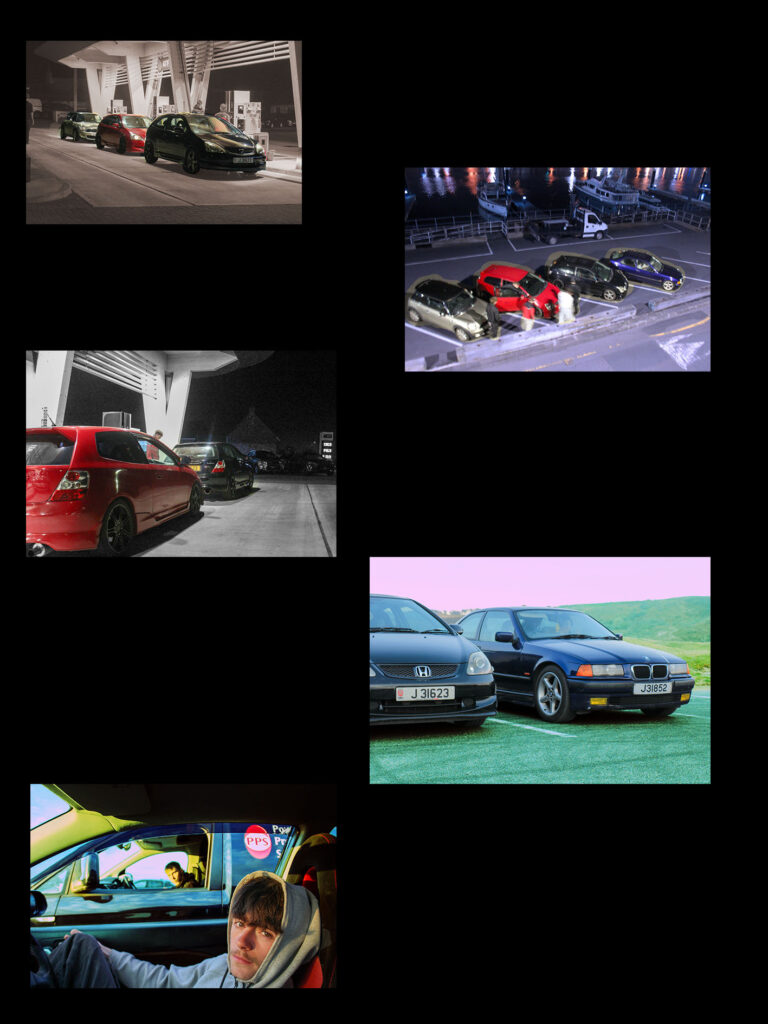
I will keep all of my colour popping experimentation images on one plain board, this is to group them together and show my experimentation with the images, I have printed them all in A5 so that they are small enough to all fit on one board.
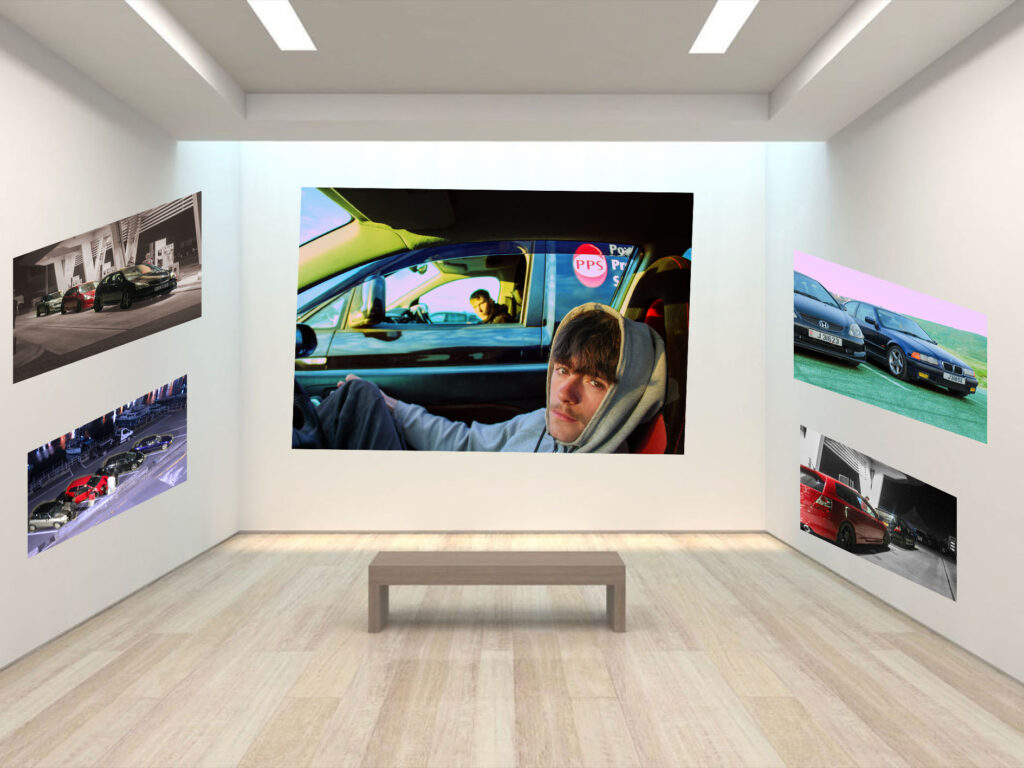
This is my virtual gallery for my colour popping experimentation, this shows a clear and consistent idea throughout my colour popping editing, which is too select a main or the main subjects and change the background behind them in a way that makes them stand out, for some images black and white shades are the only options for this, but in ones where the subjects colour pallet completely differentiates to the background I am able to choose a different pre-sets to change.
1-
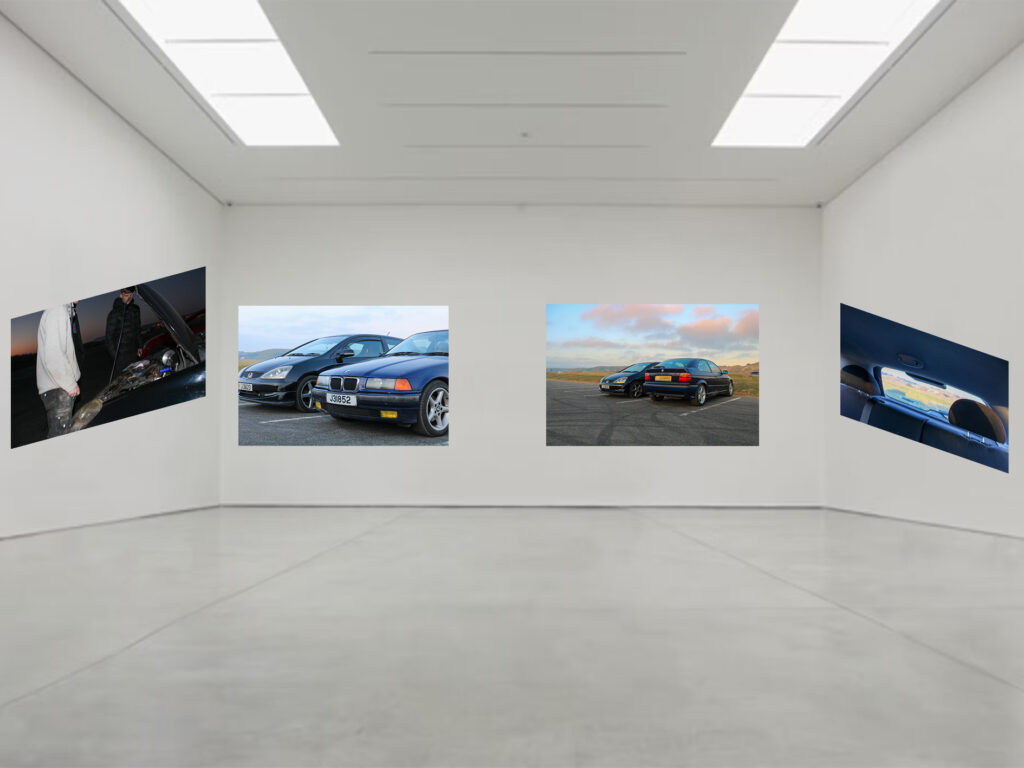
This virtual gallery is of my A3 images.
2-
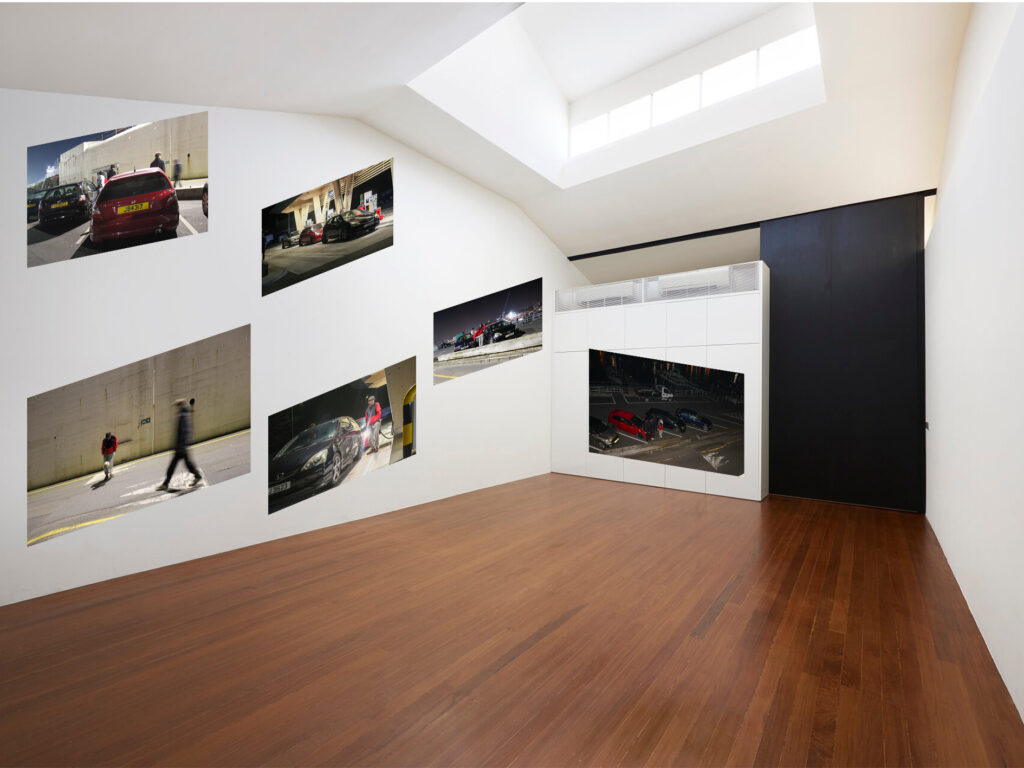
This virtual gallery is of my A5 images.
3-
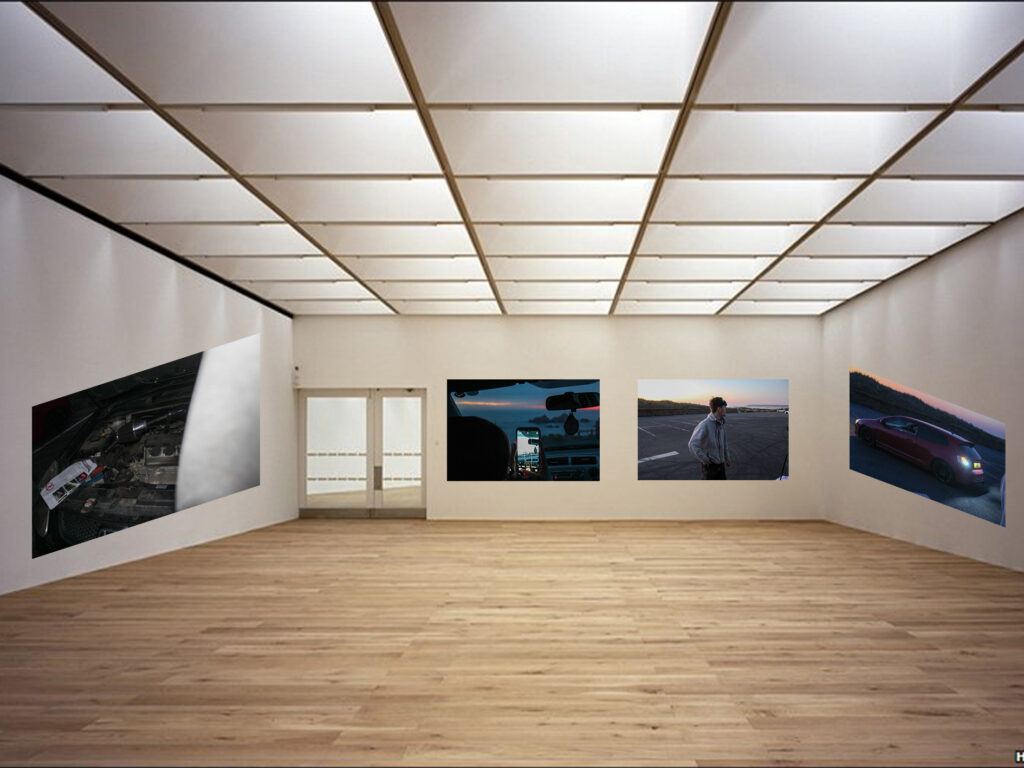
This virtual gallery is of my A4 images.
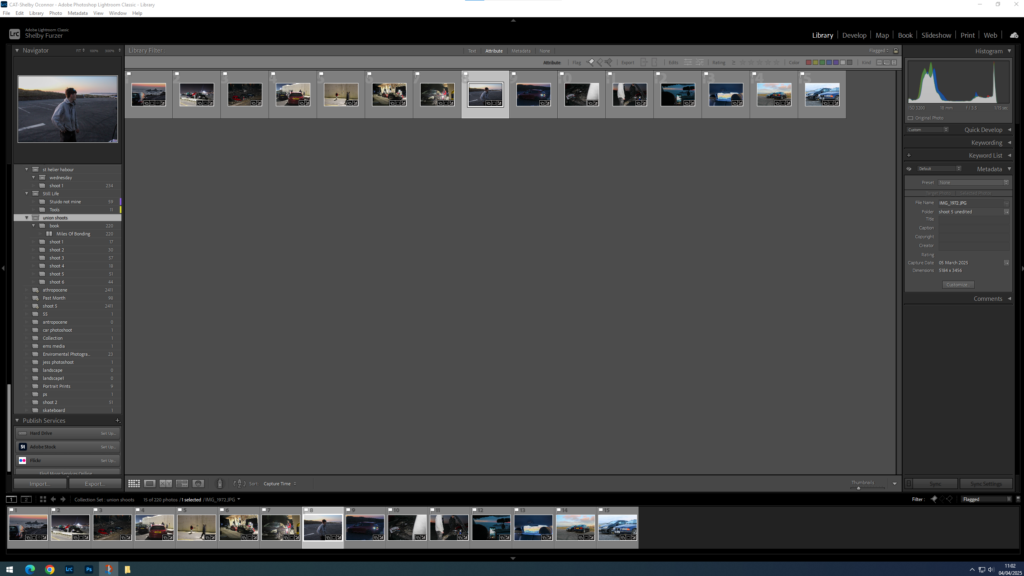
For my final prints I have chosen these images in these sizes.
A3:
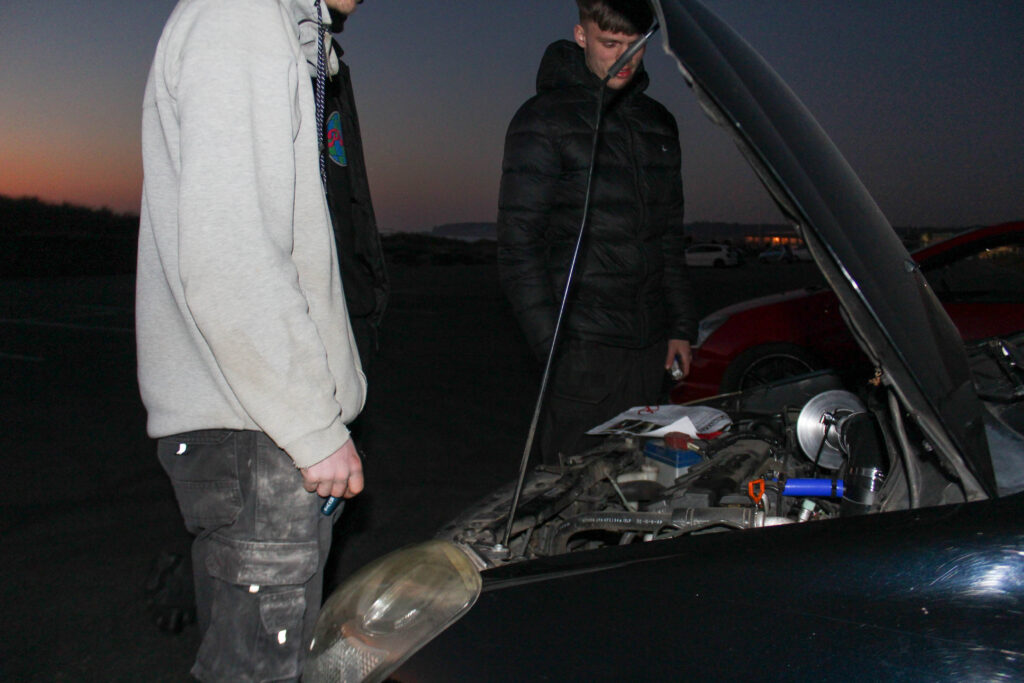
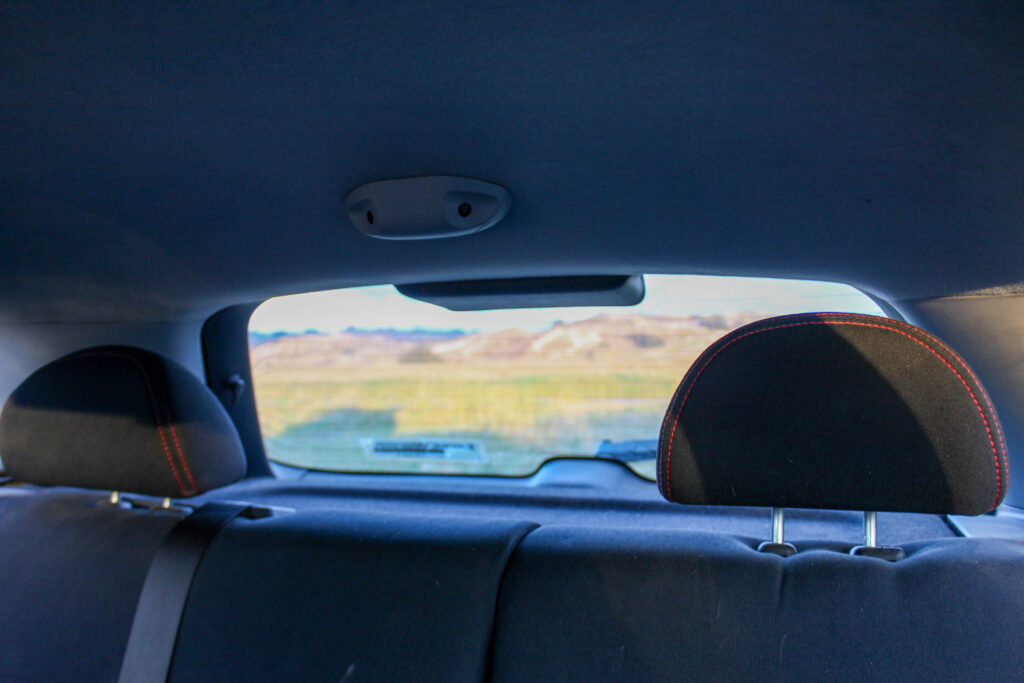
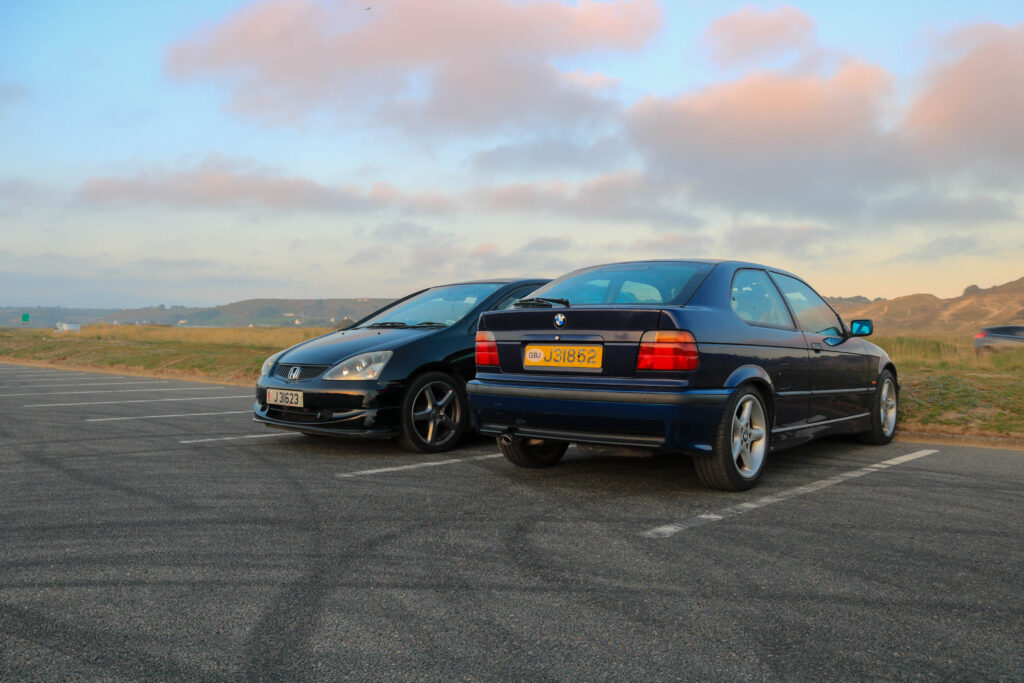
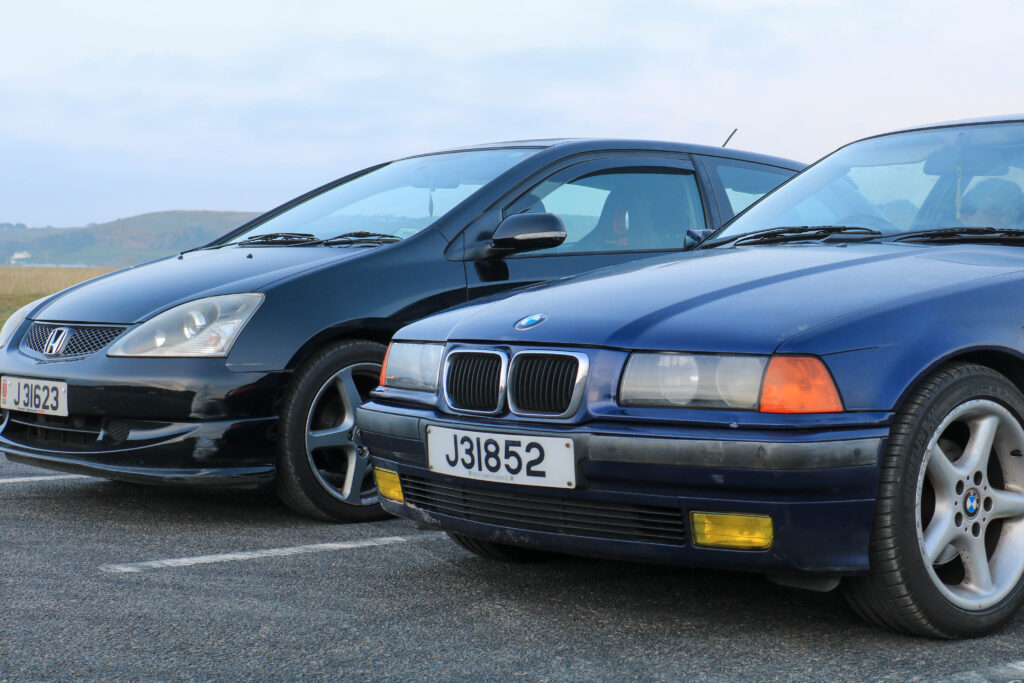
A4:
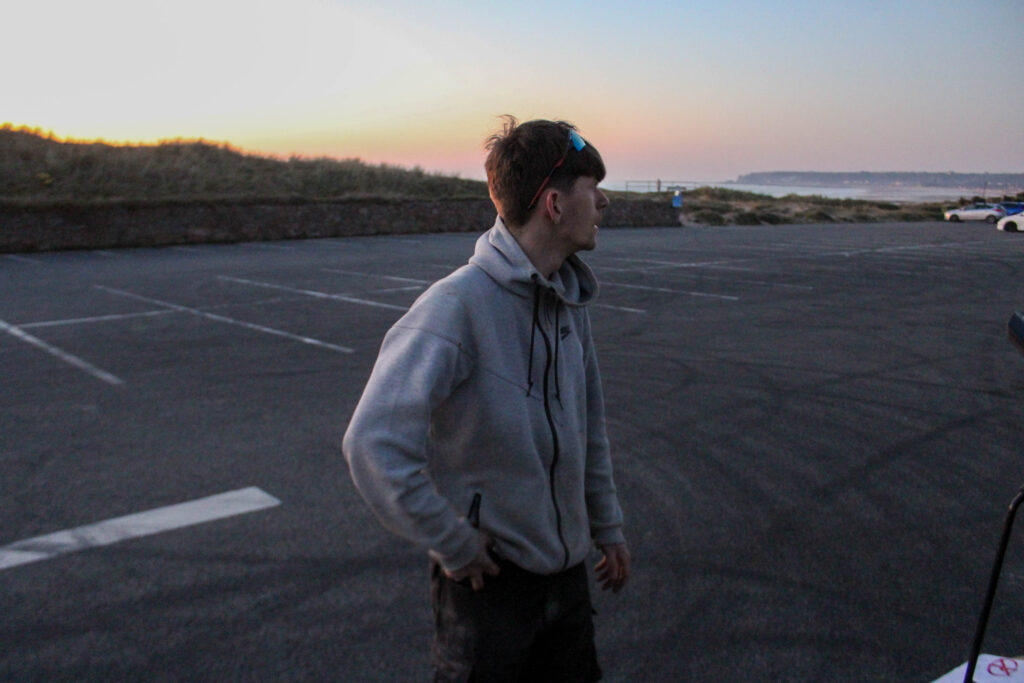
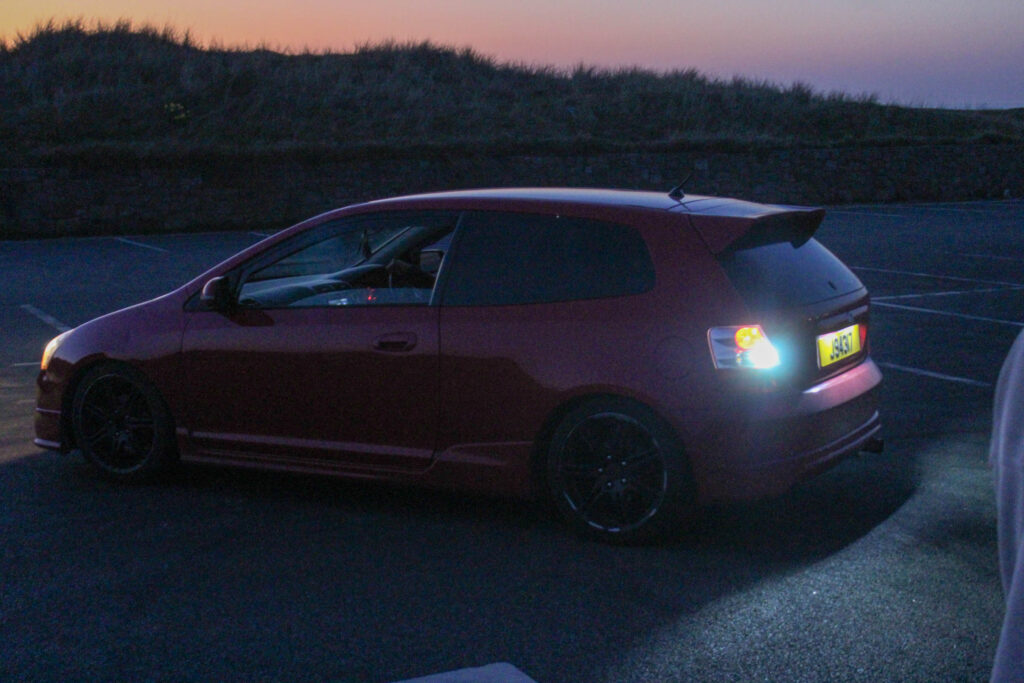
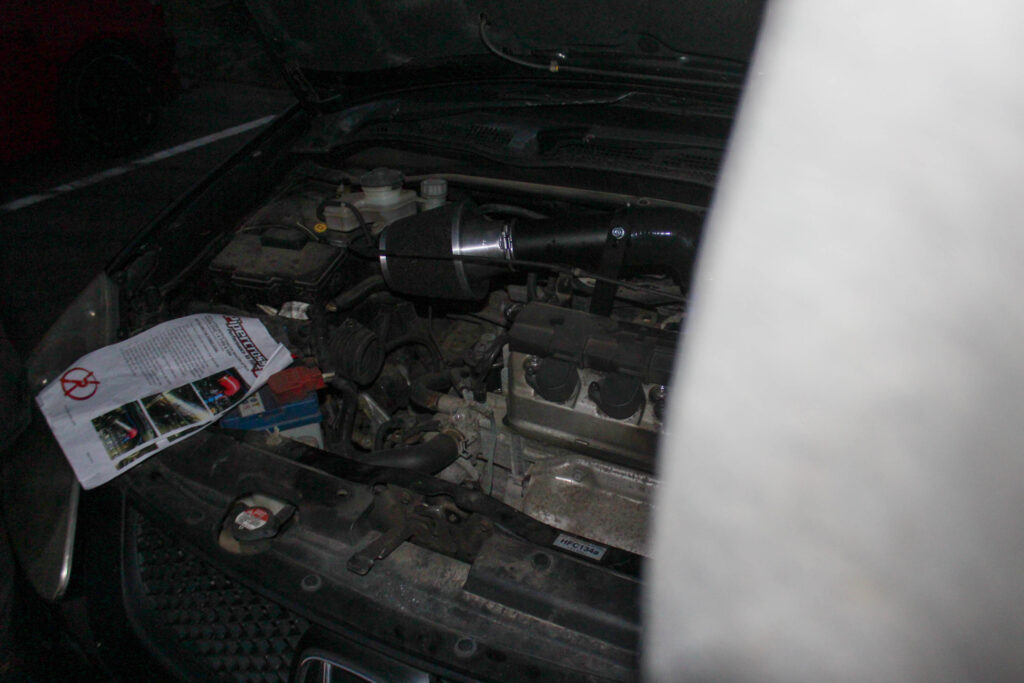
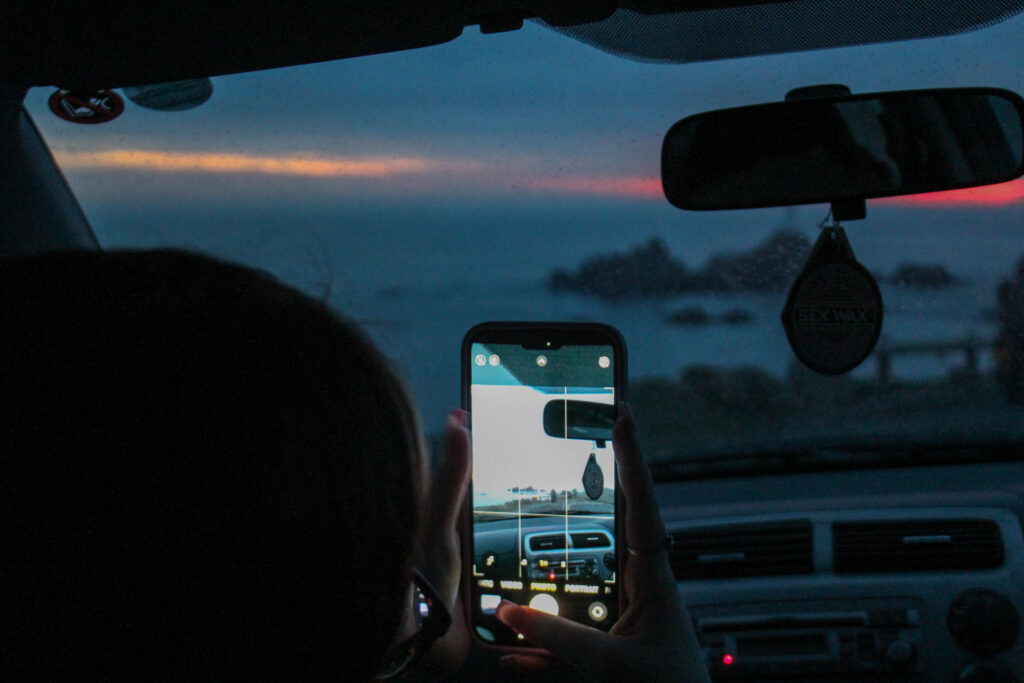
A5:
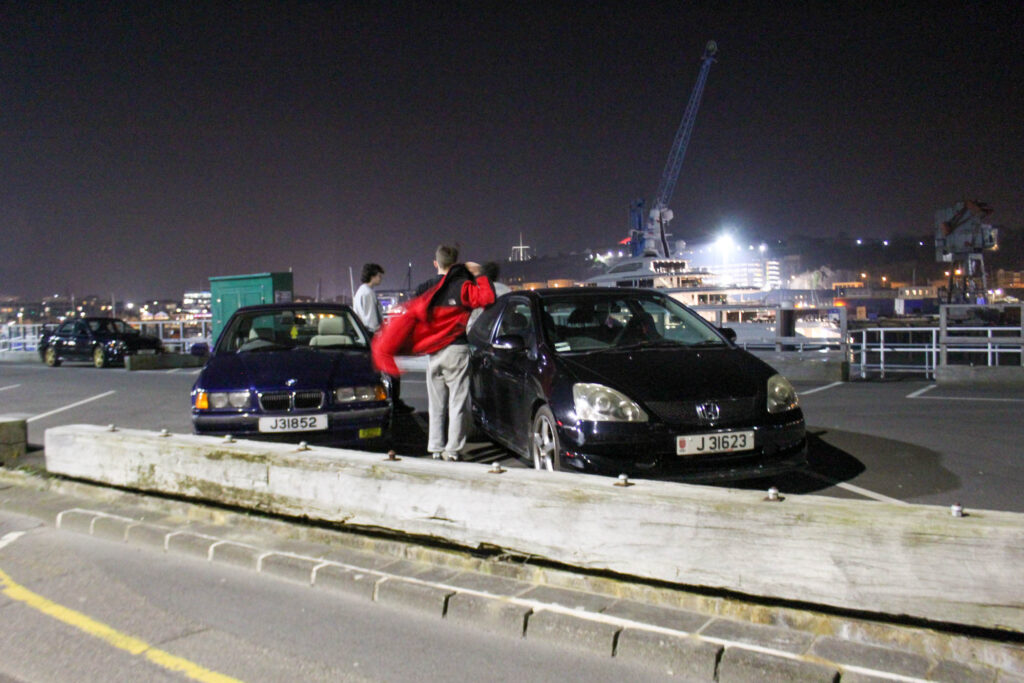
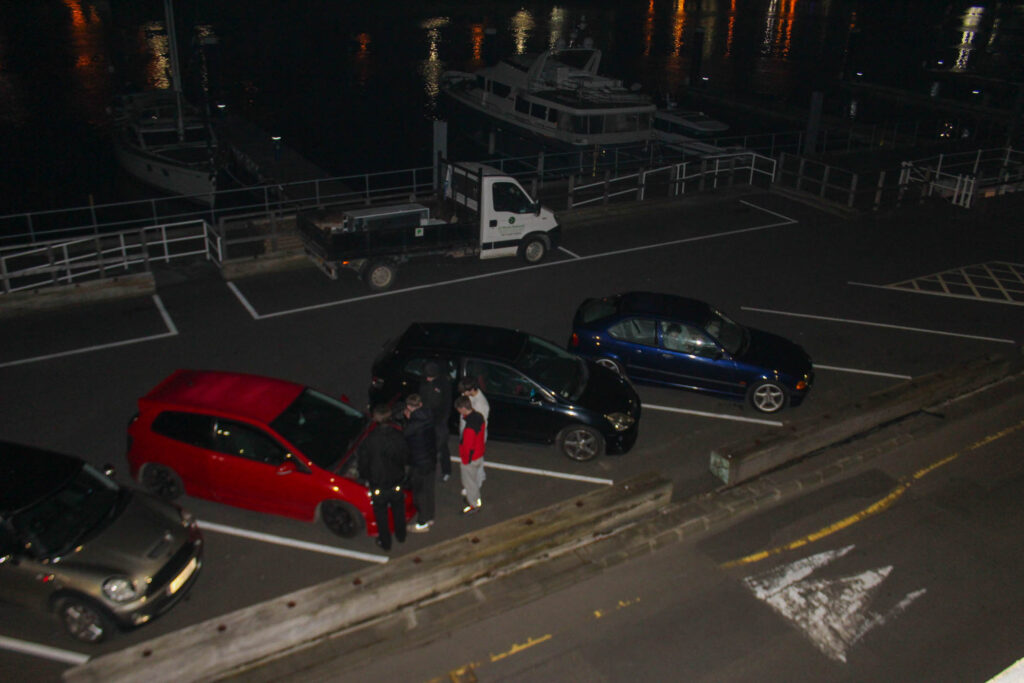
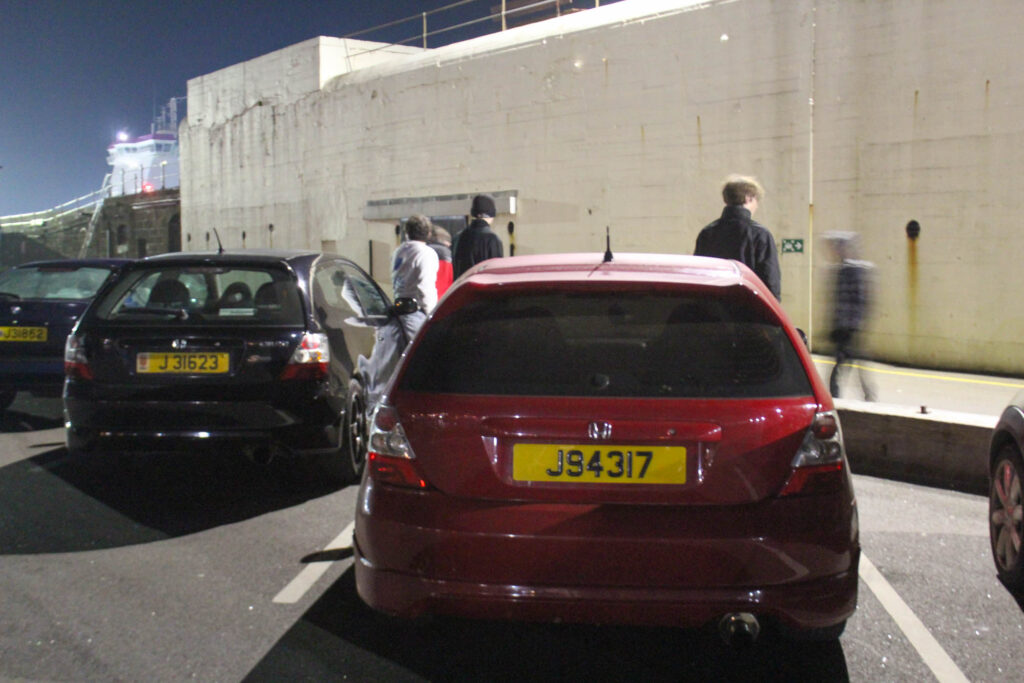
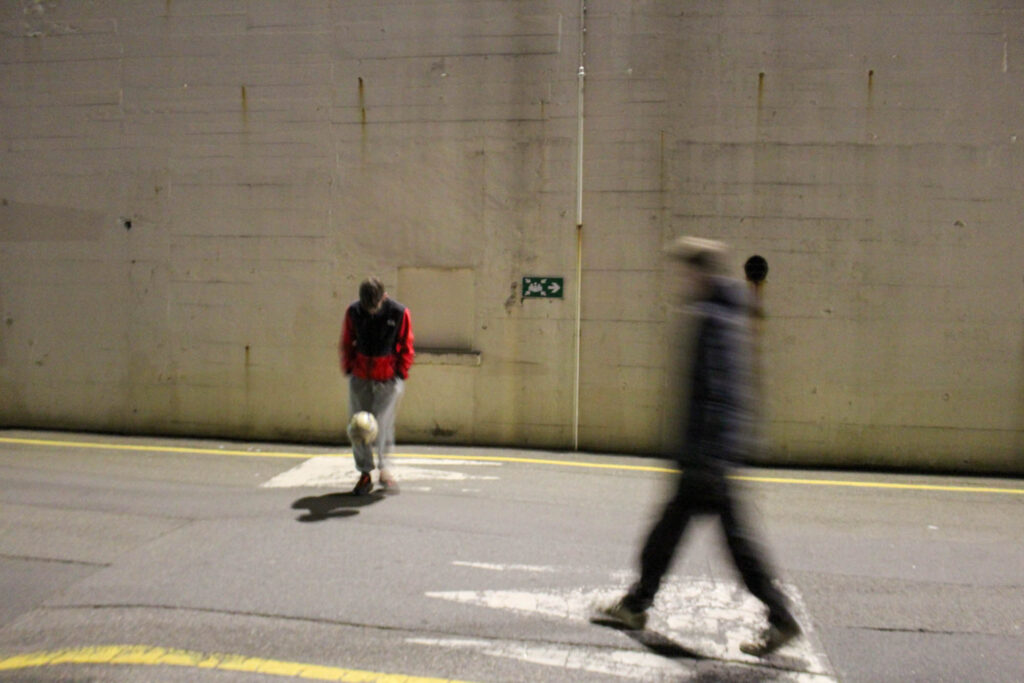
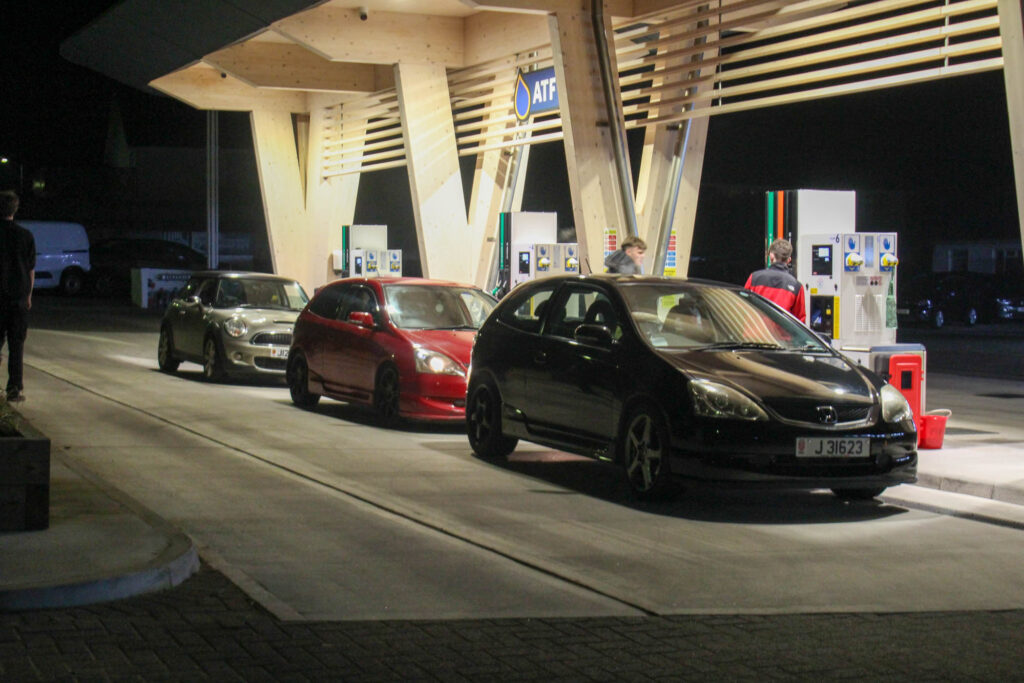
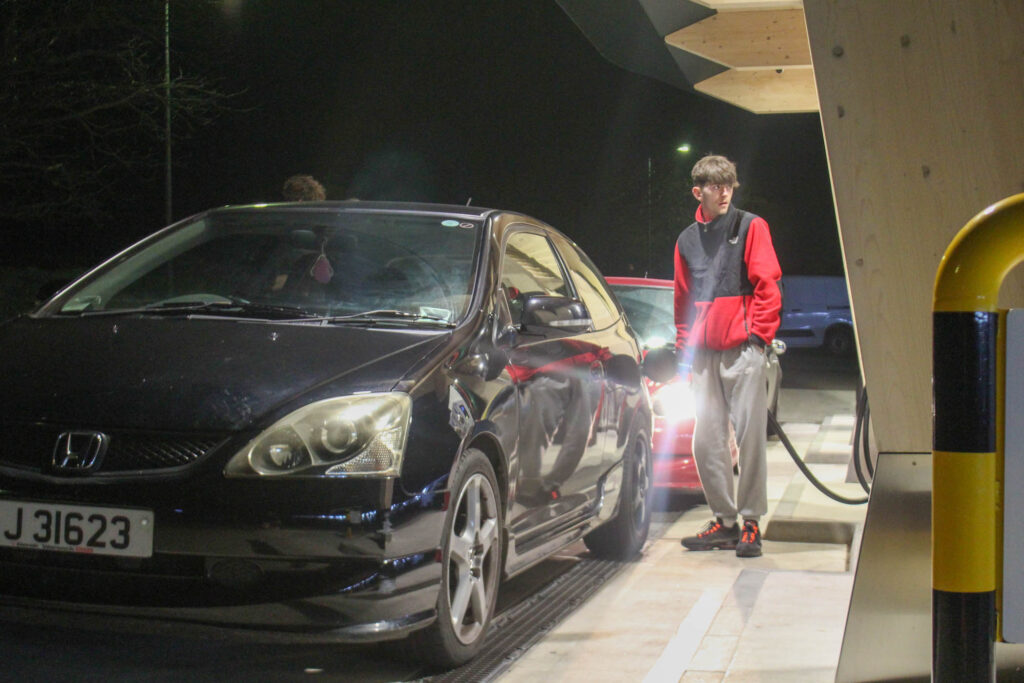
I am going to mount them all onto foam board and the further put them onto black card to create a popping out effect. I will create mockups of this within photoshop.
Board 1 –
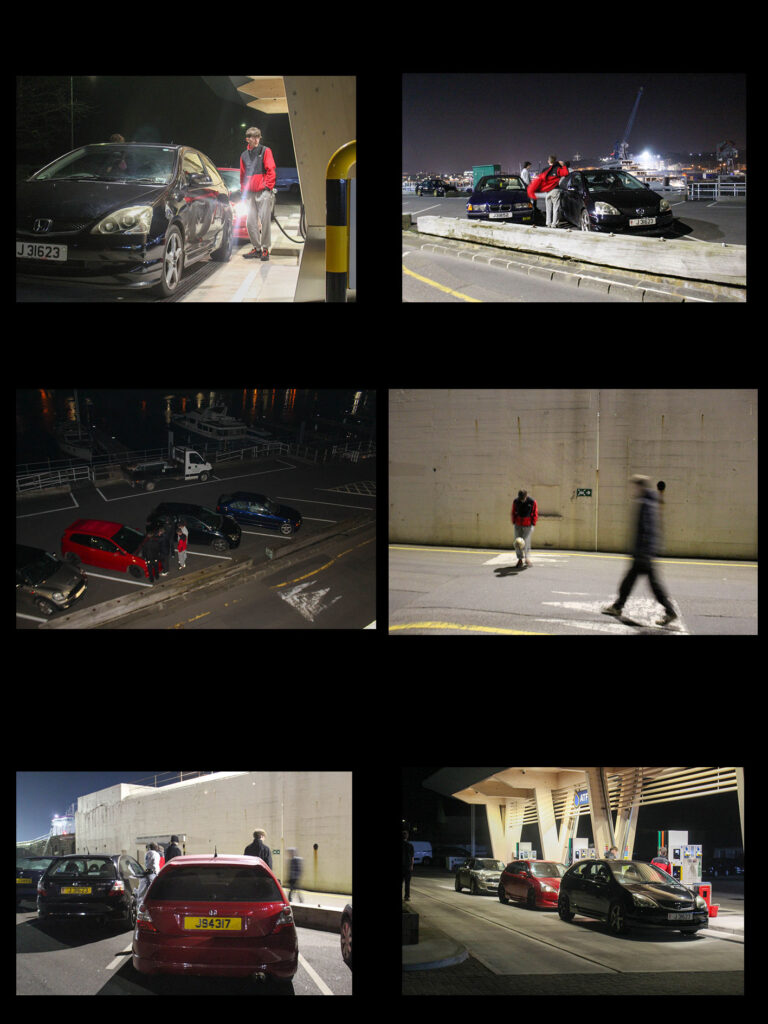
The reason that I have chosen these images as A5 and decided to put them all onto a board together is because they all have the same neutral tones. With the beige coloured walls and concrete flooring they all link together. They also all clearly contain the same car and are all shot at the same of two locations. I think that keeping these images in a neat sequence will allow for subjectivity, meaning when someone looks at this board all the images are relatively the same so if their eye is drawn to one in particular its for a personal reason.
Board 2-
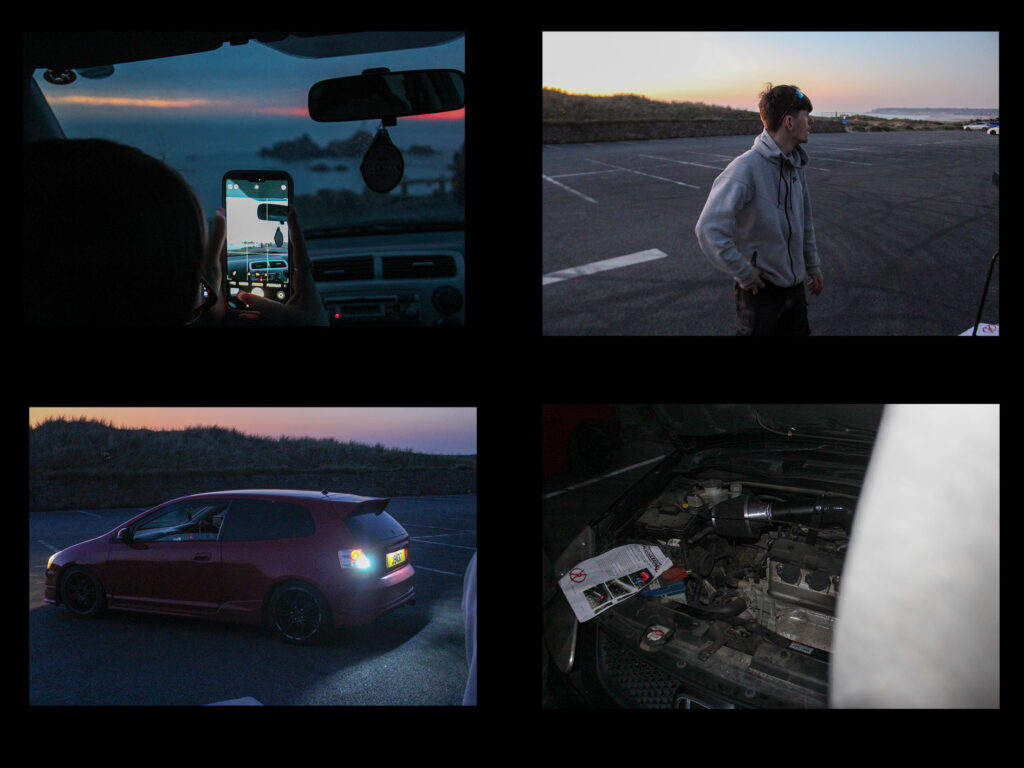
The reason I have chosen to keep these images together and make them A4 is due to there cool tones. The dark blues and blacks all correlate together, and each image has its own little flare of sunset which links them up. By putting them all on the same board i’m telling a story about that short period of time between light and day and how crucially needed it is at different instance’s, for example the images on the bottom row are of the models rushing to work on the car before it gets dark, but binary opposite the top row is just peoples socialising and taking in this sunset.
Board 3–
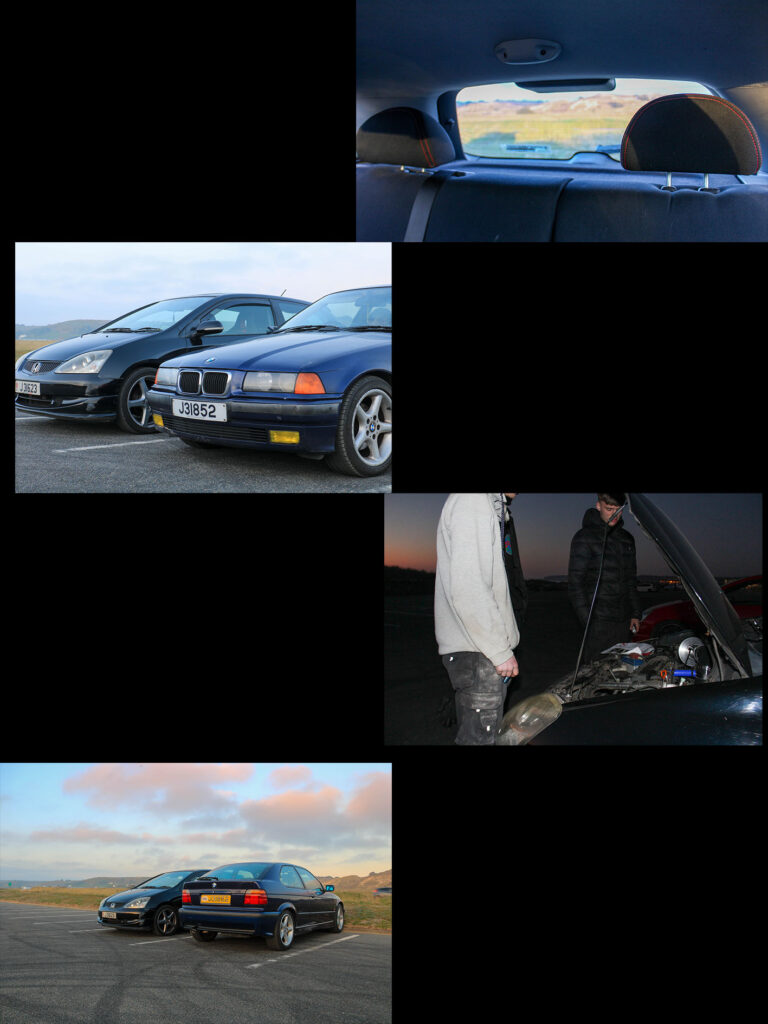
The reason I have chosen to put these images on a board together and make them all A3 is because of their crispness. The sharp edges of the car contrasted with the glare of the camera, these images all link up in a structural way. By contrasting the day with the night it creates a story line. The bottom image is very clear and crisp, which is why i’ve put the one above it there as they catch each other. I have chosen to put the inside car one at the top and the working one in the middle as they are almost like story fillers.
Board 4-
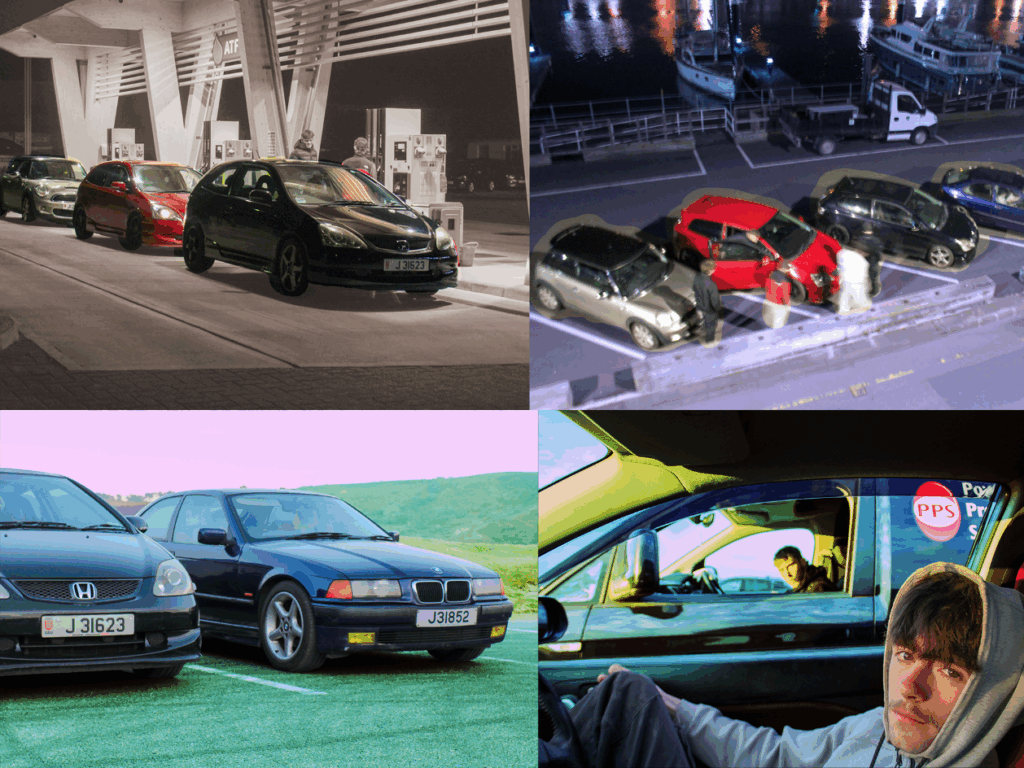
My final board is going to be my colour popping experimentation board, I wanted to show all of the experimentation that I have done on one board. By doing this I have grouped together a set of images that flow, with the bolder toners grouping and the black and whites.
Overall-
I am going to keep all of my different image sizing to there own board, this is so that all of my images are in sequences. I will make sure that they look neat by measuring the black board to evenly spread my images out on it.
My book miles of boding was created so that I could add a more personal feel to my short documentary. I wanted to incorporate some behind the scenes action so that this context could elaborate on the idea of union.
Cover Page-
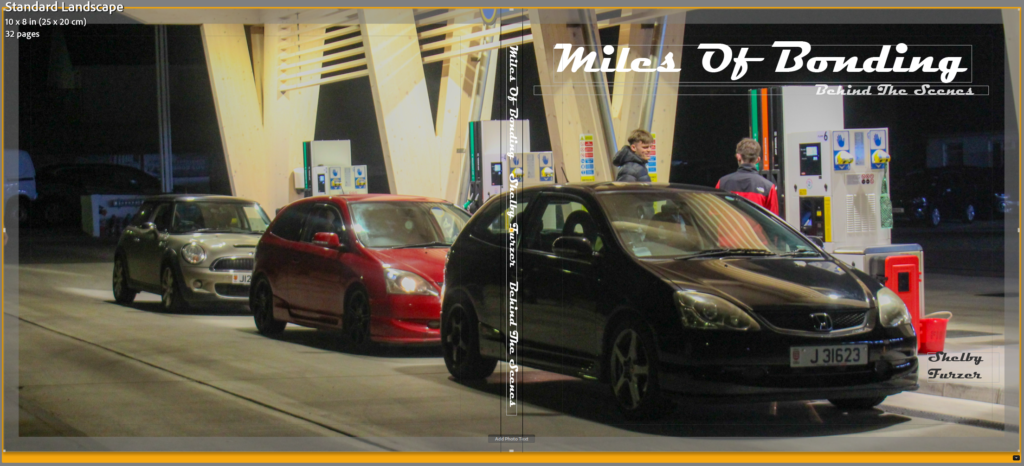
I decided to do a double page spread, so that I could show that my photo taking and filming process had come to an end by looping the start around to the back. I chose this image as it felt very personal and up-close, almost calming. The documentary is about cars being raced and contains footage of that, so by adding a personal image of them just simply filling up their cars it brings you back to basics. The normal things you need to do before their personality and passion takes over. My title was to connote to unity within the car scene. I have used a font which is seen within many different car magazines, which you can see I have assessed through my inspiration blog post.
1st Double Page Spread-
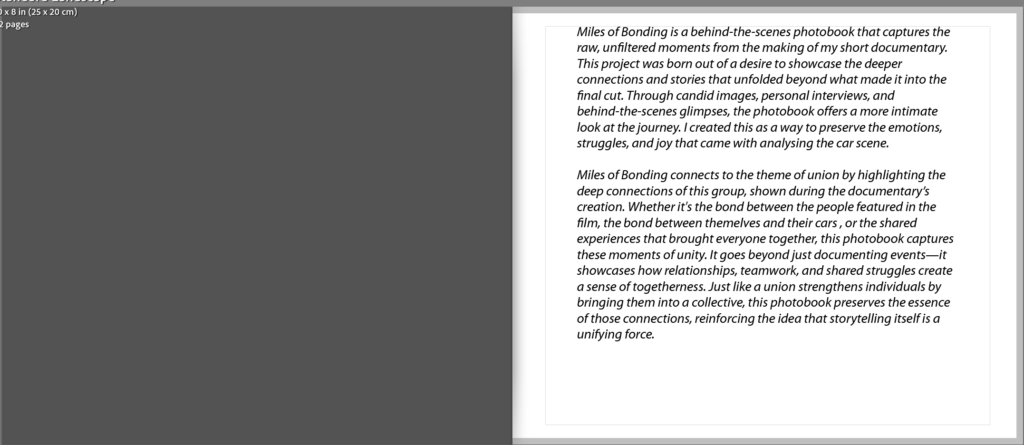
My first page spread contains a short description of why I have created the book and the documentary and how they both link to the exam criteria of union. I have decided to add this to give people more context about my title and about why I am doing this.
2nd Double Page Spread-
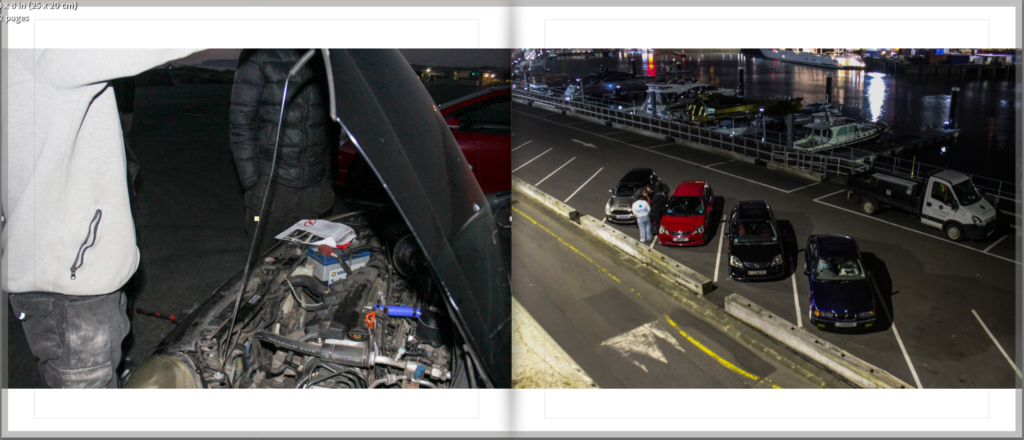
My images start off dark to link to how my documentary started, I have left white margins on all my pages to allow some space for noting, I felt that what I was doing was very heavy on which made it hard to keep focus and attention and I think that these margins help with that. My first image is one of them looking within a bonnet of a car and assessing work that they have just completed doing. The reason I chose this as my first image is because you can clearly see people gathered around to look, and I think that this connotates the idea of unity within the car scene very well. My second image is of all of their cars together, showing how no matter what they drive it still unites them all, and how they have created a friendship which stemmed on working on cars and helping each other with mods.
3rd Double Page Spread-
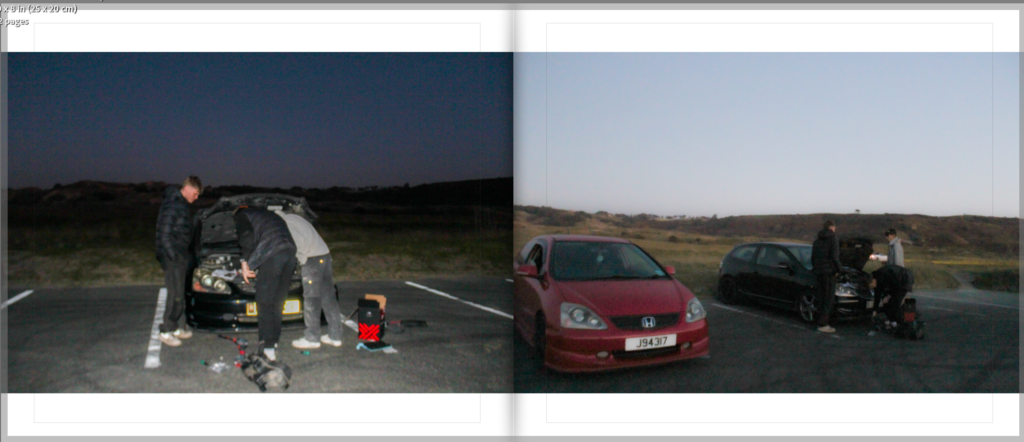
My third page spread start off with an image of them looking in the same bonnet as my first image, I have added this to create a wider viewpoint and clearly show how if they didn’t unite and work together then nothing would ever get done. My second image on this page spread shows how they have parked together, with the same car but he has left his car to go and help his friend, and it shows that dispersion from the love of your own car and wanting help on your own car to that kindness of helping others. All of these reasons are why I have chosen these images as they have a lighter background with a faded sunset, and they seem to be blurry and almost angelic like, showing the fade from just loving your own car to friendship.
4th Double Page Spread-
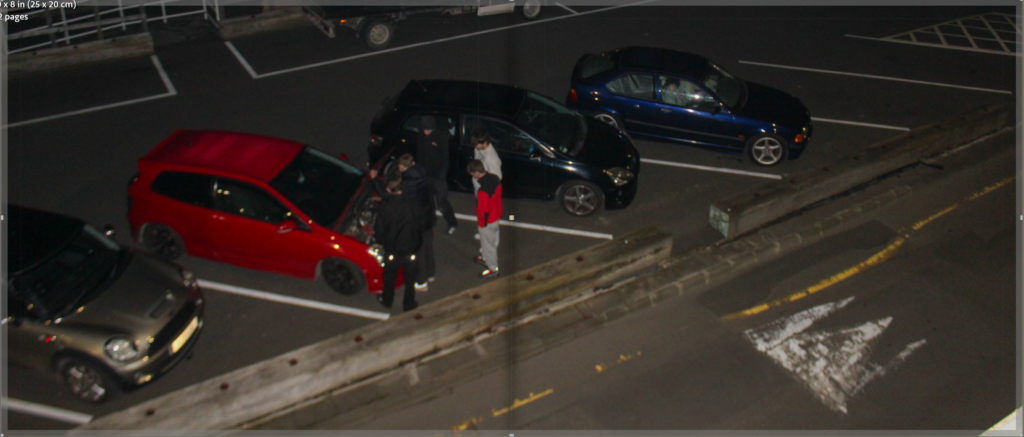
My fourth page spread consists of one image spread across the two pages from a bird’s eye view. I have done this to create a linking standpoint as my next pages are going to be text. This creates a break between the sets of photography and the close ups to a white background filled with text. By doing this I allow the viewers mind to break off and feel this shift. The image itself is quite dark, but it links back to that idea of all owning completely different cars to one another yet still all being friends. The idea of no judgment within the group. I chose this image as it contains all of them huddled together around one open bonnet. Providing more evidence of how they work together to create a special union.
5th Double Page Spread-
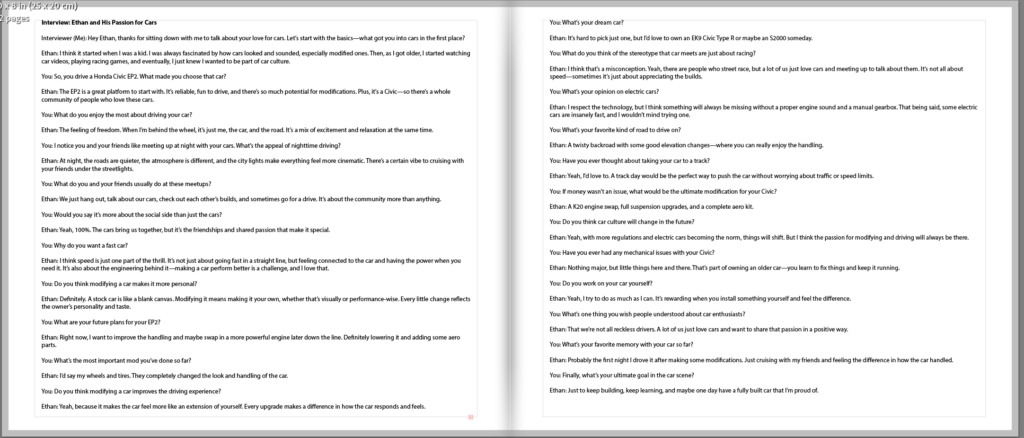
My fifth page spread contains my first interview which I have already analysed within my interview analysis blog post.
6th Double Page Spread-
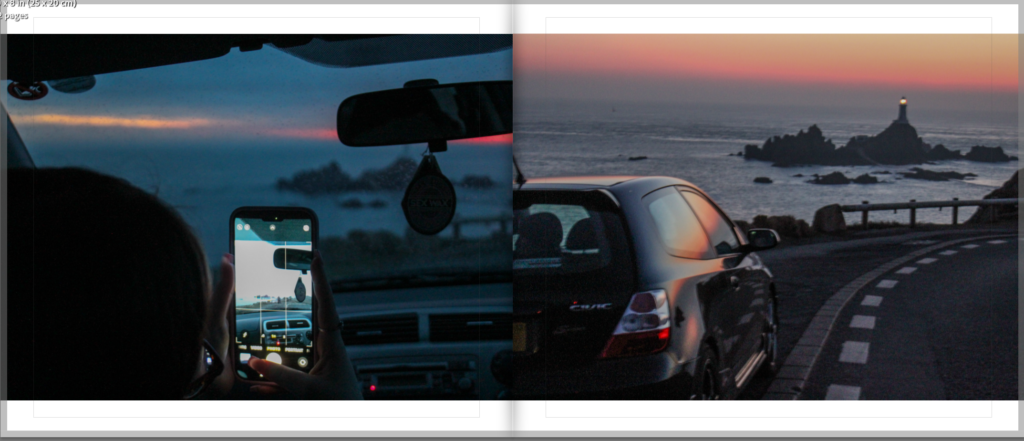
My fifth page spread starts with an image of someone taking a photo using their phone. This shows how the working together on the cars leads to more intimate experiences of being able to go out and enjoy the car together. This is also where my images start to get a bit lighter which corresponds with my video. The second image on this page spread is the outside view of what’s happening within the car, allowing a clear view of how if they didn’t work together to get the car running smoothly they wouldn’t be able to have experiences like this. In a way it is also showing off the car to show that all the work that they have done has improved this one drivers life / driving experience.
7th Double Page Spread-
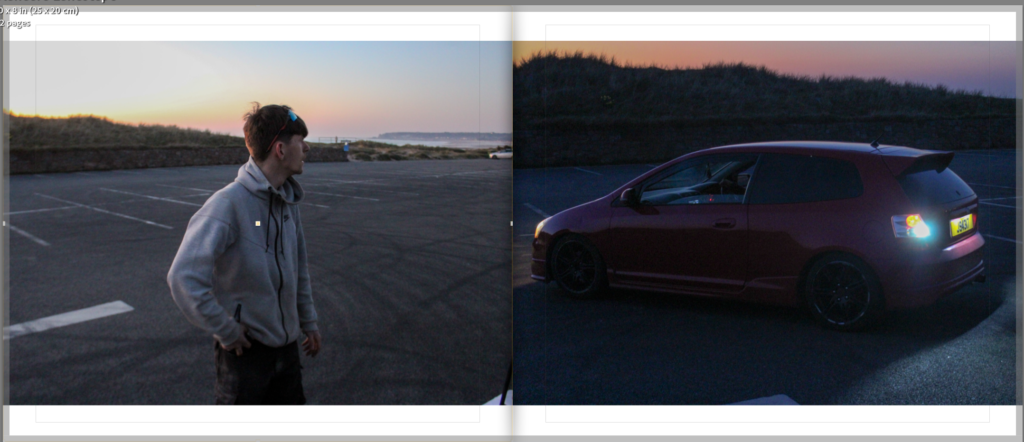
The first image within this spread contains a half body image, showing a more personal side to this journey. It allocated for some expression of personality which is important when trying to document how all these different people link up together. The second image contains a car pulling up and reversing, I have put the two together to show how they wait and rely on each other, creating unification where no progress would be made without it.
8th Double Page Spread-
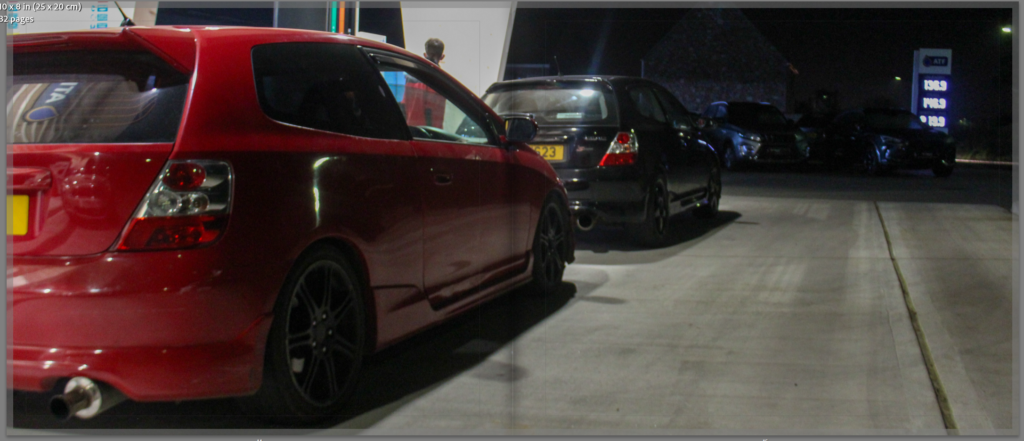
This double page spread is where the story line links back around to another shift to the next interview, by doing this I am keeping to that smooth clear and consistent pattern of repetition. The image itself is of the two people and their cars who I have just clearly focused on and locked into, the image links back to that calmness of filling up the cars, doing something which is basic and mandatory before the next rush of expression through personality.
9th Page Spread-
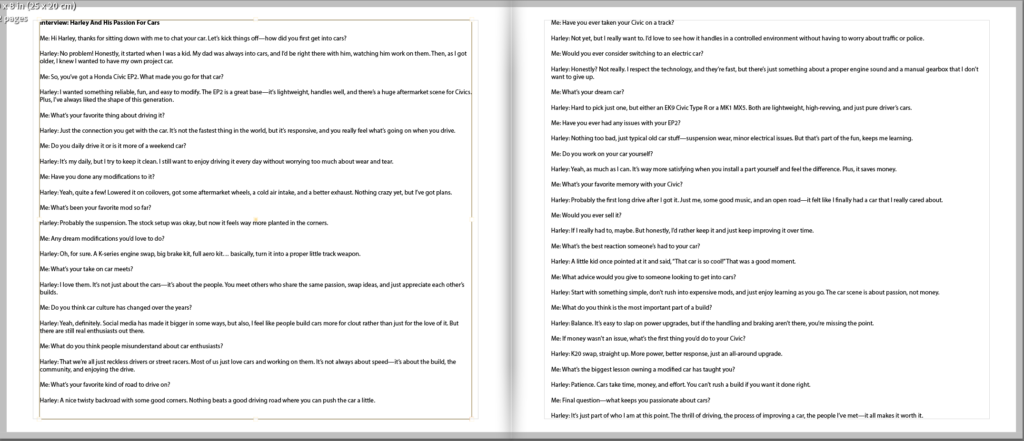
My ninth page spread contains my second interview which I have already analysed within my interview analysis blog post.
10th Page Spread-
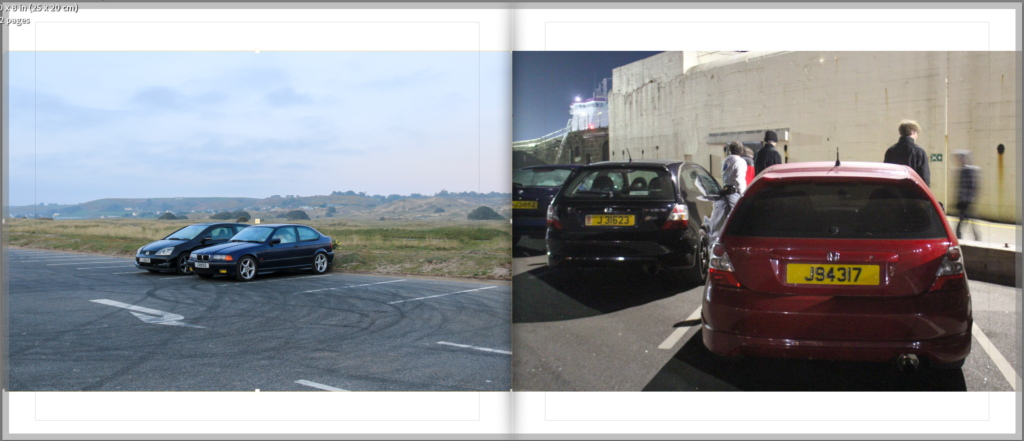
I have used two similar photos within different settings for this page spread. The first image is one that is angled at an overview, seeing the progress that they have , made from far away, whereas the second one is angled very up close. By doing this I have created the illusion of them showing off these cars and their final products, and by keeping the cars within the images consistent it proves how this group will meet up almost everyday and do something car related. Whether that be gng on a drive, working on there cars or even just parking up and sitting in them. The first image is in very bright weather, to show how they generally get more busy at night which is stated within my interview, and the second image is in the dark with a background blur of them playing football, to show how they don’t need the cars to unite them.
11th Page Spread-

The first image on this spread is an upclose shot of the wheel, showing a deeper perspective of these cars by focusing on branding, this is so that who reads the book can link up within their minds who owns which car. The second image is a car which hasn’t been seen before within the book, this is to show the expansion, of how these cars have made them meet new people. Both the images are within the day to correlate to my video.
12th Page Spread-
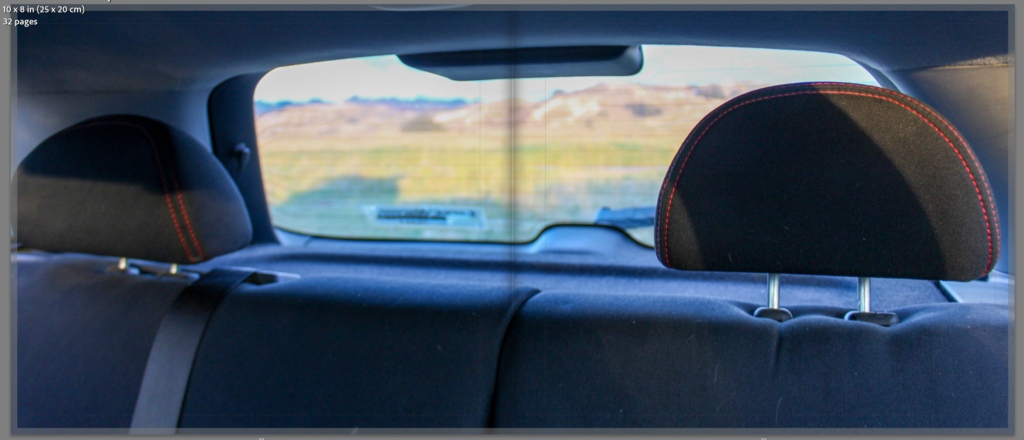
This is where my book yet again links around to another interview. I have used this as an opportunity to utilize an image that I took within the car. A landscape and environmental image to show a shift of how the book is almost coming to a close.
13th Page Spread-
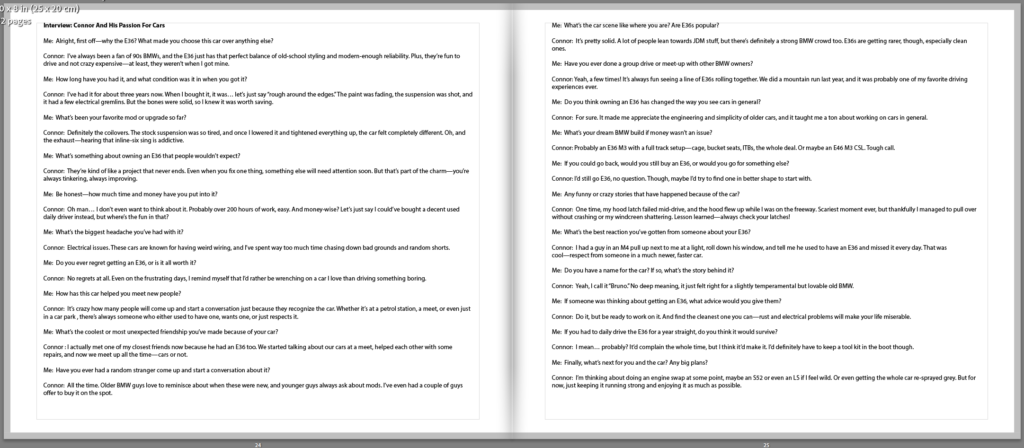
My thirteenth page spread contains my third and final interview which I have already analysed within my interview analysis blog post.
14th Page Spread-
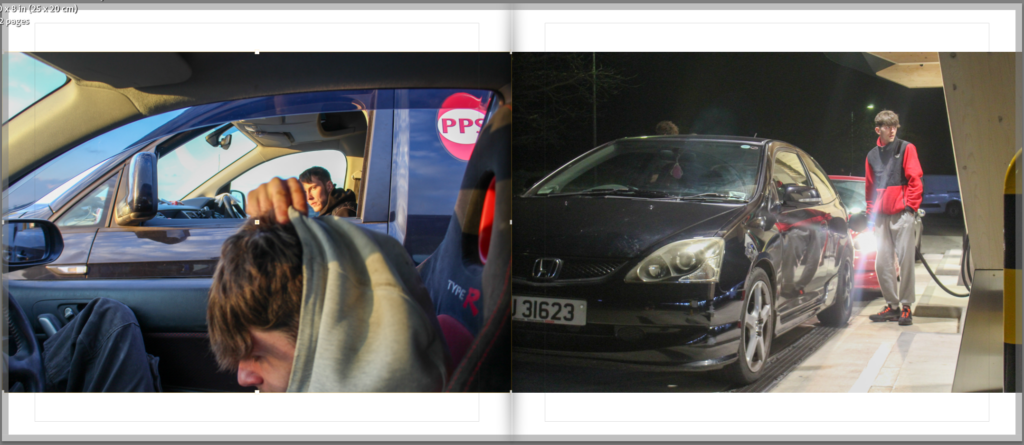
This page spread starts off with another image within the car, linking back to that double page spread before the interview. The reason that I have done this is to show how this group genuinely enjoy eachothers company and just like to sit in silence on their phones around another. They aren’t just friends to use each other to work on cars, they do genuinely get along as people. The second image on this spread links back to the calm of filling up the car, I have chosen to out many different angles of this within my book because I want to portray how this calmness actually means so much. Filling up the car is a staple and without it they wouldn’t be able to meet each other or do any of the work that they do.
15th Page Spread-
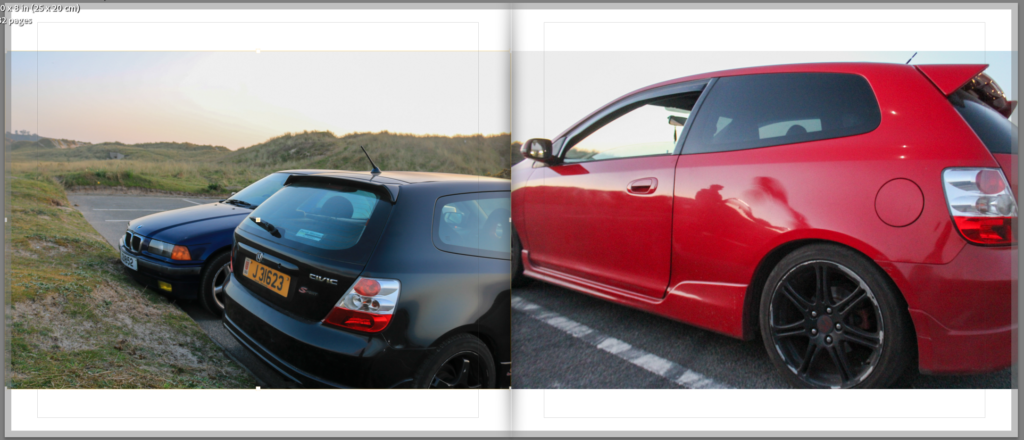
My last two image page spread consists of close ups of all the cars of the three people I have interviewed showing how the behind the scenes story is coming to an end and that they will continue to spend time together.
16th Page Spread-

My last page spread shows a final close up of the cars, reeling the story in.
Edits-
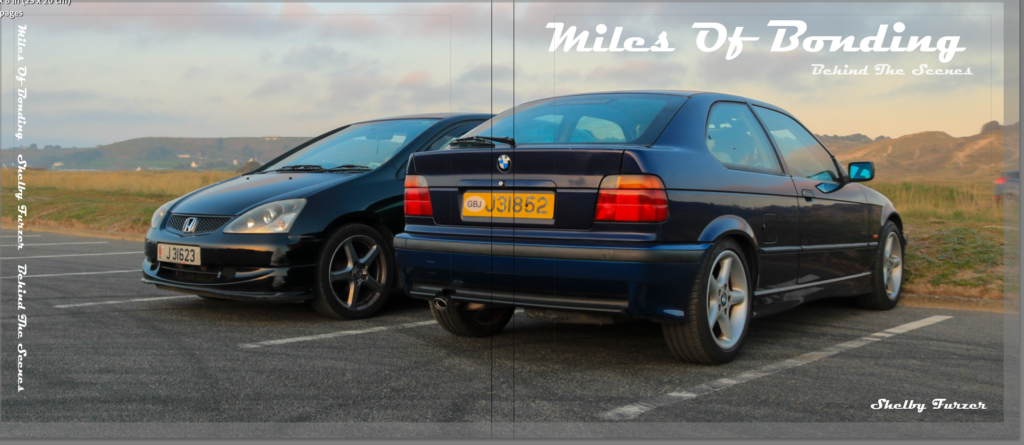
I ended up changing my front cover as I think that this image suited the title more, and I think that it was an overall better image.
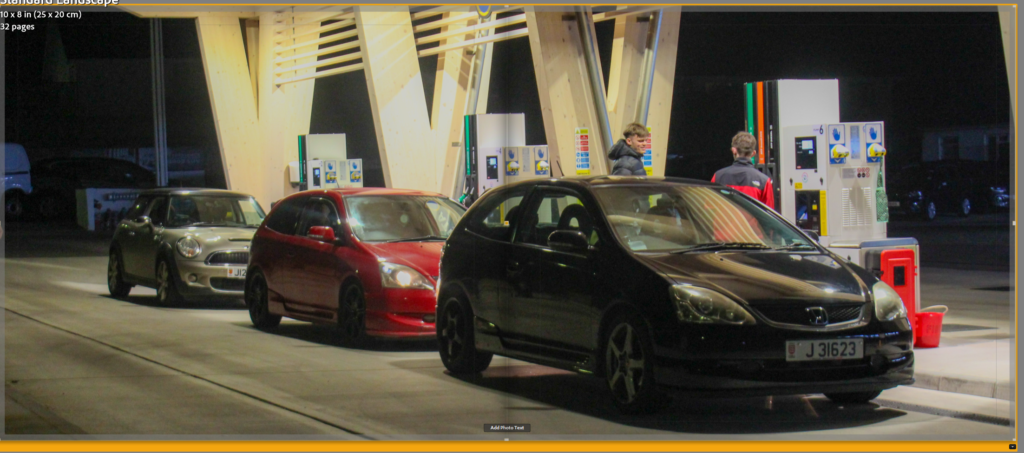
Which in turn meant that I had to change my last page to this image.
I also changed all of my single images with the white backgrounds to have a 4% zoom so that I could cover up some of that white background.
End Result-
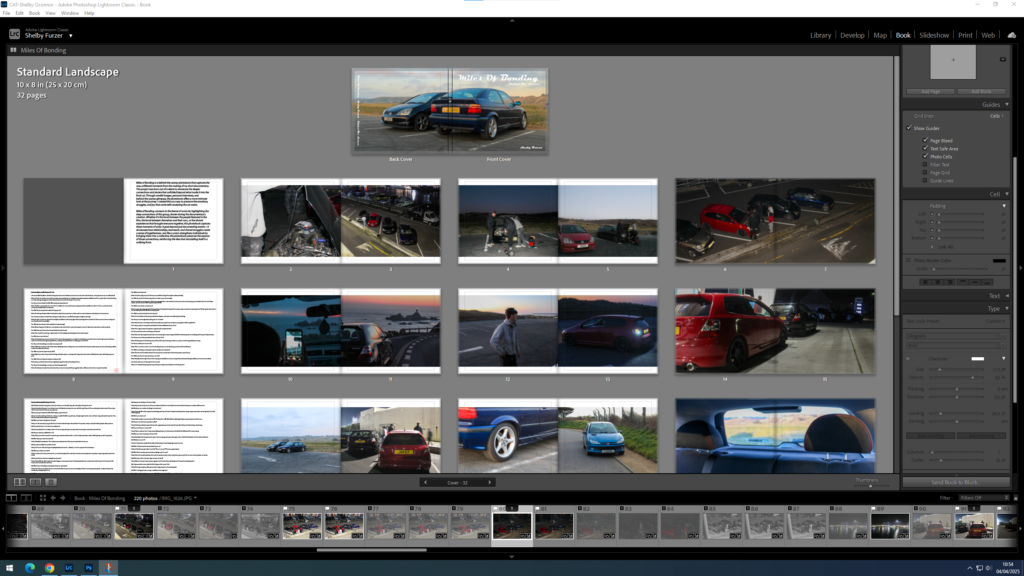

I overall think that my book making went extremely well and that I achieved my goal of making some behind the scenes content. I think that I have a good composition of images, and that all my images clearly flow together to create a much bigger picture. I don’t think that my short documentary could be read the same way if I didn’t add this short photobook to clear up some context and create a bassline structure. Creating this book has helped me to structure my video in a clear and consistent sense.
Interview/Text Evaluation-
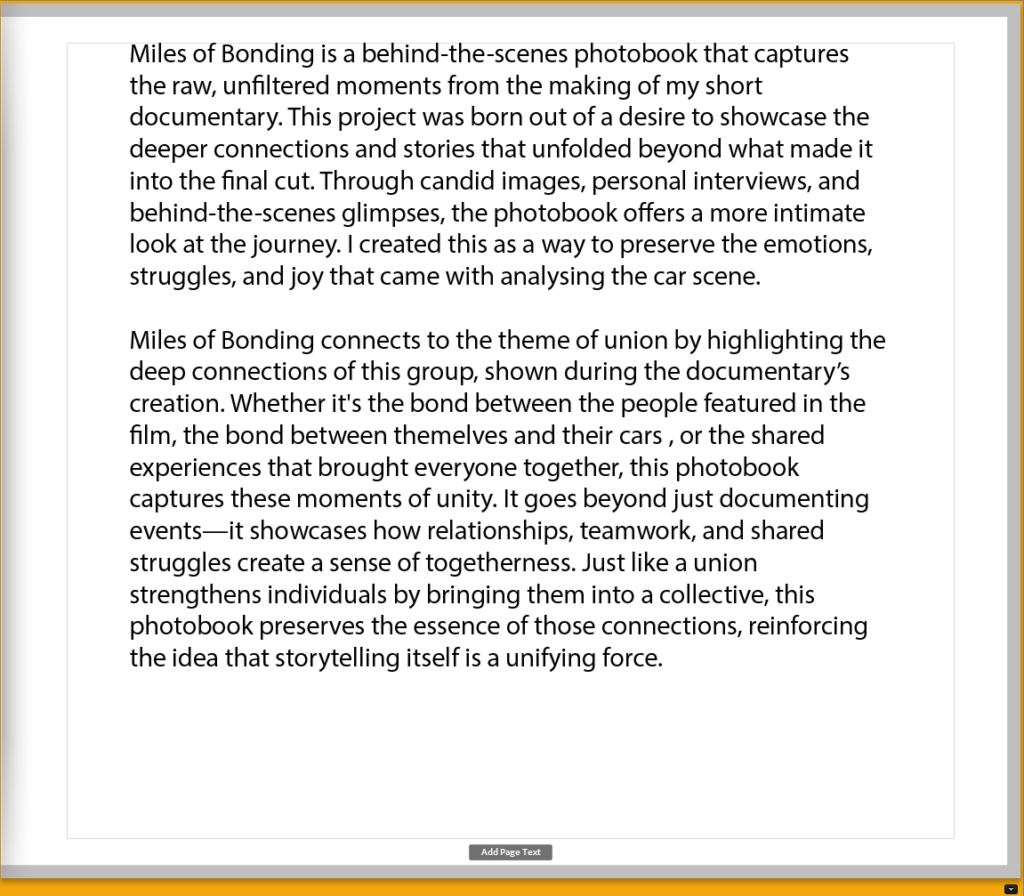
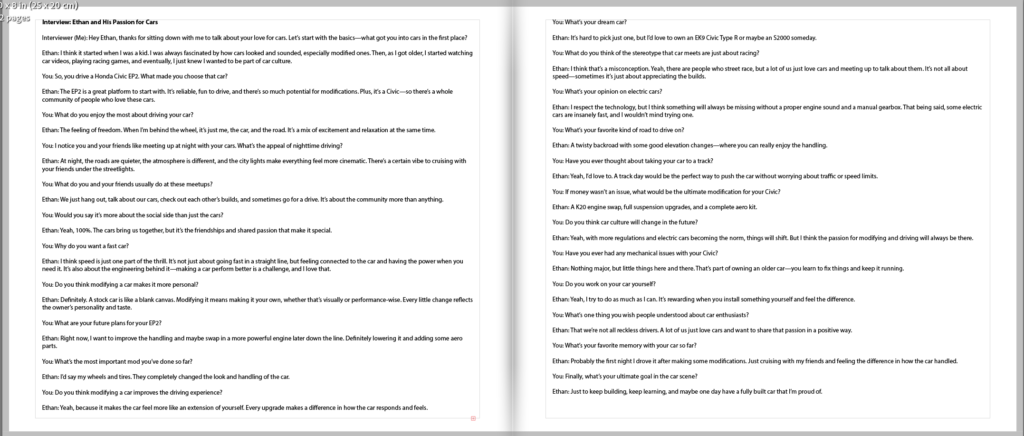

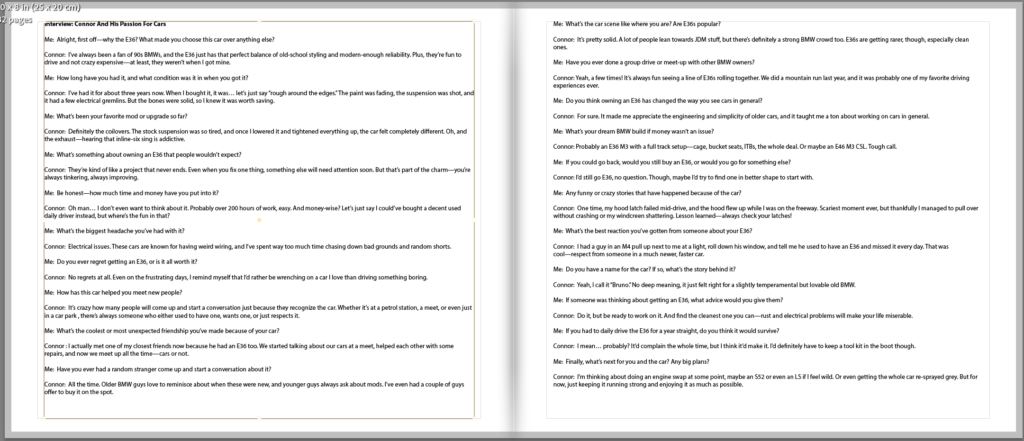
Interviews In Full-
Interview: Ethan and His Passion for Cars
Interviewer (Me): Hey Ethan, thanks for sitting down with me to talk about your love for cars. Let’s start with the basics—what got you into cars in the first place?
Ethan: I think it started when I was a kid. I was always fascinated by how cars looked and sounded, especially modified ones. Then, as I got older, I started watching car videos, playing racing games, and eventually, I just knew I wanted to be part of car culture.
You: So, you drive a Honda Civic EP2. What made you choose that car?
Ethan: The EP2 is a great platform to start with. It’s reliable, fun to drive, and there’s so much potential for modifications. Plus, it’s a Civic—so there’s a whole community of people who love these cars.
You: What do you enjoy the most about driving your car?
Ethan: The feeling of freedom. When I’m behind the wheel, it’s just me, the car, and the road. It’s a mix of excitement and relaxation at the same time.
You: I notice you and your friends like meeting up at night with your cars. What’s the appeal of nighttime driving?
Ethan: At night, the roads are quieter, the atmosphere is different, and the city lights make everything feel more cinematic. There’s a certain vibe to cruising with your friends under the streetlights.
You: What do you and your friends usually do at these meetups?
Ethan: We just hang out, talk about our cars, check out each other’s builds, and sometimes go for a drive. It’s about the community more than anything.
You: Would you say it’s more about the social side than just the cars?
Ethan: Yeah, 100%. The cars bring us together, but it’s the friendships and shared passion that make it special.
You: Why do you want a fast car?
Ethan: I think speed is just one part of the thrill. It’s not just about going fast in a straight line, but feeling connected to the car and having the power when you need it. It’s also about the engineering behind it—making a car perform better is a challenge, and I love that.
You: Do you think modifying a car makes it more personal?
Ethan: Definitely. A stock car is like a blank canvas. Modifying it means making it your own, whether that’s visually or performance-wise. Every little change reflects the owner’s personality and taste.
You: What are your future plans for your EP2?
Ethan: Right now, I want to improve the handling and maybe swap in a more powerful engine later down the line. Definitely lowering it and adding some aero parts.
You: What’s the most important mod you’ve done so far?
Ethan: I’d say my wheels and tires. They completely changed the look and handling of the car.
You: Do you think modifying a car improves the driving experience?
Ethan: Yeah, because it makes the car feel more like an extension of yourself. Every upgrade makes a difference in how the car responds and feels.You: What’s your dream car?
Ethan: It’s hard to pick just one, but I’d love to own an EK9 Civic Type R or maybe an S2000 someday.
You: What do you think of the stereotype that car meets are just about racing?
Ethan: I think that’s a misconception. Yeah, there are people who street race, but a lot of us just love cars and meeting up to talk about them. It’s not all about speed—sometimes it’s just about appreciating the builds.
You: What’s your opinion on electric cars?
Ethan: I respect the technology, but I think something will always be missing without a proper engine sound and a manual gearbox. That being said, some electric cars are insanely fast, and I wouldn’t mind trying one.
You: What’s your favorite kind of road to drive on?
Ethan: A twisty backroad with some good elevation changes—where you can really enjoy the handling.
You: Have you ever thought about taking your car to a track?
Ethan: Yeah, I’d love to. A track day would be the perfect way to push the car without worrying about traffic or speed limits.
You: If money wasn’t an issue, what would be the ultimate modification for your Civic?
Ethan: A K20 engine swap, full suspension upgrades, and a complete aero kit.
You: Do you think car culture will change in the future?
Ethan: Yeah, with more regulations and electric cars becoming the norm, things will shift. But I think the passion for modifying and driving will always be there.
You: Have you ever had any mechanical issues with your Civic?
Ethan: Nothing major, but little things here and there. That’s part of owning an older car—you learn to fix things and keep it running.
You: Do you work on your car yourself?
Ethan: Yeah, I try to do as much as I can. It’s rewarding when you install something yourself and feel the difference.
You: What’s one thing you wish people understood about car enthusiasts?
Ethan: That we’re not all reckless drivers. A lot of us just love cars and want to share that passion in a positive way.
You: What’s your favorite memory with your car so far?
Ethan: Probably the first night I drove it after making some modifications. Just cruising with my friends and feeling the difference in how the car handled.
You: Finally, what’s your ultimate goal in the car scene?
Ethan: Just to keep building, keep learning, and maybe one day have a fully built car that I’m proud of.
Interview: Harley And His Passion For Cars
Me: Hi Harley, thanks for sitting down with me to chat your car. Let’s kick things off—how did you first get into cars?
Harley: No problem! Honestly, it started when I was a kid. My dad was always into cars, and I’d be right there with him, watching him work on them. Then, as I got older, I knew I wanted to have my own project car.
Me: So, you’ve got a Honda Civic EP2. What made you go for that car?
Harley: I wanted something reliable, fun, and easy to modify. The EP2 is a great base—it’s lightweight, handles well, and there’s a huge aftermarket scene for Civics. Plus, I’ve always liked the shape of this generation.
Me: What’s your favorite thing about driving it?
Harley: Just the connection you get with the car. It’s not the fastest thing in the world, but it’s responsive, and you really feel what’s going on when you drive.
Me: Do you daily drive it or is it more of a weekend car?
Harley: It’s my daily, but I try to keep it clean. I still want to enjoy driving it every day without worrying too much about wear and tear.
Me: Have you done any modifications to it?
Harley: Yeah, quite a few! Lowered it on coilovers, got some aftermarket wheels, a cold air intake, and a better exhaust. Nothing crazy yet, but I’ve got plans.
Me: What’s been your favorite mod so far?
Harley: Probably the suspension. The stock setup was okay, but now it feels way more planted in the corners.
Me: Any dream modifications you’d love to do?
Harley: Oh, for sure. A K-series engine swap, big brake kit, full aero kit… basically, turn it into a proper little track weapon.
Me: What’s your take on car meets?
Harley: I love them. It’s not just about the cars—it’s about the people. You meet others who share the same passion, swap ideas, and just appreciate each other’s builds.
Me: Do you think car culture has changed over the years?
Harley: Yeah, definitely. Social media has made it bigger in some ways, but also, I feel like people build cars more for clout rather than just for the love of it. But there are still real enthusiasts out there.
Me: What do you think people misunderstand about car enthusiasts?
Harley: That we’re all just reckless drivers or street racers. Most of us just love cars and working on them. It’s not always about speed—it’s about the build, the community, and enjoying the drive.
Me: What’s your favorite kind of road to drive on?
Harley: A nice twisty backroad with some good corners. Nothing beats a good driving road where you can push the car a little.Me: Have you ever taken your Civic on a track?
Harley: Not yet, but I really want to. I’d love to see how it handles in a controlled environment without having to worry about traffic or police.
Me: Would you ever consider switching to an electric car?
Harley: Honestly? Not really. I respect the technology, and they’re fast, but there’s just something about a proper engine sound and a manual gearbox that I don’t want to give up.
Me: What’s your dream car?
Harley: Hard to pick just one, but either an EK9 Civic Type R or a MK1 MX5. Both are lightweight, high-revving, and just pure driver’s cars.
Me: Have you ever had any issues with your EP2?
Harley: Nothing too bad, just typical old car stuff—suspension wear, minor electrical issues. But that’s part of the fun, keeps me learning.
Me: Do you work on your car yourself?
Harley: Yeah, as much as I can. It’s way more satisfying when you install a part yourself and feel the difference. Plus, it saves money.
Me: What’s your favorite memory with your Civic?
Harley: Probably the first long drive after I got it. Just me, some good music, and an open road—it felt like I finally had a car that I really cared about.
Me: Would you ever sell it?
Harley: If I really had to, maybe. But honestly, I’d rather keep it and just keep improving it over time.
Me: What’s the best reaction someone’s had to your car?
Harley: A little kid once pointed at it and said, “That car is so cool!” That was a good moment.
Me: What advice would you give to someone looking to get into cars?
Harley: Start with something simple, don’t rush into expensive mods, and just enjoy learning as you go. The car scene is about passion, not money.
Me: What do you think is the most important part of a build?
Harley: Balance. It’s easy to slap on power upgrades, but if the handling and braking aren’t there, you’re missing the point.
Me: If money wasn’t an issue, what’s the first thing you’d do to your Civic?
Harley: K20 swap, straight up. More power, better response, just an all-around upgrade.
Me: What’s the biggest lesson owning a modified car has taught you?
Harley: Patience. Cars take time, money, and effort. You can’t rush a build if you want it done right.
Me: Final question—what keeps you passionate about cars?
Harley: It’s just part of who I am at this point. The thrill of driving, the process of improving a car, the people I’ve met—it all makes it worth it.
Interview: Connor And His Passion For Cars
Me: Alright, first off—why the E36? What made you choose this car over anything else?
Connor: I’ve always been a fan of 90s BMWs, and the E36 just has that perfect balance of old-school styling and modern-enough reliability. Plus, they’re fun to drive and not crazy expensive—at least, they weren’t when I got mine.
Me: How long have you had it, and what condition was it in when you got it?
Connor: I’ve had it for about three years now. When I bought it, it was… let’s just say “rough around the edges.” The paint was fading, the suspension was shot, and it had a few electrical gremlins. But the bones were solid, so I knew it was worth saving.
Me: What’s been your favorite mod or upgrade so far?
Connor: Definitely the coilovers. The stock suspension was so tired, and once I lowered it and tightened everything up, the car felt completely different. Oh, and the exhaust—hearing that inline-six sing is addictive.
Me: What’s something about owning an E36 that people wouldn’t expect?
Connor: They’re kind of like a project that never ends. Even when you fix one thing, something else will need attention soon. But that’s part of the charm—you’re always tinkering, always improving.
Me: Be honest—how much time and money have you put into it?
Connor: Oh man… I don’t even want to think about it. Probably over 200 hours of work, easy. And money-wise? Let’s just say I could’ve bought a decent used daily driver instead, but where’s the fun in that?
Me: What’s the biggest headache you’ve had with it?
Connor: Electrical issues. These cars are known for having weird wiring, and I’ve spent way too much time chasing down bad grounds and random shorts.
Me: Do you ever regret getting an E36, or is it all worth it?
Connor: No regrets at all. Even on the frustrating days, I remind myself that I’d rather be wrenching on a car I love than driving something boring.
Me: How has this car helped you meet new people?
Connor: It’s crazy how many people will come up and start a conversation just because they recognize the car. Whether it’s at a petrol station, a meet, or even just in a car park , there’s always someone who either used to have one, wants one, or just respects it.
Me: What’s the coolest or most unexpected friendship you’ve made because of your car?
Connor : I actually met one of my closest friends now because he had an E36 too. We started talking about our cars at a meet, helped each other with some repairs, and now we meet up all the time—cars or not.
Me: Have you ever had a random stranger come up and start a conversation about it?
Connor: All the time. Older BMW guys love to reminisce about when these were new, and younger guys always ask about mods. I’ve even had a couple of guys offer to buy it on the spot.Me: What’s the car scene like where you are? Are E36s popular?
Connor: It’s pretty solid. A lot of people lean towards JDM stuff, but there’s definitely a strong BMW crowd too. E36s are getting rarer, though, especially clean ones.
Me: Have you ever done a group drive or meet-up with other BMW owners?
Connor: Yeah, a few times! It’s always fun seeing a line of E36s rolling together. We did a mountain run last year, and it was probably one of my favorite driving experiences ever.
Me: Do you think owning an E36 has changed the way you see cars in general?
Connor: For sure. It made me appreciate the engineering and simplicity of older cars, and it taught me a ton about working on cars in general.
Me: What’s your dream BMW build if money wasn’t an issue?
Connor: Probably an E36 M3 with a full track setup—cage, bucket seats, ITBs, the whole deal. Or maybe an E46 M3 CSL. Tough call.
Me: If you could go back, would you still buy an E36, or would you go for something else?
Connor: I’d still go E36, no question. Though, maybe I’d try to find one in better shape to start with.
Me: Any funny or crazy stories that have happened because of the car?
Connor: One time, my hood latch failed mid-drive, and the hood flew up while I was on the freeway. Scariest moment ever, but thankfully I managed to pull over without crashing or my windcreen shattering. Lesson learned—always check your latches!
Me: What’s the best reaction you’ve gotten from someone about your E36?
Connor: I had a guy in an M4 pull up next to me at a light, roll down his window, and tell me he used to have an E36 and missed it every day. That was cool—respect from someone in a much newer, faster car.
Me: Do you have a name for the car? If so, what’s the story behind it?
Connor: Yeah, I call it “Bruno.” No deep meaning, it just felt right for a slightly temperamental but lovable old BMW.
Me: If someone was thinking about getting an E36, what advice would you give them?
Connor: Do it, but be ready to work on it. And find the cleanest one you can—rust and electrical problems will make your life miserable.
Me: If you had to daily drive the E36 for a year straight, do you think it would survive?
Connor: I mean… probably? It’d complain the whole time, but I think it’d make it. I’d definitely have to keep a tool kit in the boot though.
Me: Finally, what’s next for you and the car? Any big plans?
Connor: I’m thinking about doing an engine swap at some point, maybe an S52 or even an LS if I feel wild. Or even getting the whole car re-sprayed grey. But for now, just keeping it running strong and enjoying it as much as possible.
Plan-

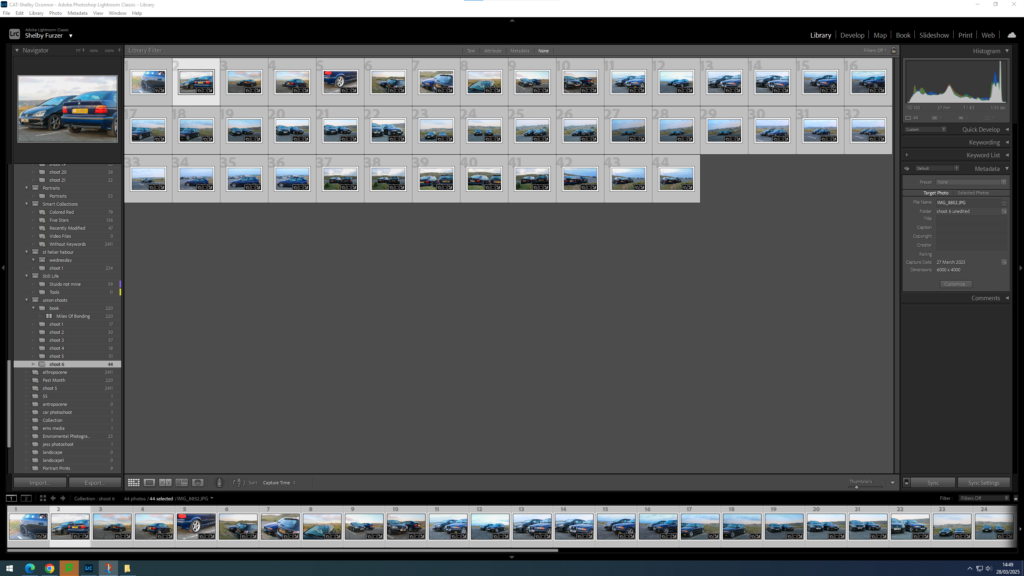
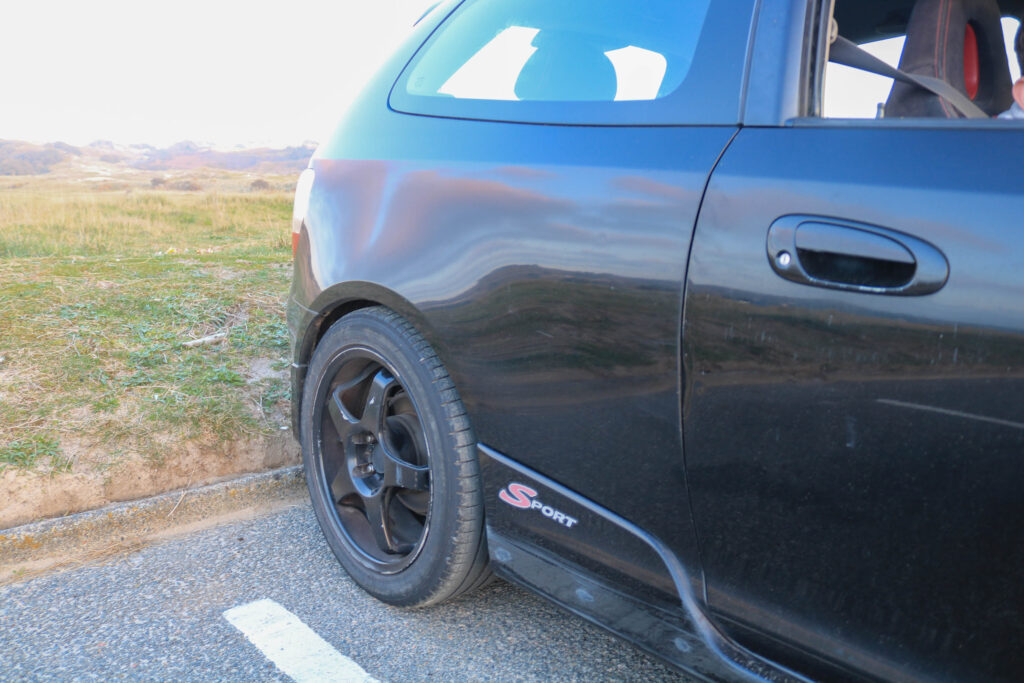
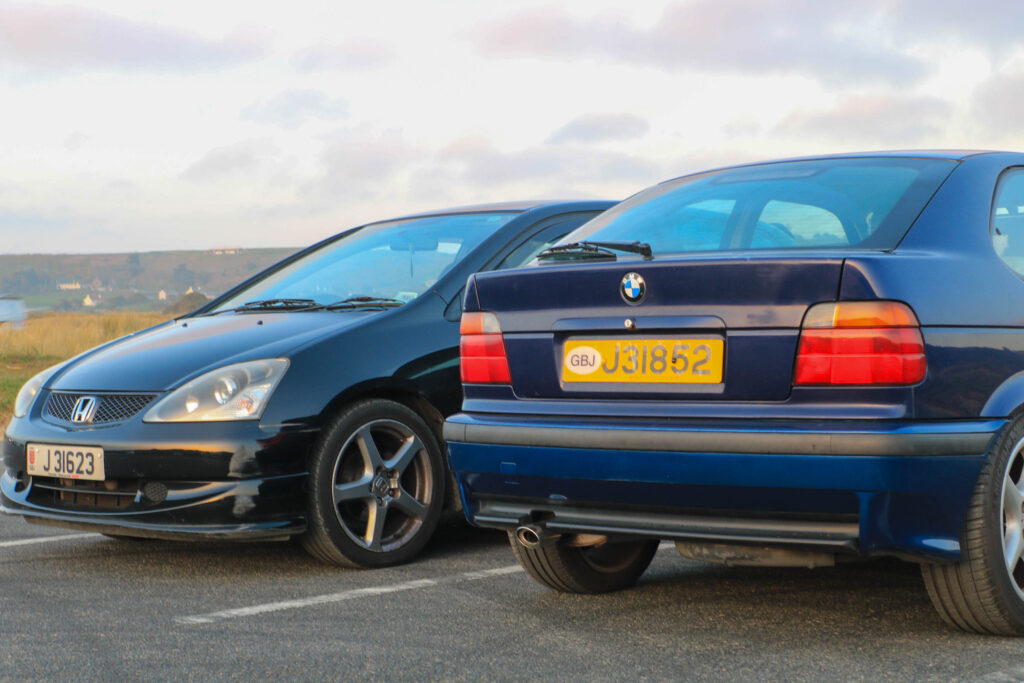
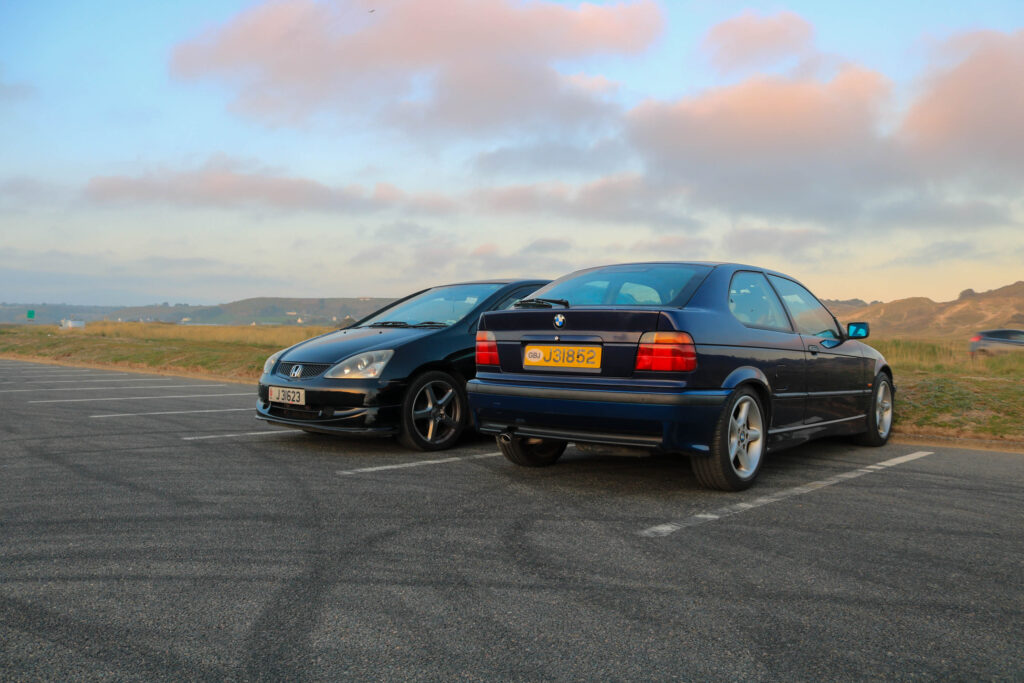
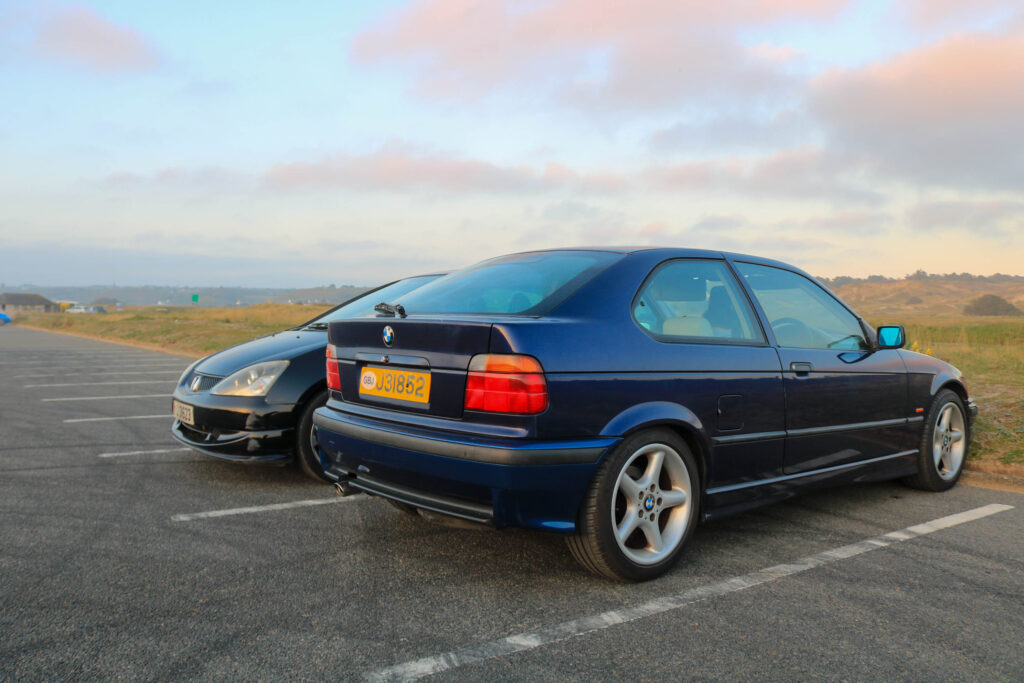
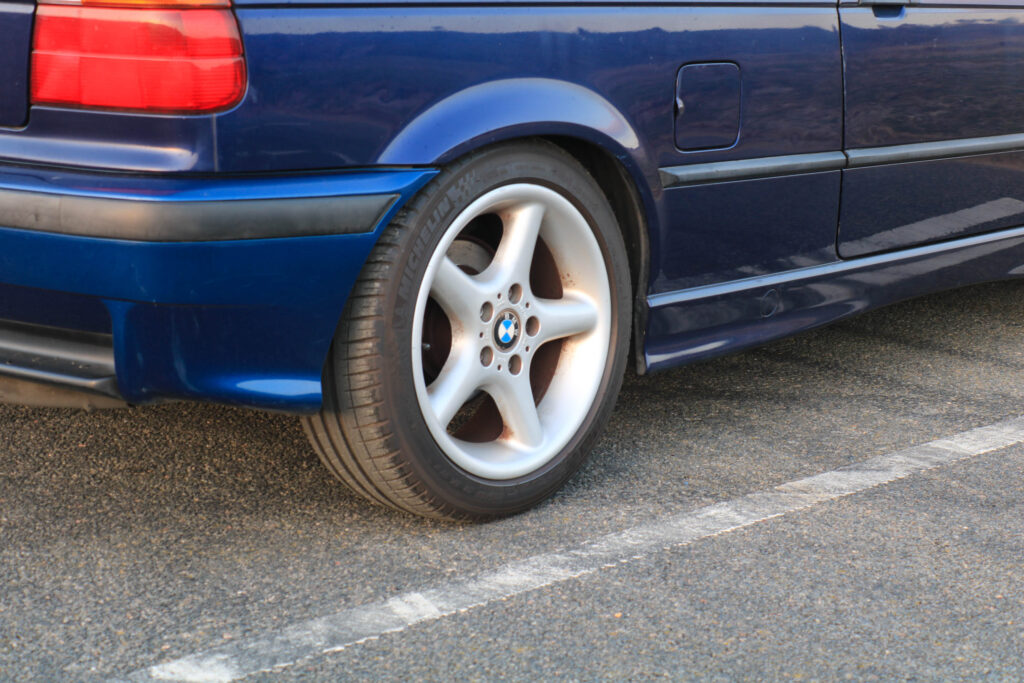
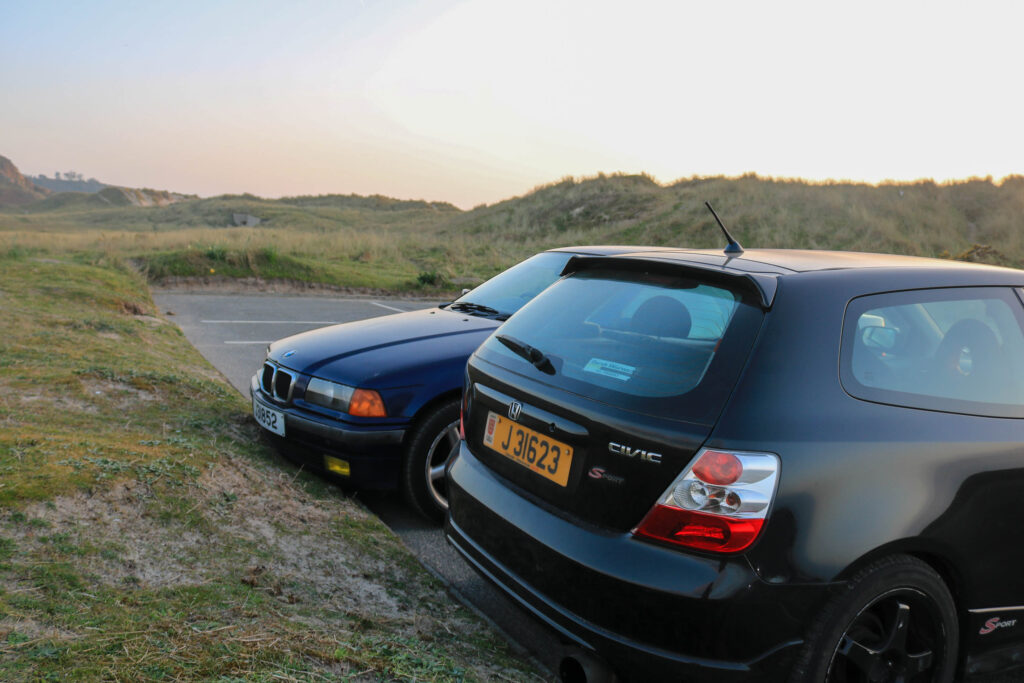
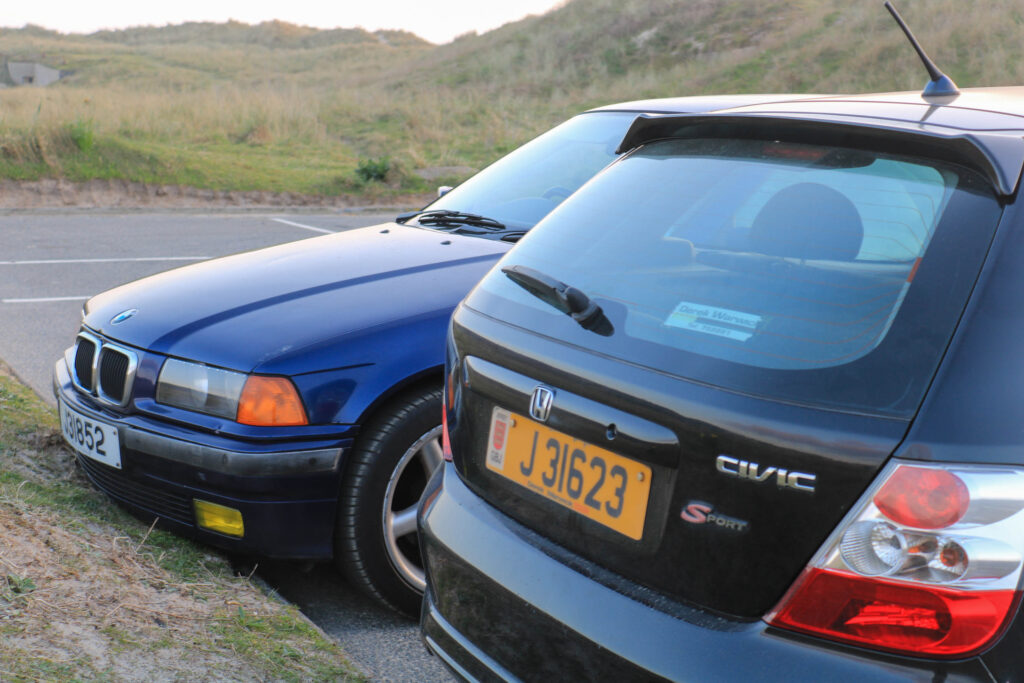
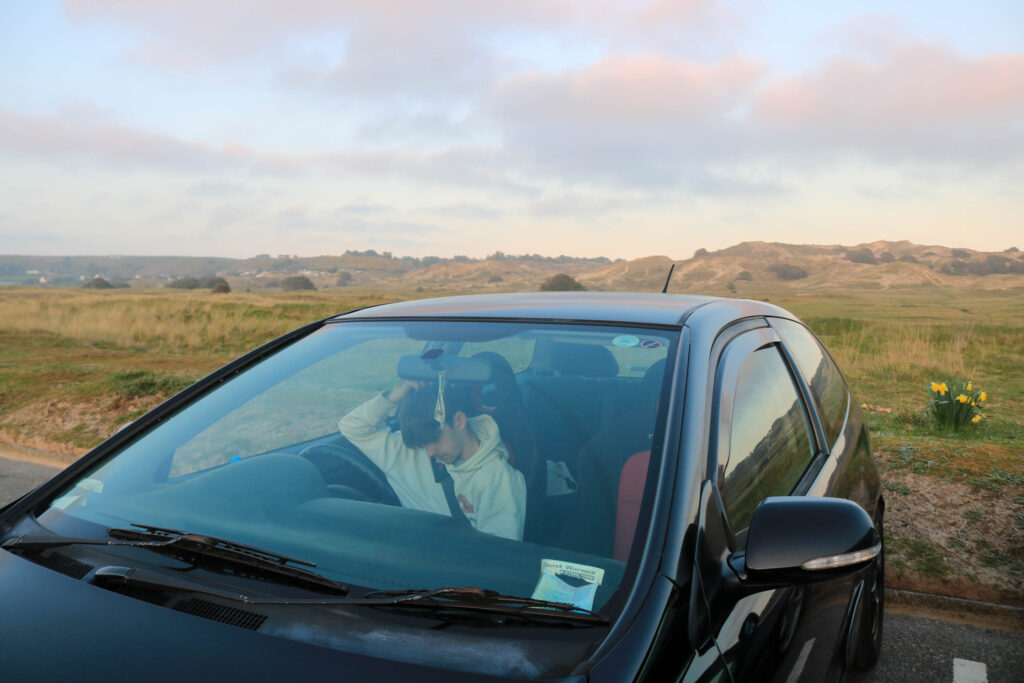
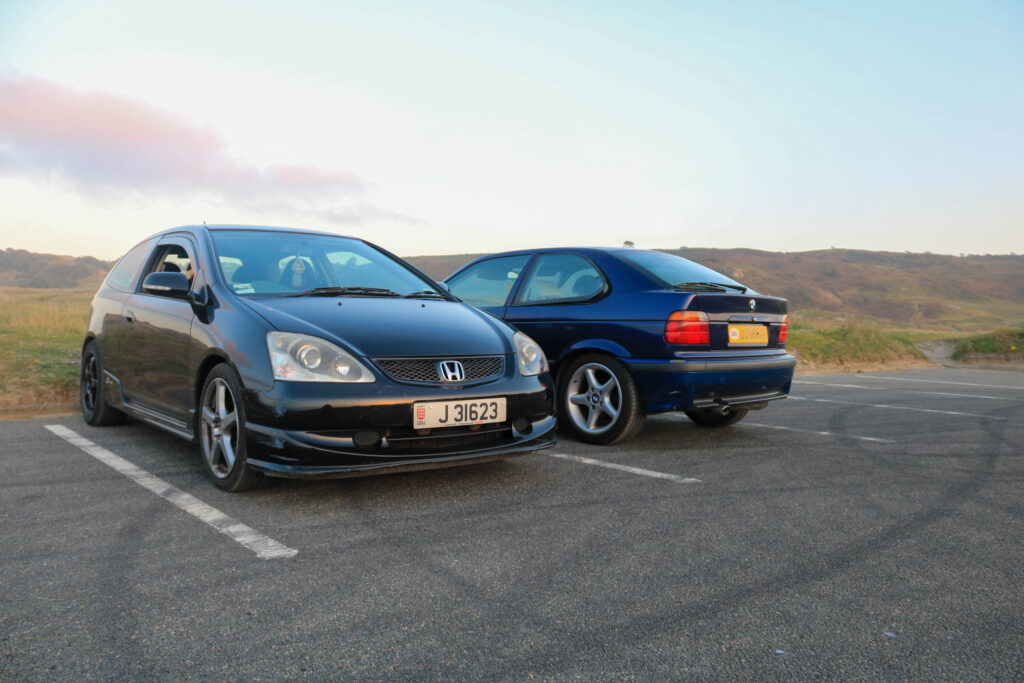
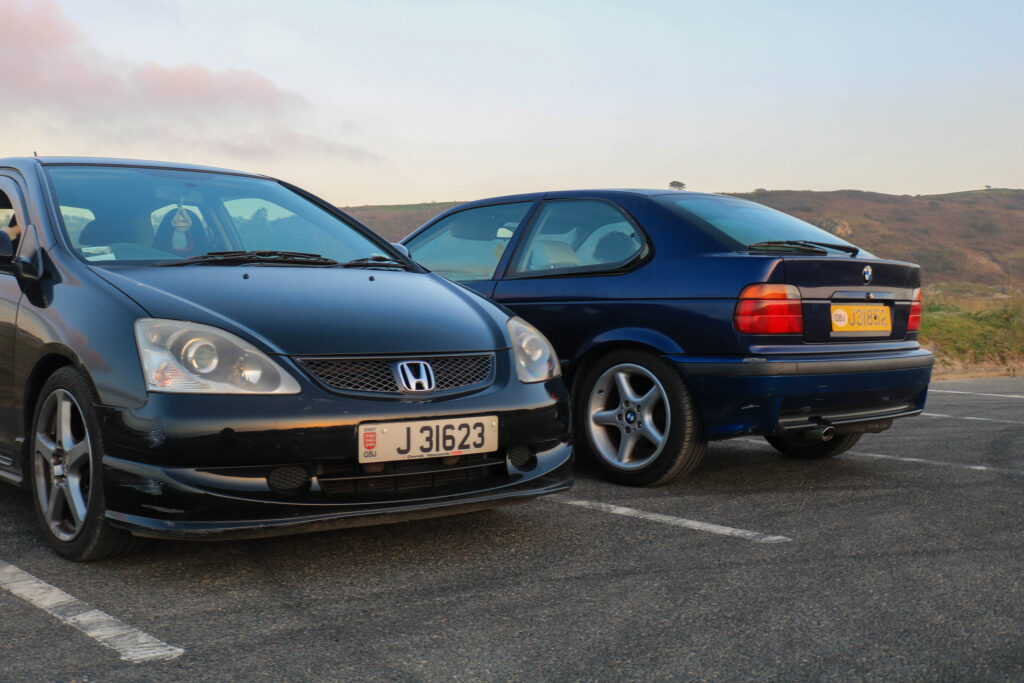
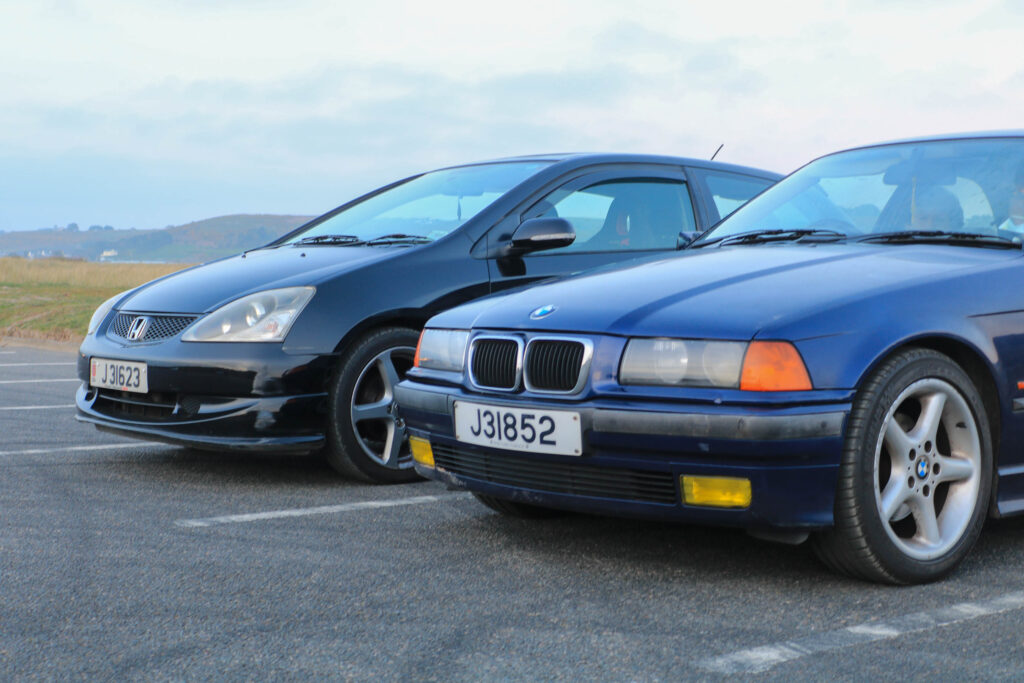
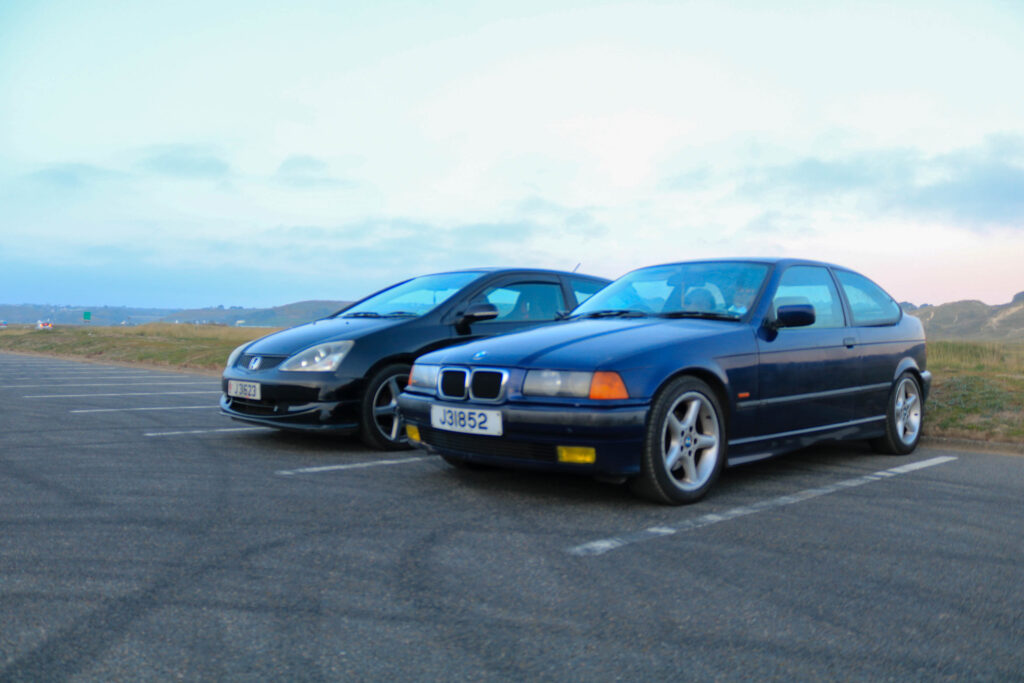
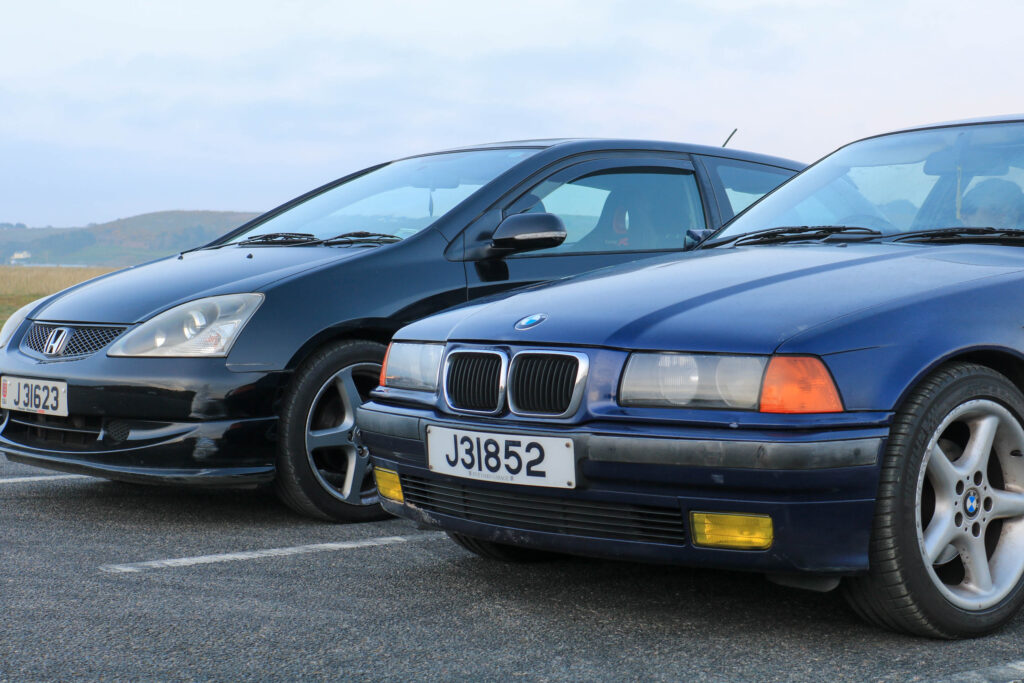

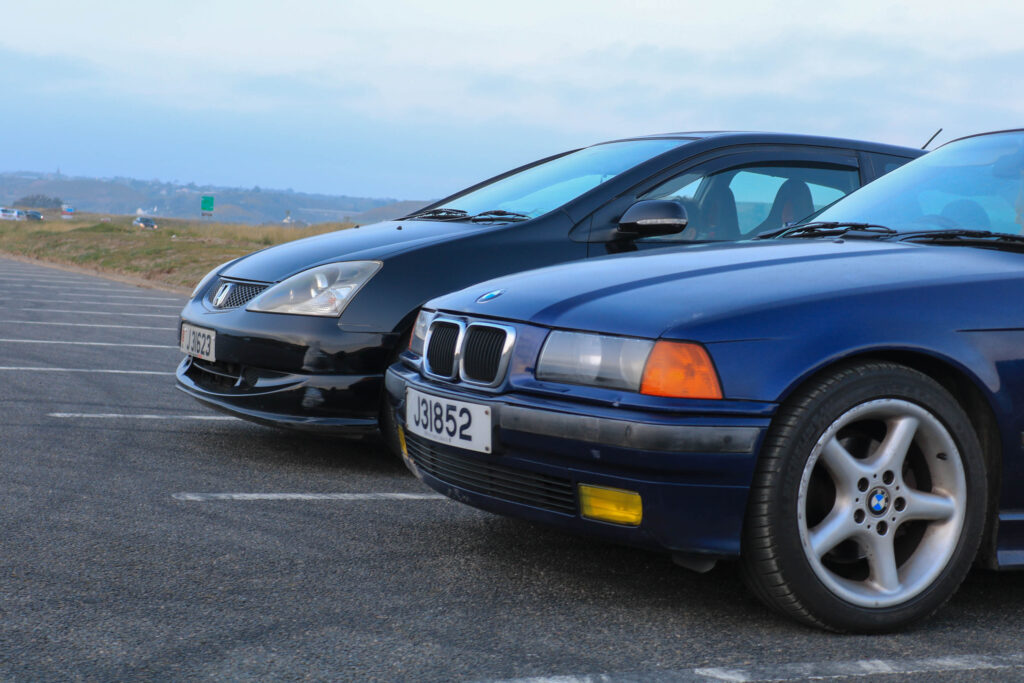
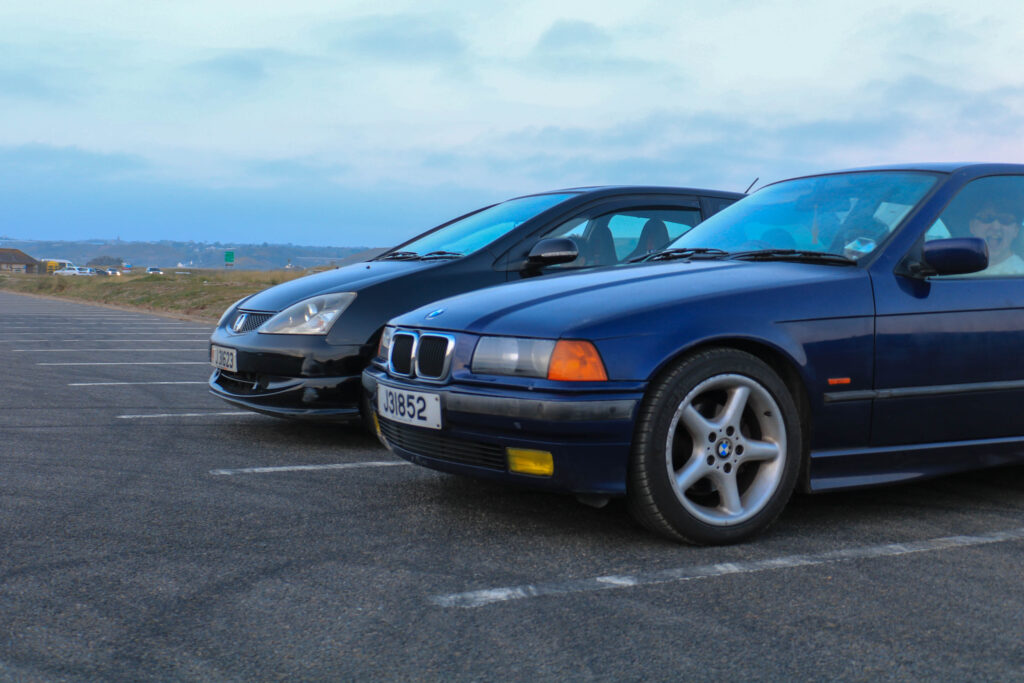

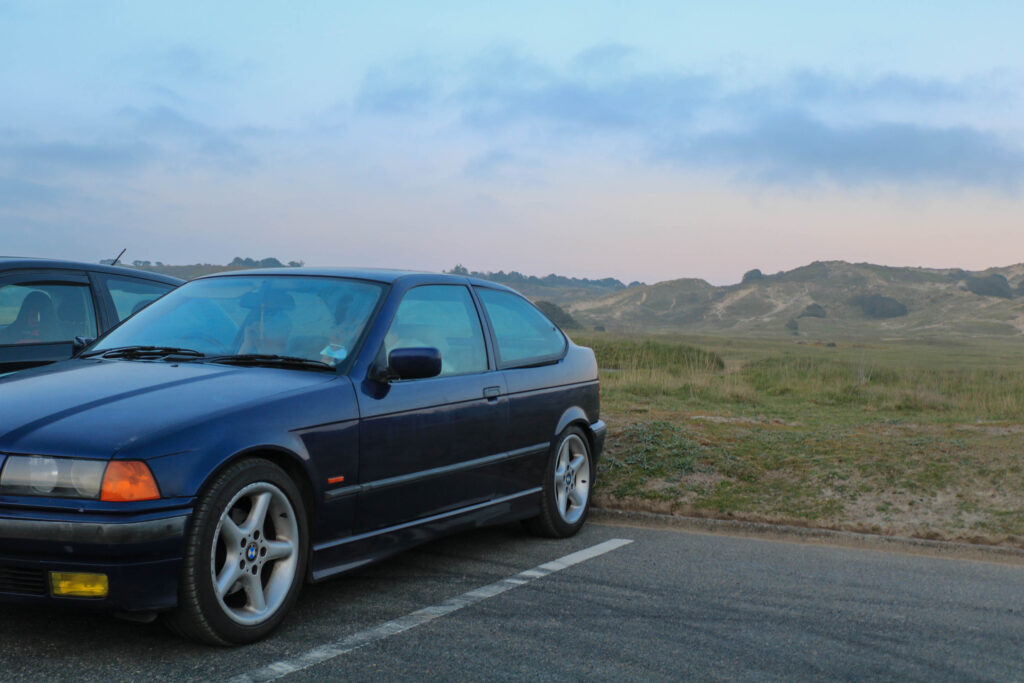
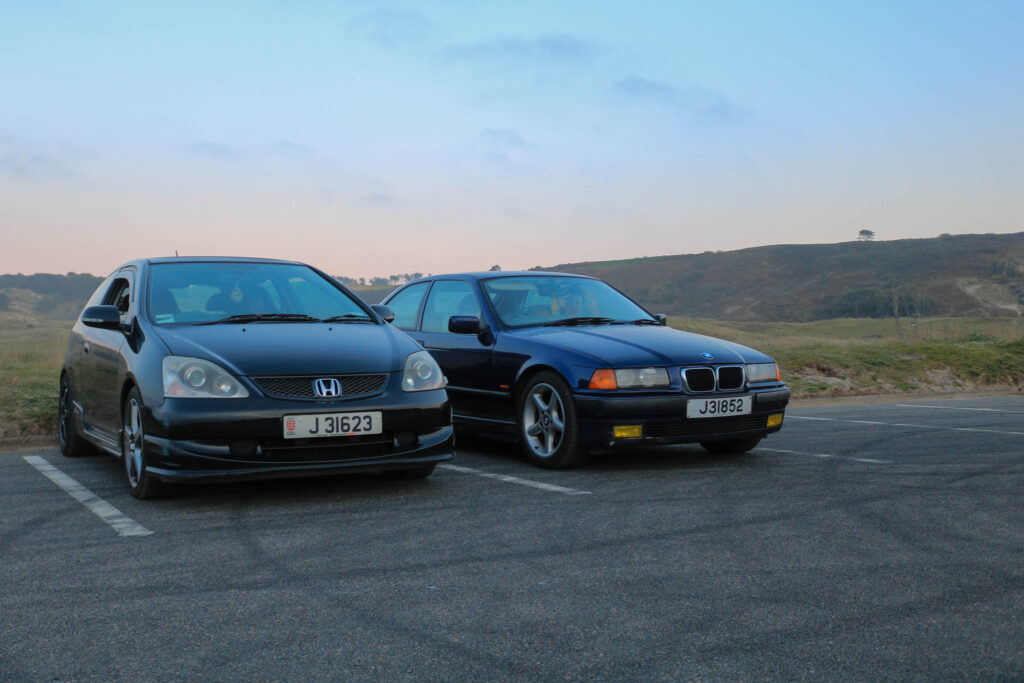

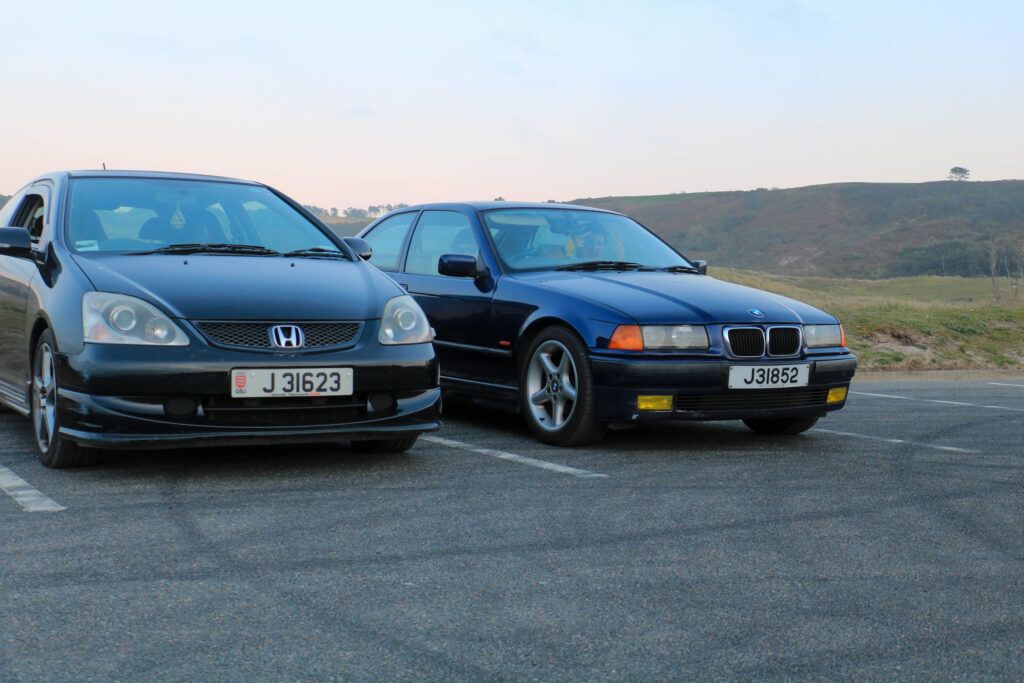
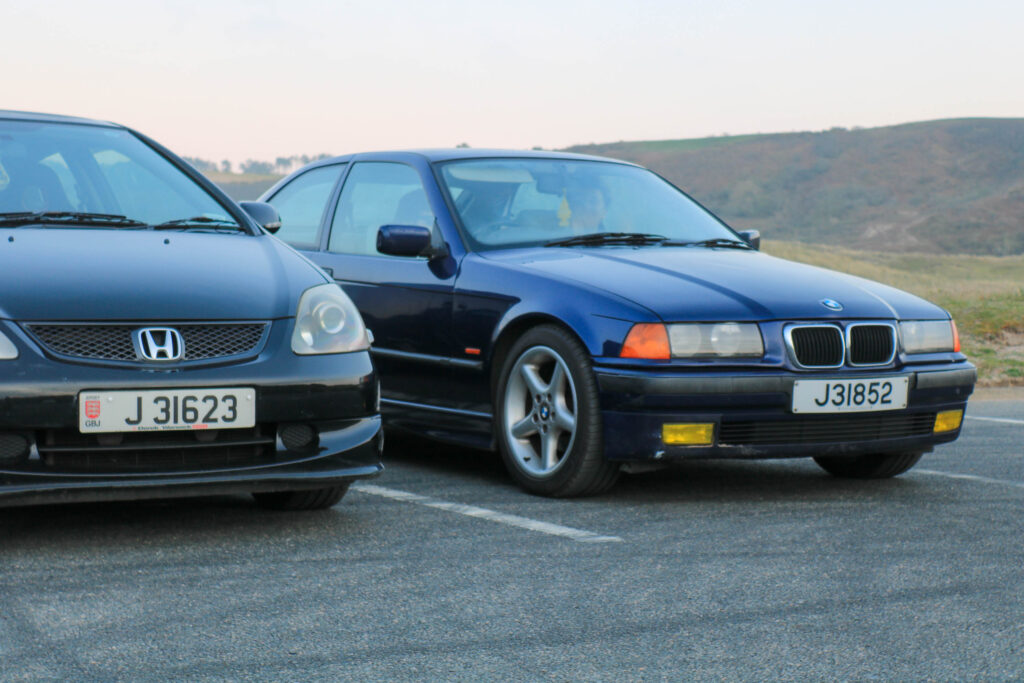
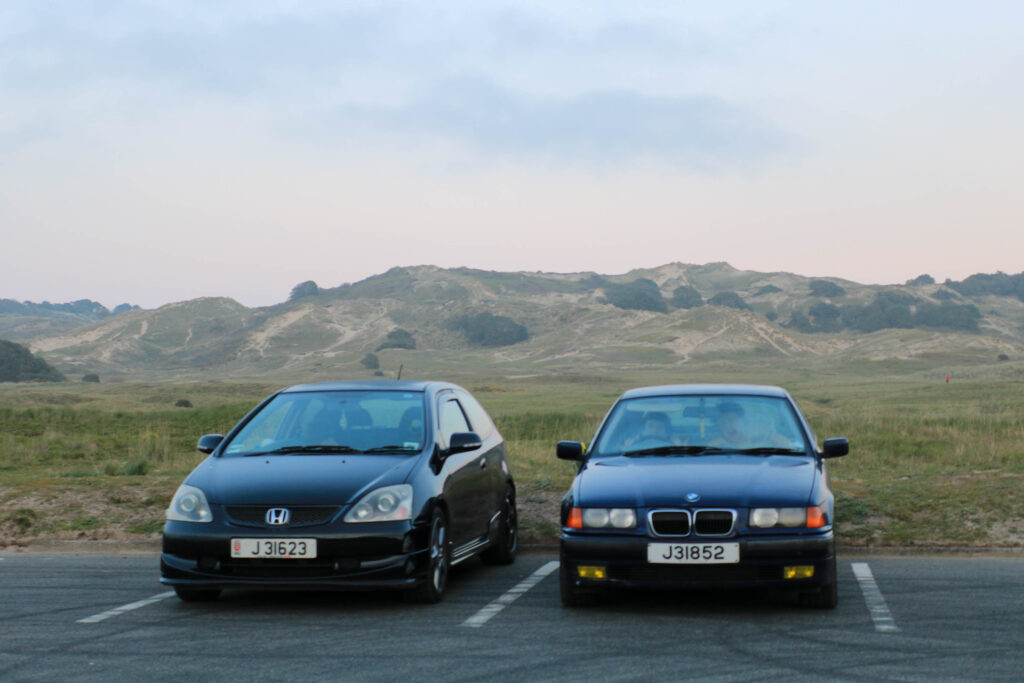
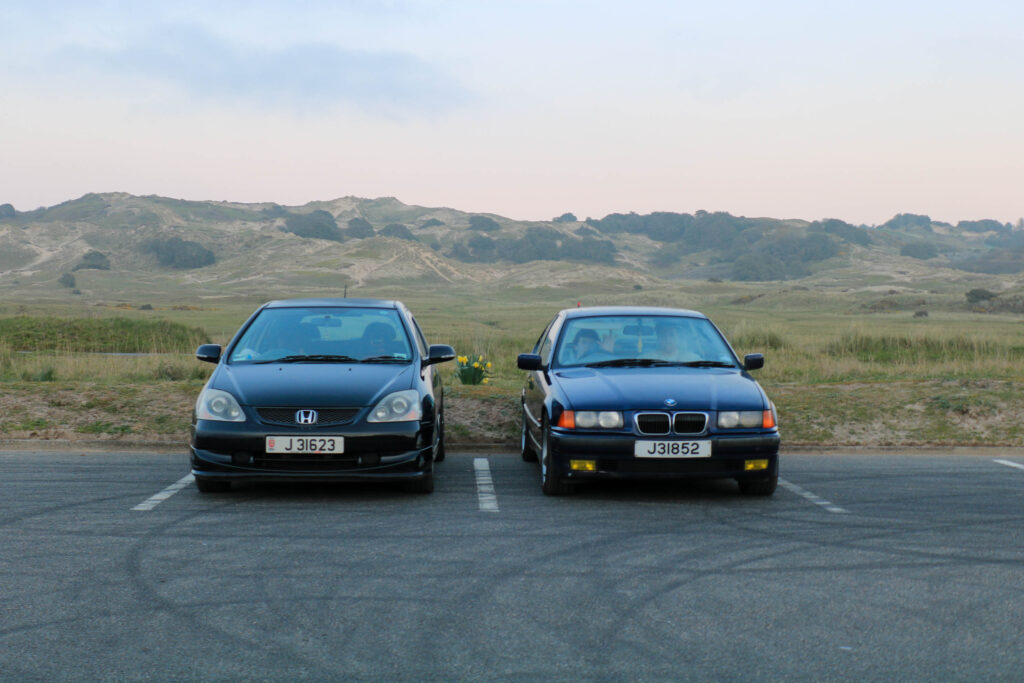
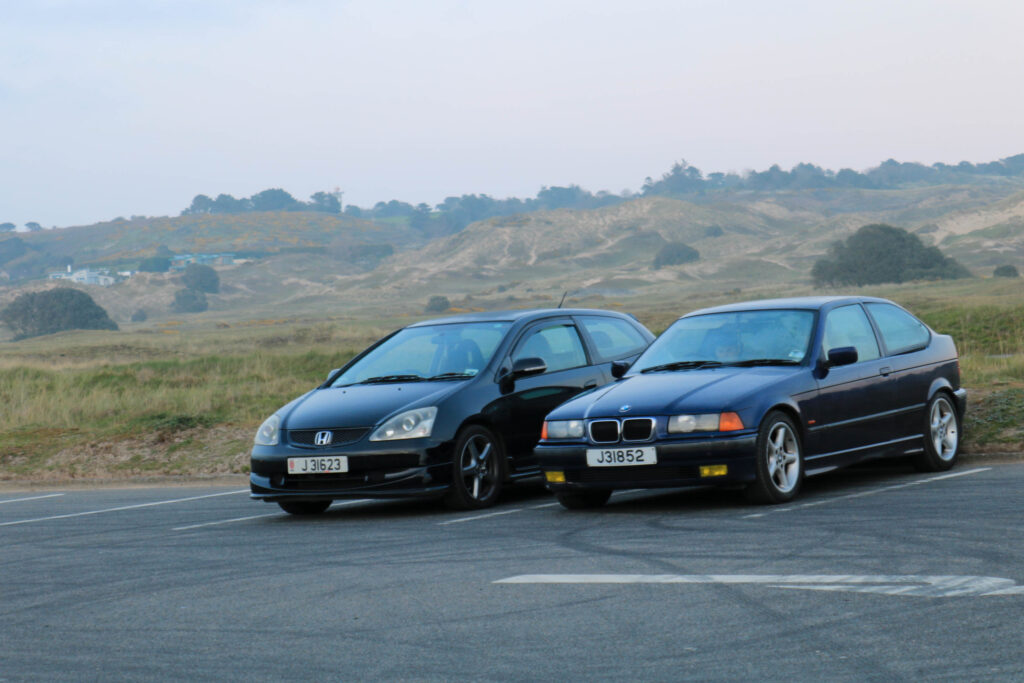
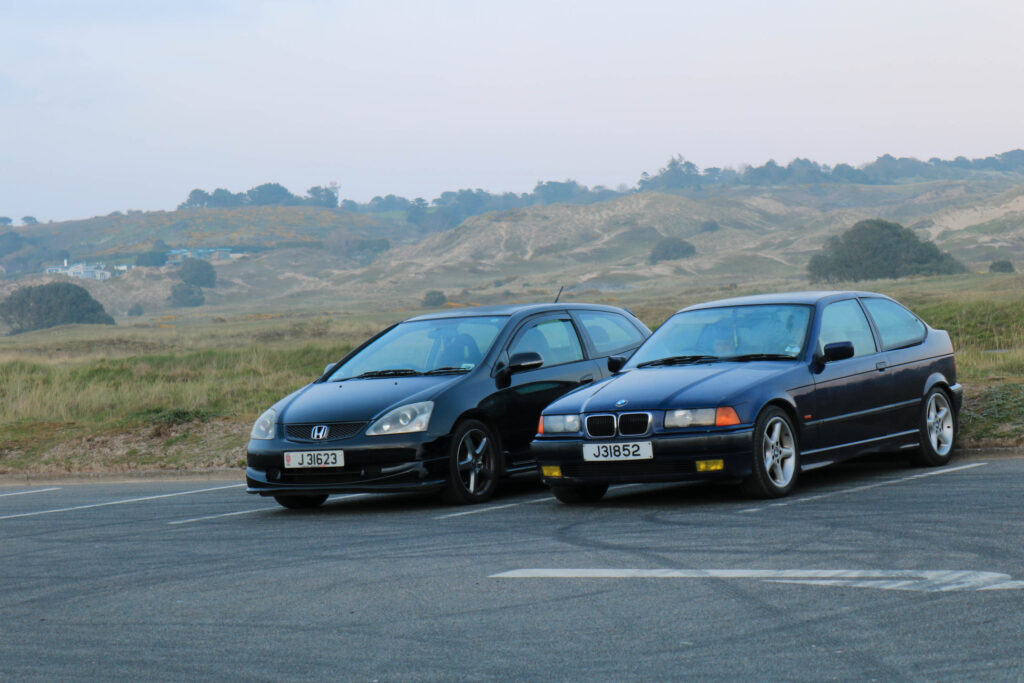
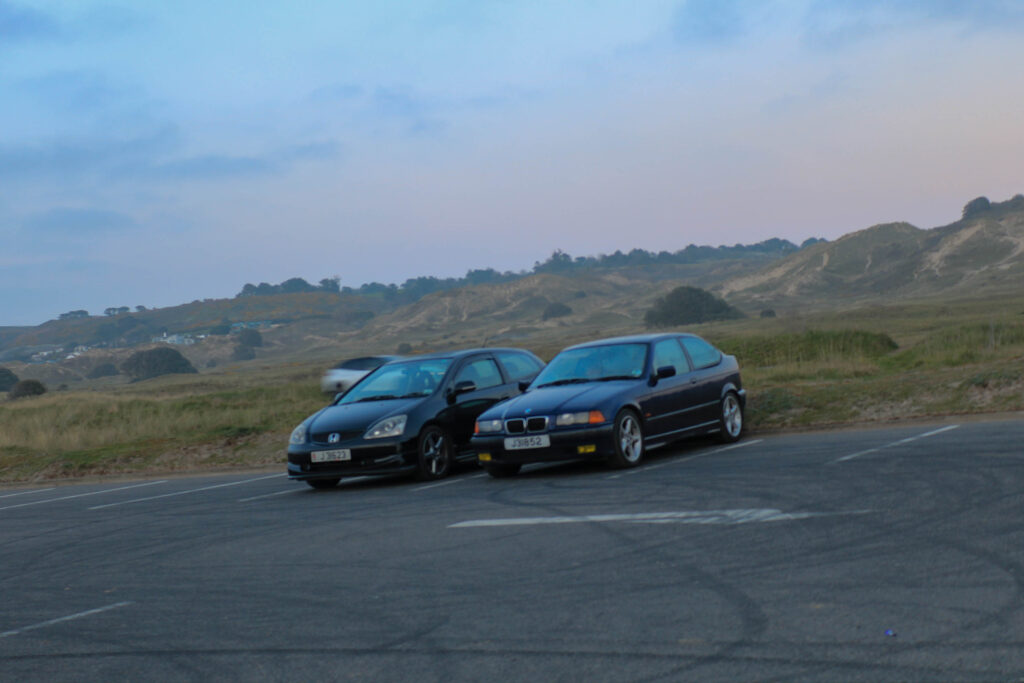
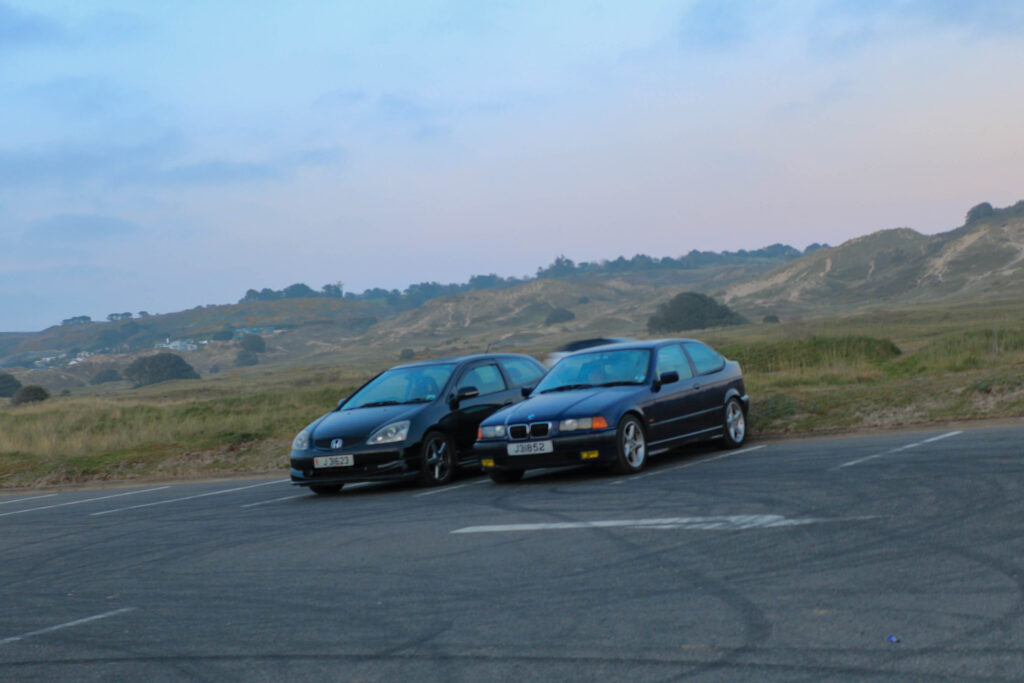
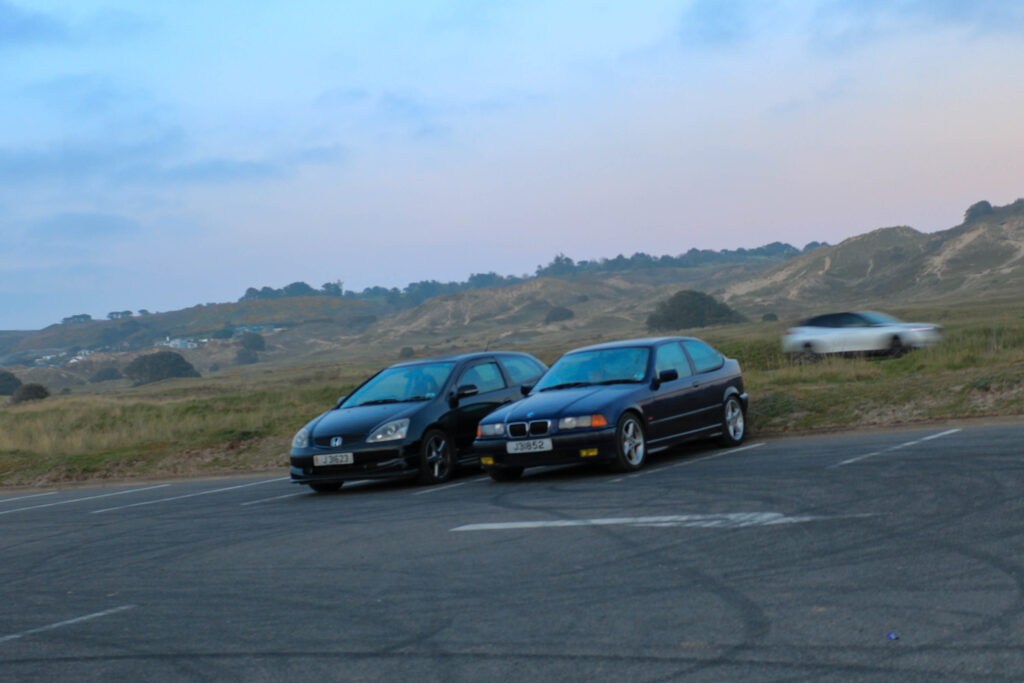
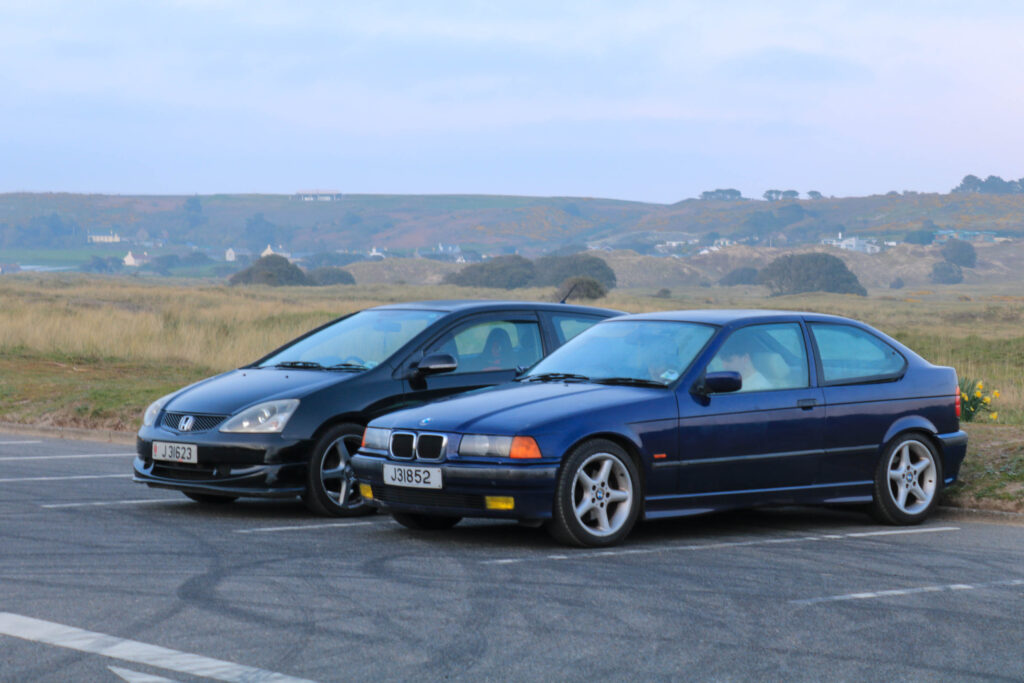
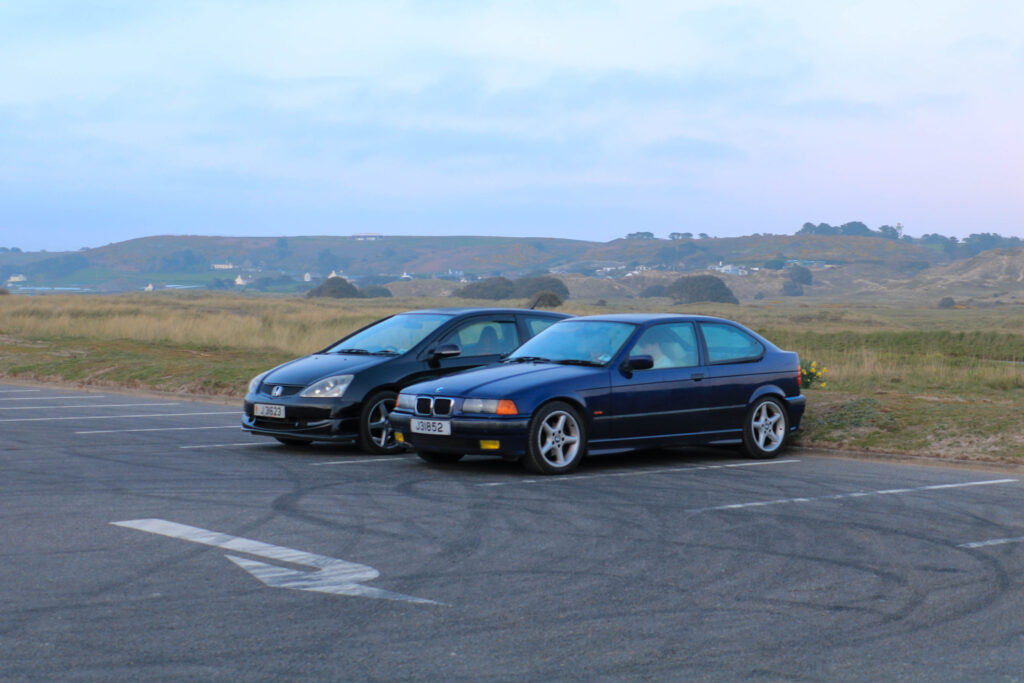
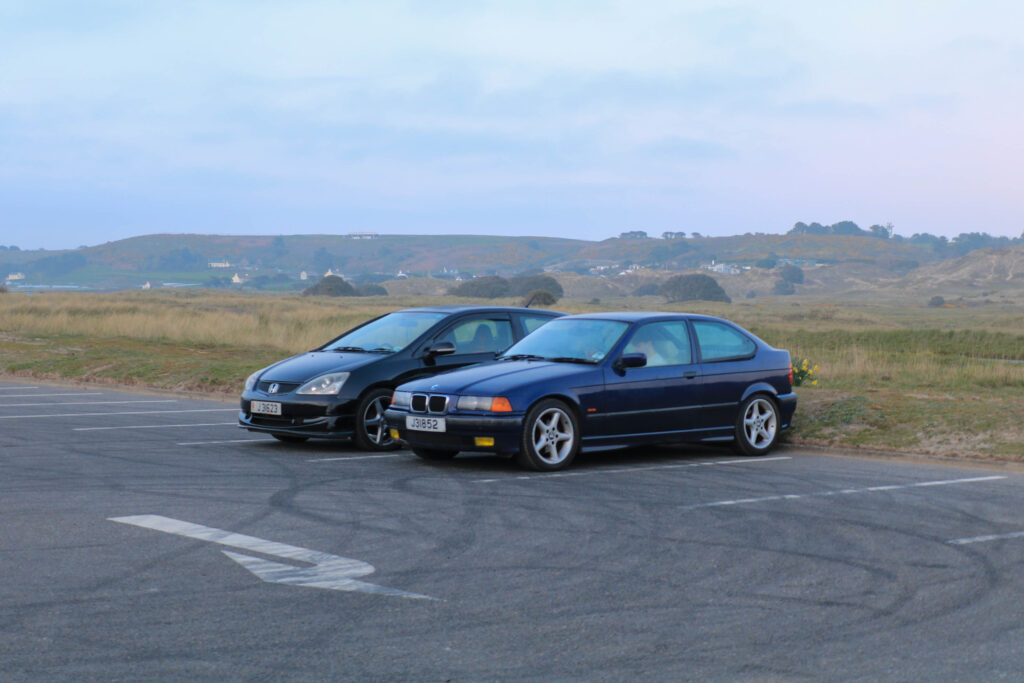
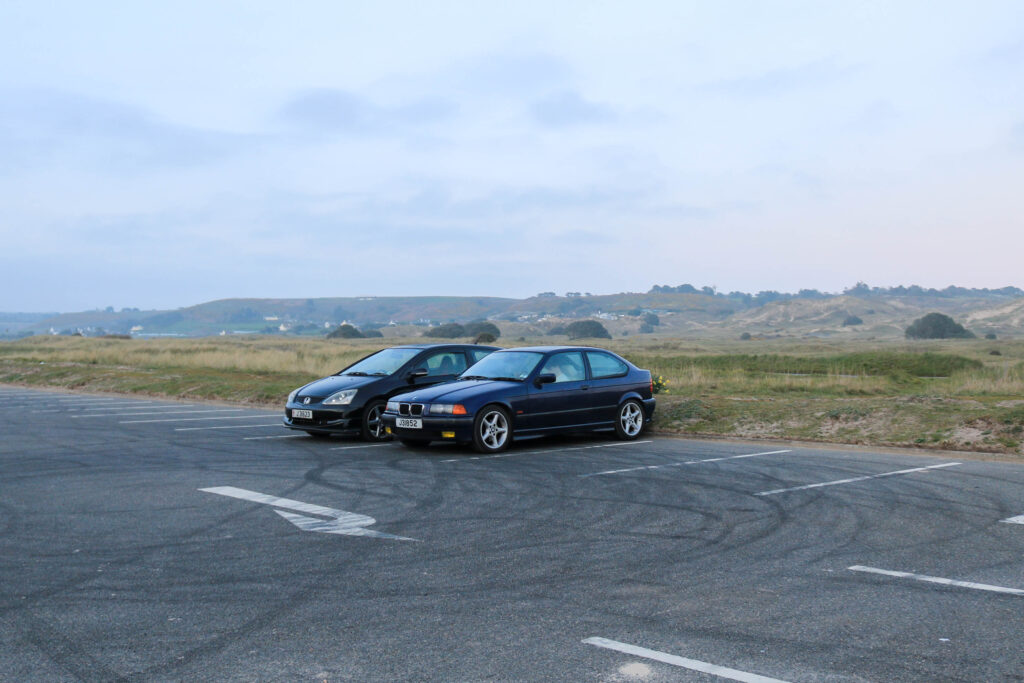
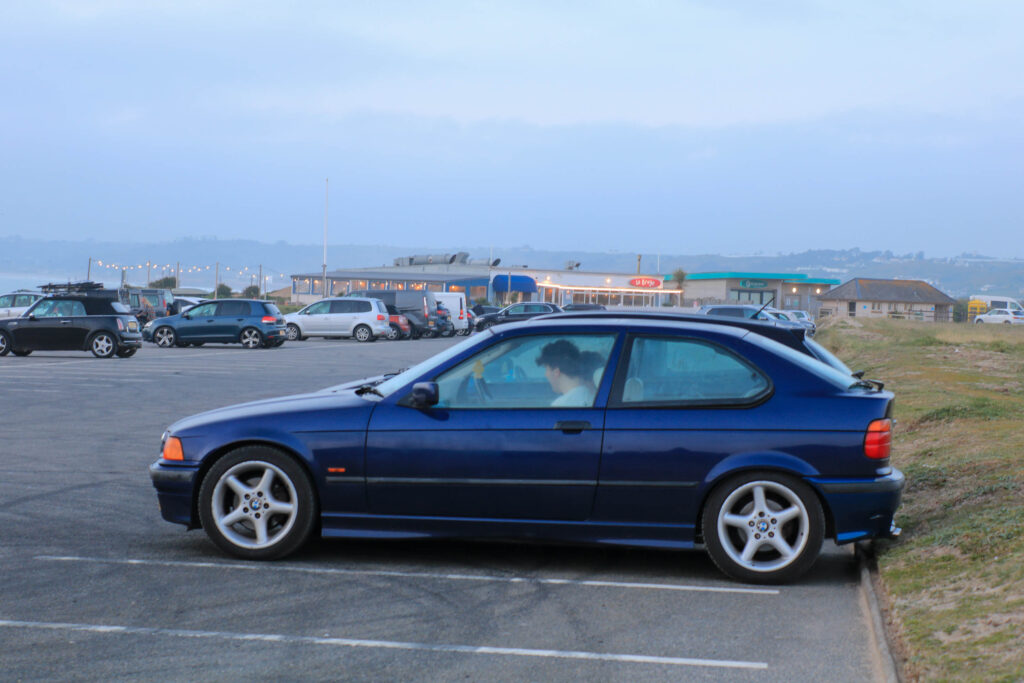

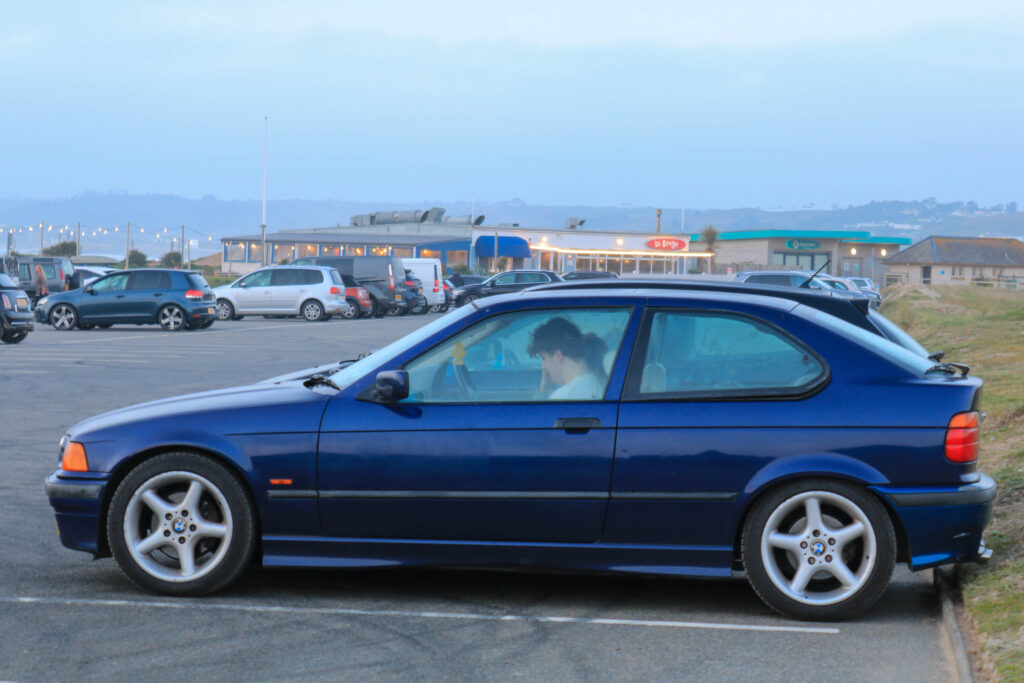
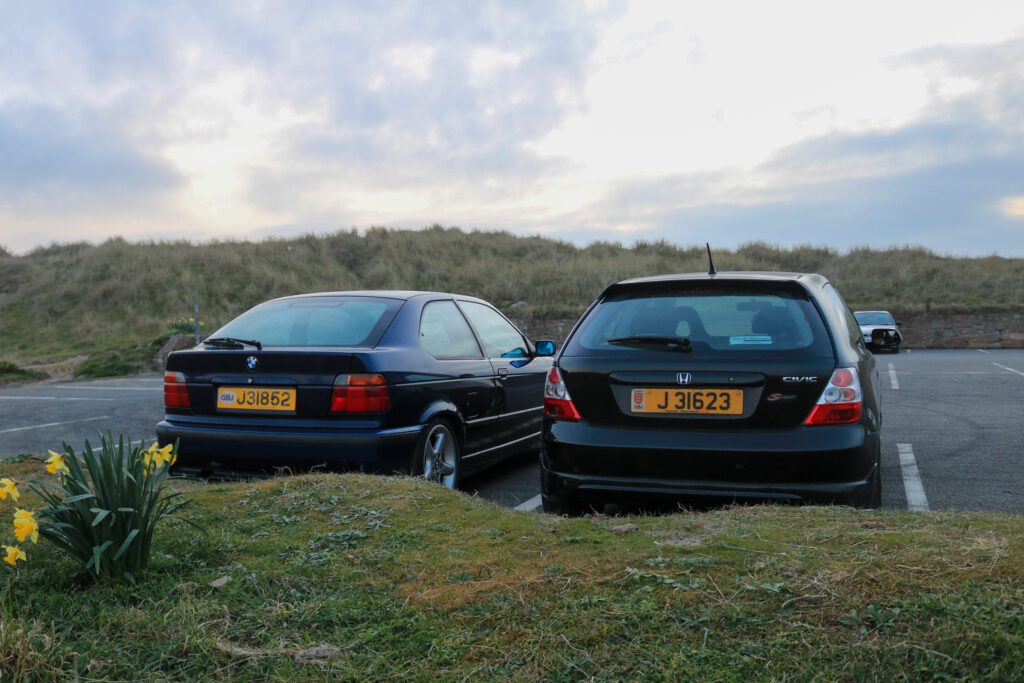
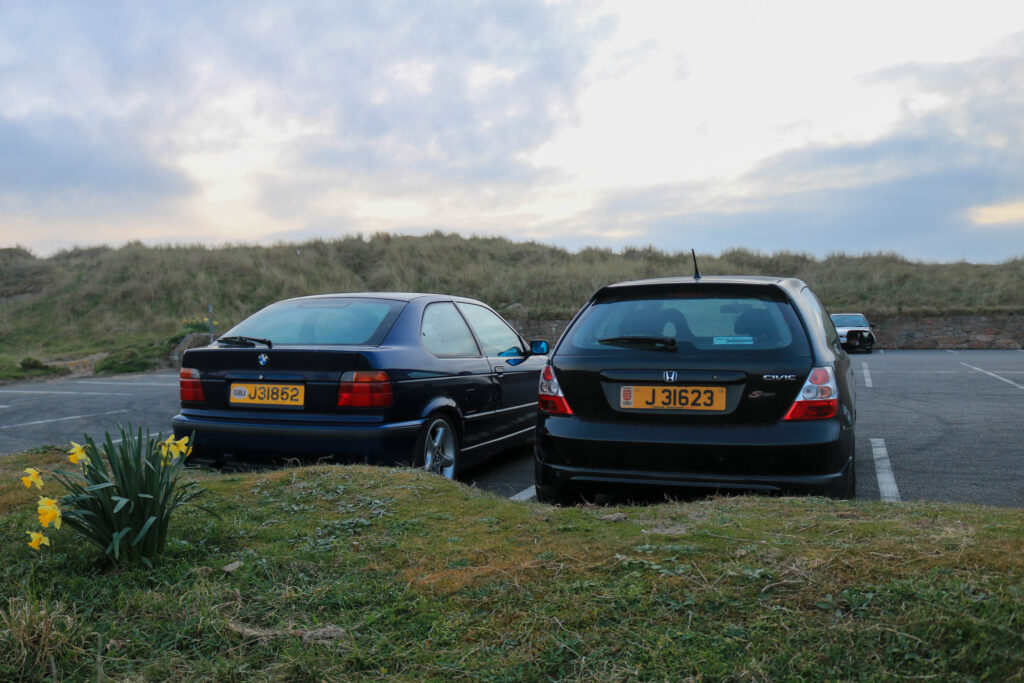
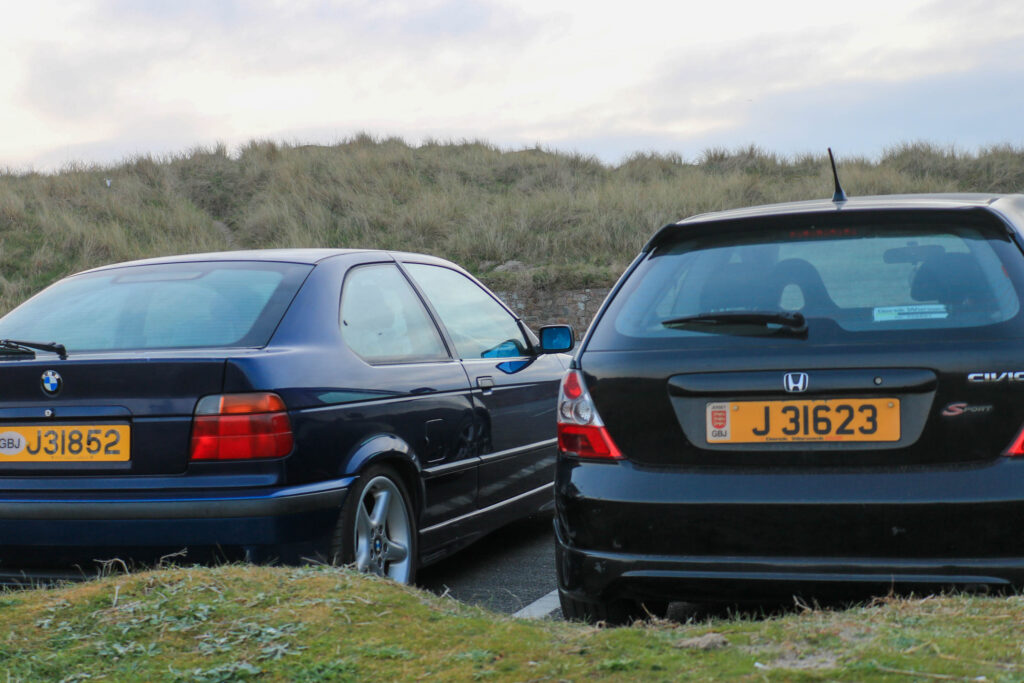
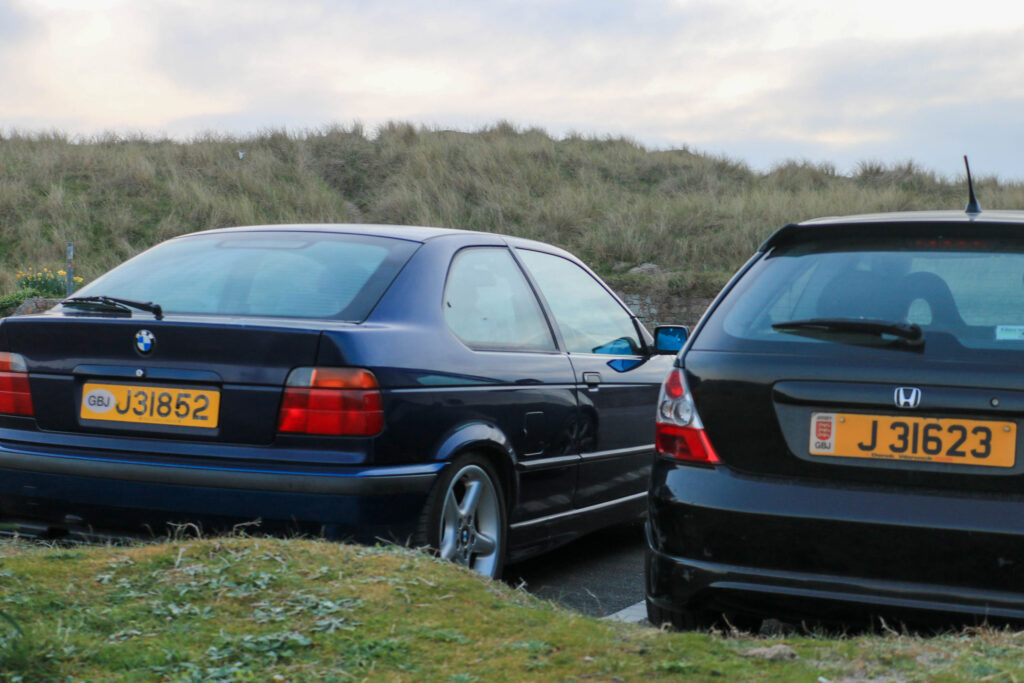
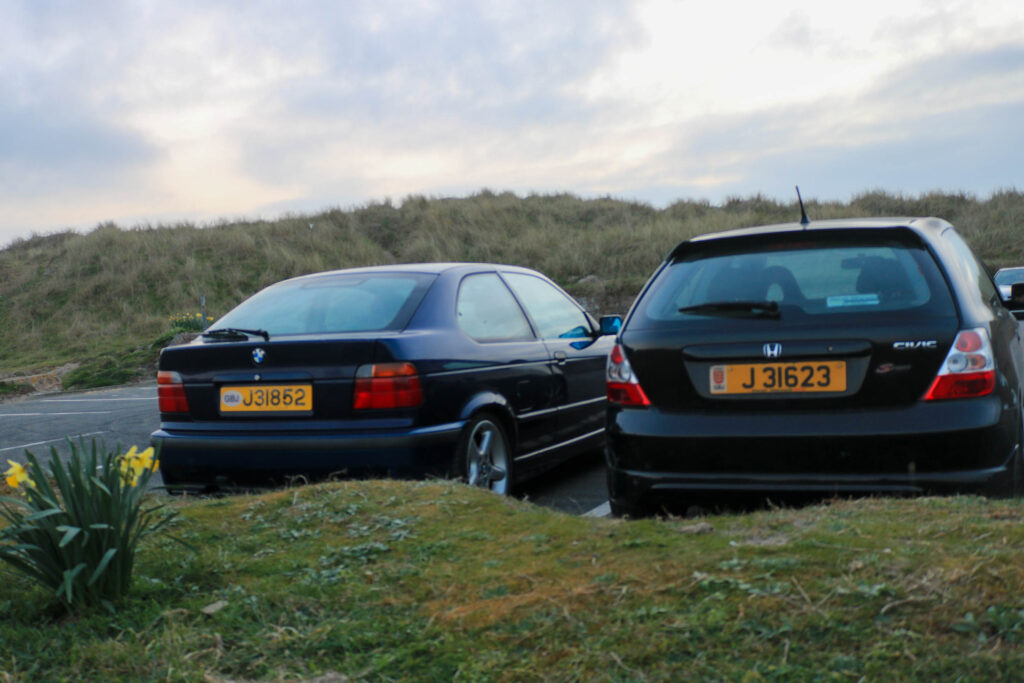
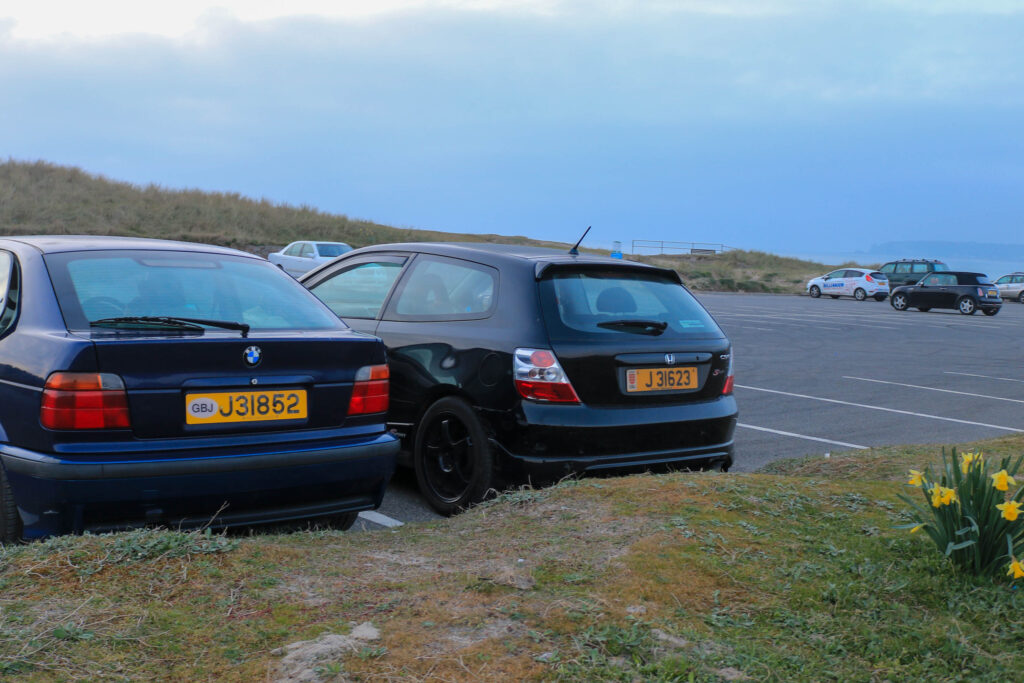
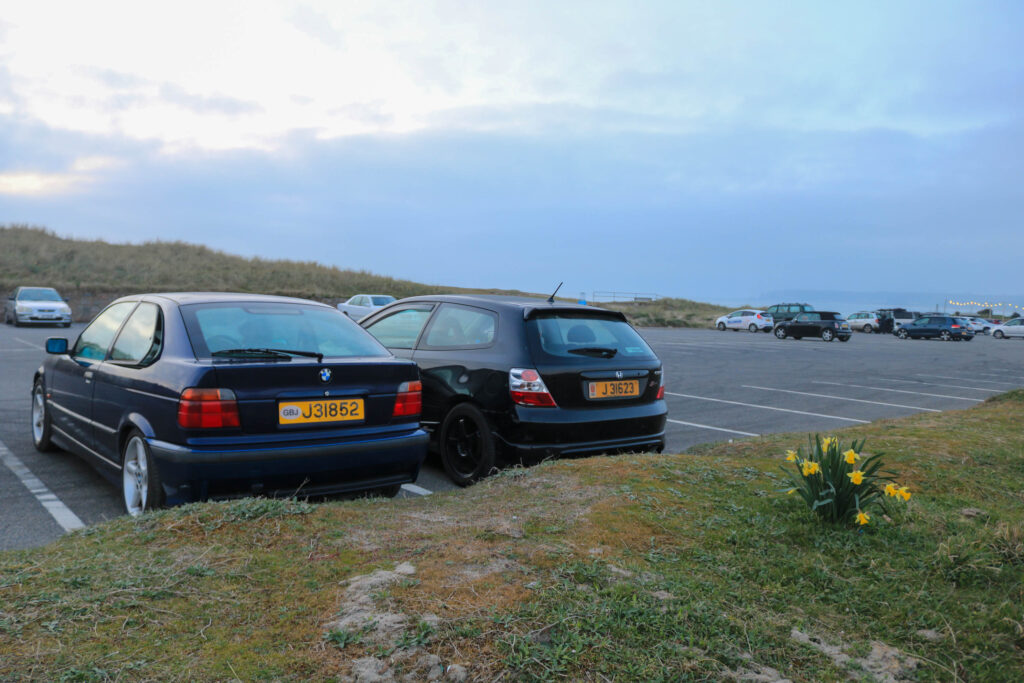

I want to make a short photobook, to link it to my film.
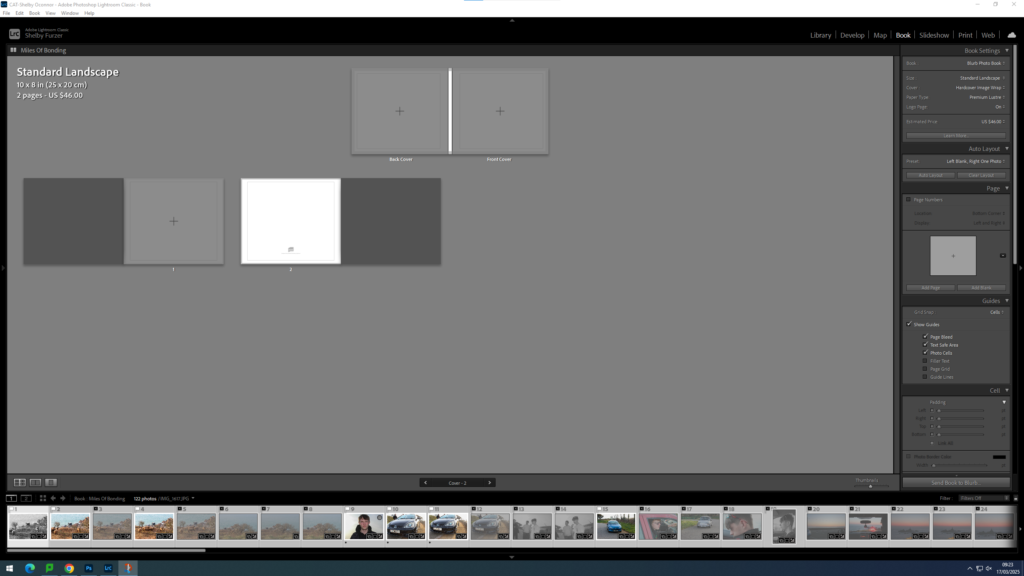
First I started by creating my book within lightroom. I did this by going into my union folder. Select all using ctrl A. Go back into top collections, create collection inside of union, seperate folder. Click book, create. Drag in new images and create save book. Blurb book- choose size- square- orientation and format. Hard cover wrap images. Premium paper. Name and title page? Maybe a short paragraph. Images are at the bottom can drop and drag them in, use zoom button and favorite different templates. Use right click too add pages.
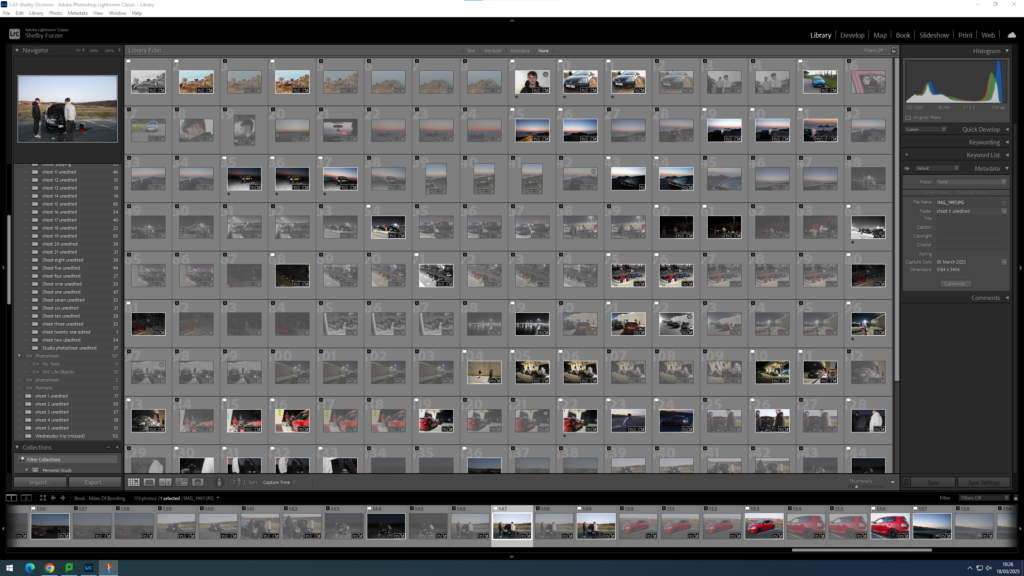
I made things easier for myself by flagging my images, allocating which ones I liked and which ones I didn’t.
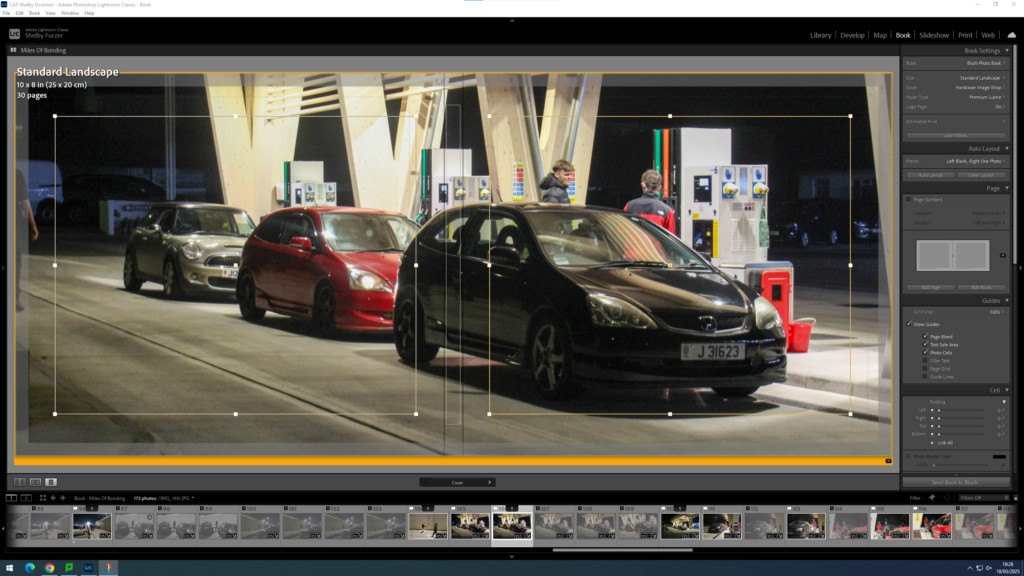
I then chose a main image for my front cover, I wanted it to be a wrapped image to create a more informal feel. And I know that I will still be taking more photos too add to my actual book.

I have made my title the same font as my intro to my short documentary in order to link the two together.
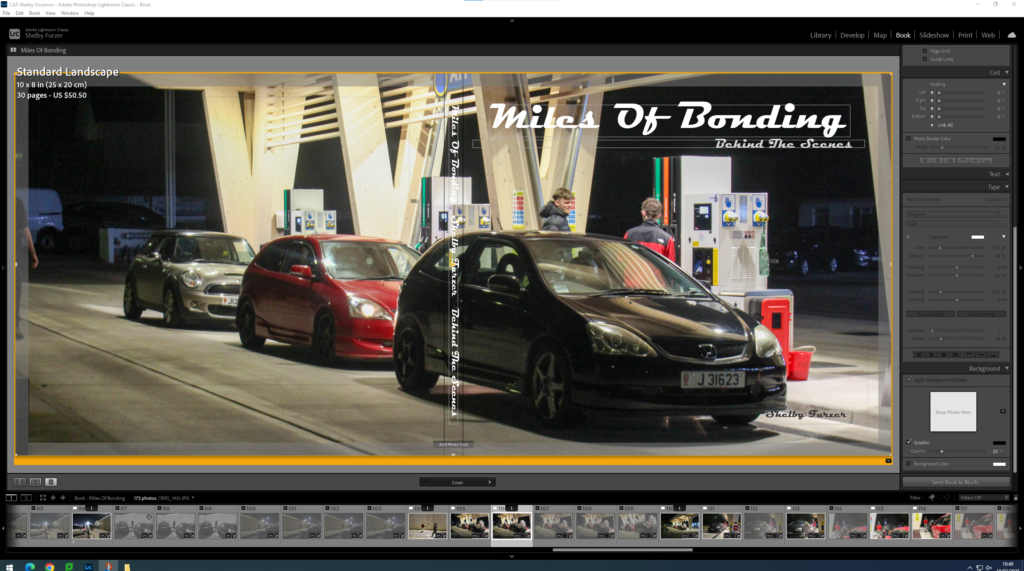
I then added all of my text onto the cover page, creating a final cover.

I then decided that my first page would be a text page, so I started mocking up different text pages.

I then came to the conclusion of this.
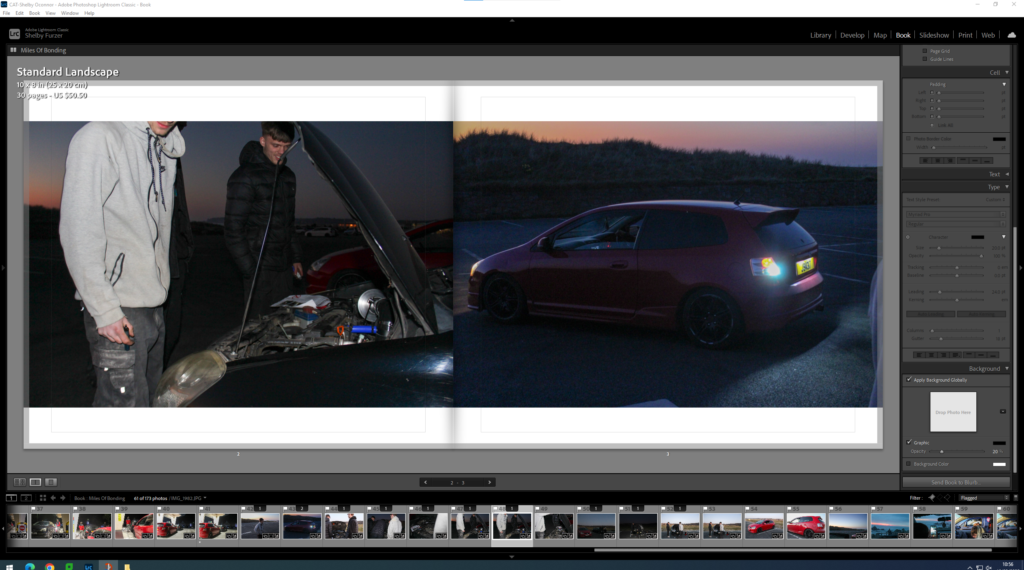
I wanted to start my photobook off with a darker tone, so that my photobook matches my documentary.
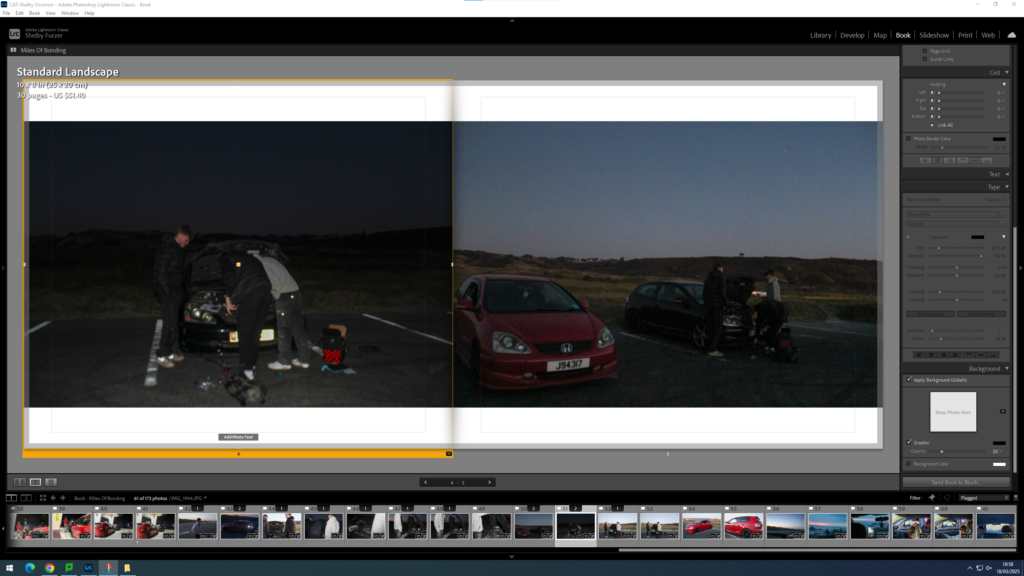

I wanted my images to contain a sequence, a set of four images and then a double page spread to break up the times of the day.
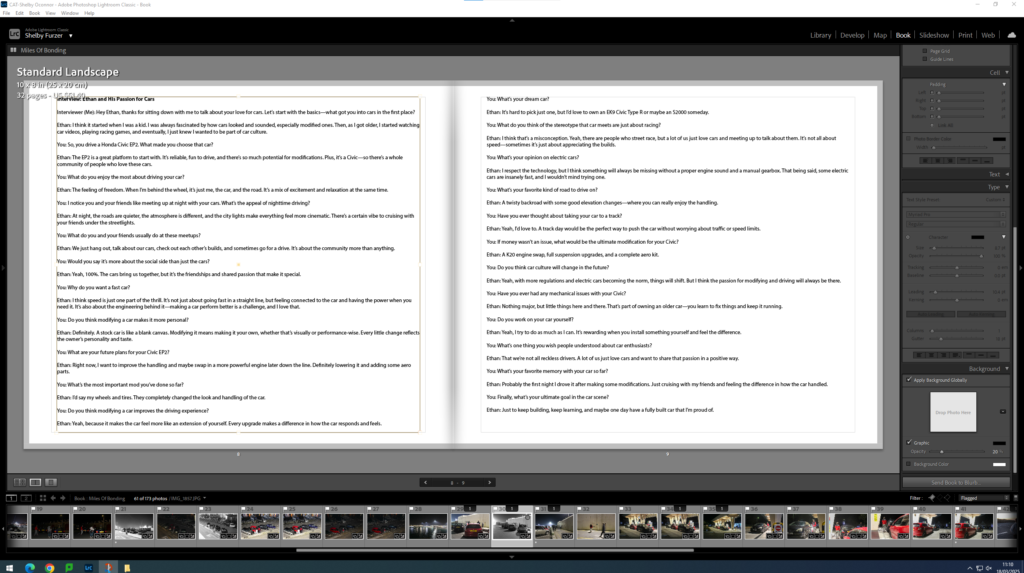
I interviewed one of the drivers within the image, I did this to break up my book, and add more context.

I then shifted my gaze, keeping the same sequencing, but adding a more sunset feel to it.

I then create a secondary interview, with the other person that I will interview for my short documentary.

I then finalised my book with the images that are more well lit.
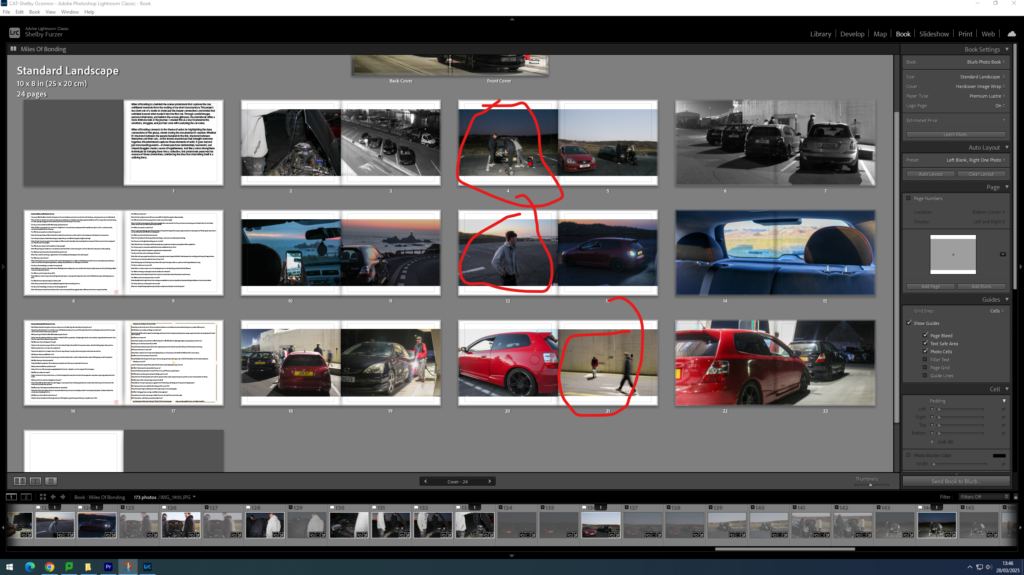
I have added an environmental approach to my photobook, by adding breaker images where they are actually engaging in something.

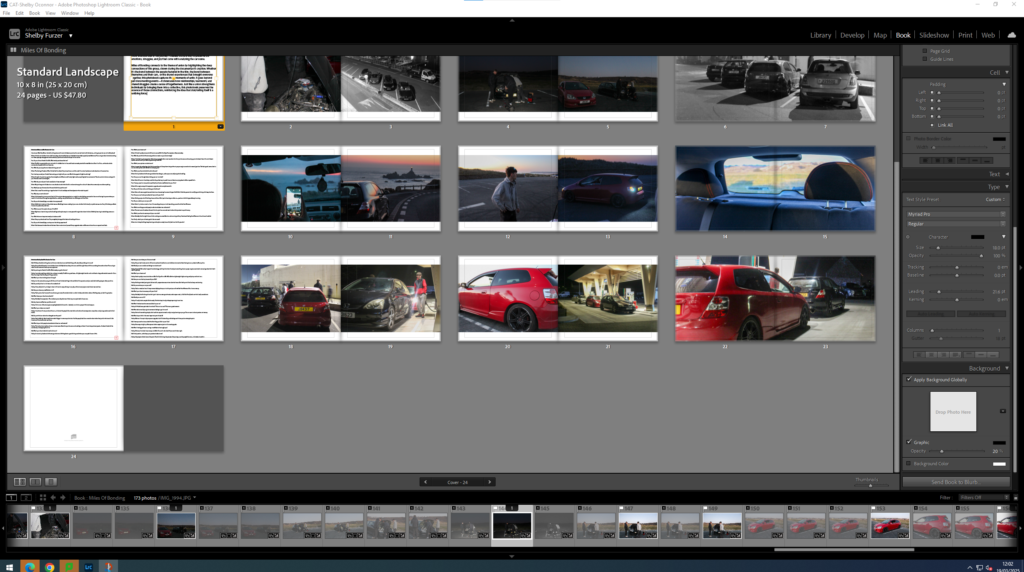
I then went into my premier short documentary and took screenshots of things that I think would fit within my book.
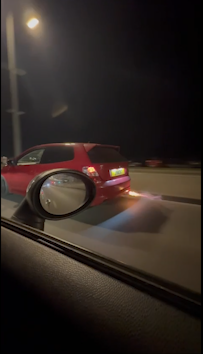
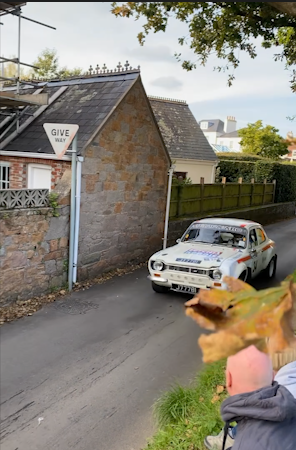
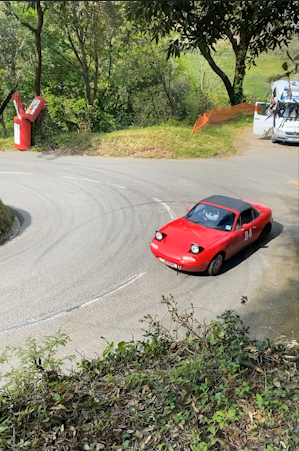
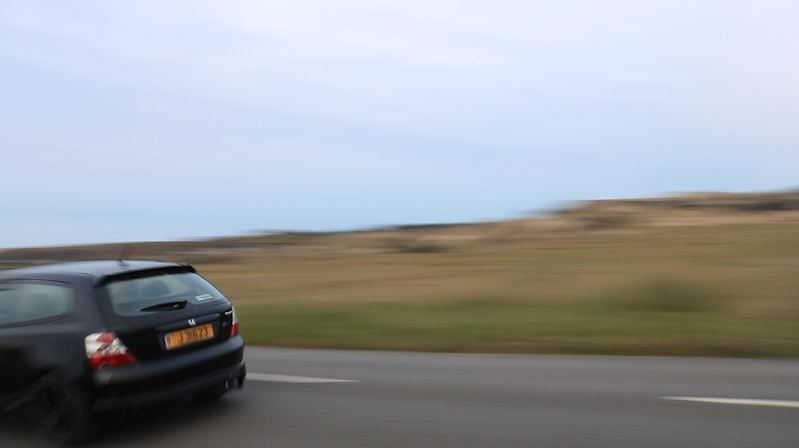
I did this to create a genuine behind the scenes feel.
I then played around to see how these images would look within my book.
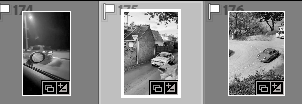
I didn’t really like how these images came out, they looked really pixelated, I think that it was a good experiment to see how these would’ve looked but I don’t think that the execution was good.

I then added another 6 pages from my latest photoshoot, and so that I would have enough room to add in another small interview.
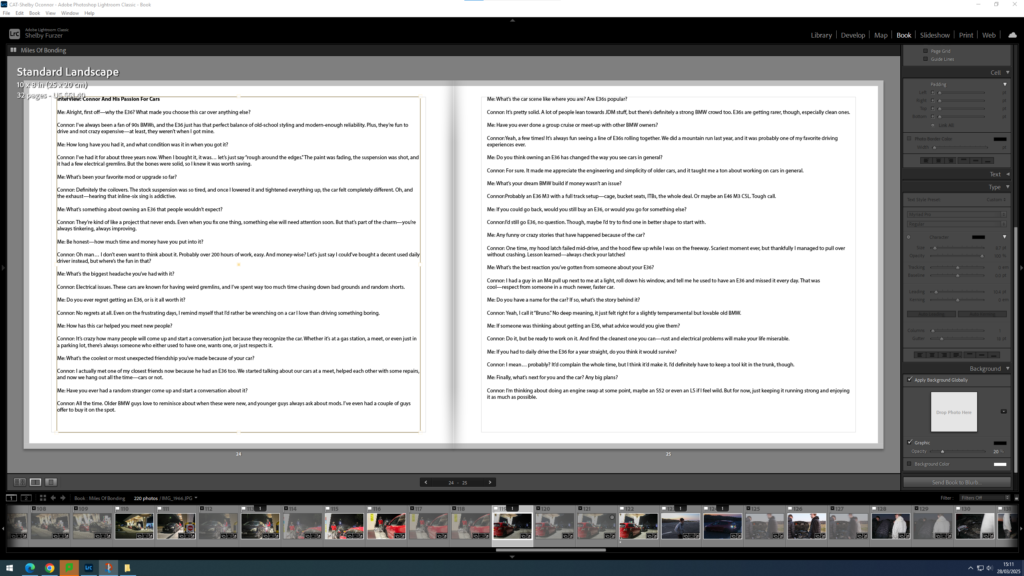
After looking at my book layout in full I decided to play around with the composition moving some images around a bit more.
W. Eugene Smith ‘His Photographers And Notes’
W. Eugene Smith’s “His Photographers and Notes” is a deeply personal and artistic exploration of his creative process, relationships with other photographers, and the thematic undercurrents in his work. W. Eugene Smith (1918–1978) was known for his work in photojournalism and for his dedication to capturing the emotional and humanistic aspects of his subjects. In “His Photographers and Notes”, Smith reflects on the stories behind the images he created and the process that shaped his iconic style.
Smith’s photography often focused on the raw, unfiltered aspects of human life. His photos depicted real people in real situations—often in times of crisis or profound emotional significance. “His Photographers and Notes” provides insight into how Smith sought to evoke deep emotional resonance through his work, highlighting the human condition with a powerful visual language. He strived to tell stories that went beyond the surface, pushing for empathy and understanding.
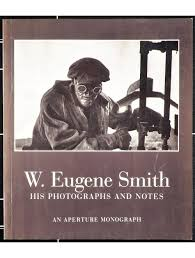
One of the most iconic images by W. Eugene Smith is his photograph “Tomoko Uemura in Her Bath” (1971), which is part of his larger photo essay on the Minamata disease in Japan. This photograph is one of Smith’s most powerful images, encapsulating the emotional and social impact of the industrial disaster caused by mercury poisoning.
The composition of this photograph is both simple and intense. The image features Tomoko, with her mother holding her in a bath, gazing directly at the camera. The image is intimate, capturing the deep vulnerability of Tomoko, whose condition is a tragic consequence of the industrial contamination.
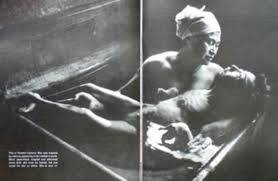
Mary Ellen Mark ‘The Photo Essay’
Mary Ellen Mark was a renowned American photographer known for her deeply empathetic and insightful photo essays, which often focused on marginalized communities and individuals. Her work captured moments of human vulnerability, resilience, and complexity, often highlighting social issues and personal struggles. One of her most celebrated photo essays is “Streetwise” (1984), which documents the lives of homeless teenagers in Seattle.
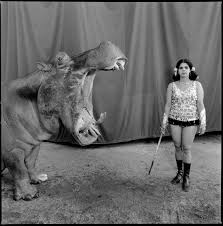
One of Mary Ellen Mark’s most iconic images is “Tiny, Seattle, 1983” from her photo essay “Streetwise”, which documents the lives of homeless teenagers in Seattle. This photograph is often cited as one of her most powerful works, capturing both the rawness of a difficult life and the resilience of a young girl navigating it.
Mary Ellen Mark often used tight framing and close-up portraits in her work, and in this image, the composition is simple yet effective. Tiny is positioned centrally, allowing her to be the focal point of the image. Her face fills the frame, making it impossible to ignore her presence. There is no distraction from the background, which serves to emphasize her facial expression and the rawness of her situation.
